- Skip to primary navigation
- Skip to main content
- Skip to primary sidebar

Literature Circle Roles and Activities: The Ultimate Guide
Classroom Management , Literature Circles , Secondary Literacy
In my first few years of teaching, I was constantly looking for ways to improve literature circles. I wanted literature circle roles that were differentiated, but also engaging for my students. I wanted to instill responsibilities that would mirror the reading strategies we were developing in our reading curriculum. Last but not least, I wanted my students to take initiative and hold each other accountable. So I did my research, and I wound up with this guide to literature circles .
This blog post explores some frequently asked questions about literature circles . It also shares activities and strategies for leading literature circles with older students, including engaging roles for literature circles .
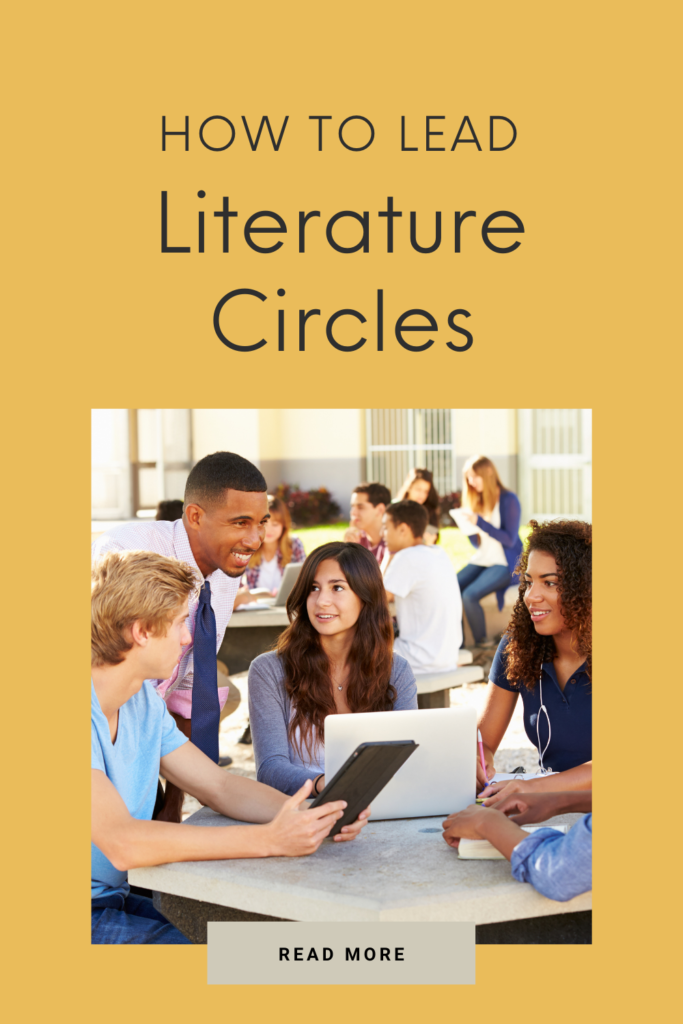
Leading Literature Circles: Frequently Asked Questions
Do i need to pick books that i’ve read.
In order to assess students, it might seem like you’re responsible to read the book first. Thankfully, the answer is no – you do not need to pick books for literature circles that you’ve read! This is because the goal of literature circles is to facilitate peer-based learning . Since students will be learning from one another, it will not be your responsibility to guide them through the literary analysis.
How will I assess literature circles if I haven’t read the books?
The goal of peer-based learning is to have students build a shared understanding of the text . When assessing literature circles, determine what you think is important to evaluate. For example, if your curriculum is promoting higher-level thinking, then the goal is not for students to simply retell the story. This means you will not need to be able to re-tell it, either!
You can assess literature circles with one-pagers, overarching discussion questions , and final projects that require a strong understanding of the text. These assessments can focus on students’ critical thinking and text connections .
Here are some great resources for assessing literature circles :
- Elementary school (grades 4-6) : Draw from a number of student reflection and assessment one-pagers in this elementary school literature circles unit .
- Middle school (grades 6-8) : Prompt students to write a paragraph in which they reflect on their reading by writing a “ Retell, Relate, Reflect, Review” book report .
- High school (grades 9-12) : Have students focus on the theme and characterization within the novel by creating a movie trailer . Students can also explore different inquiry-based literature circle roles using this high school literature circles unit .
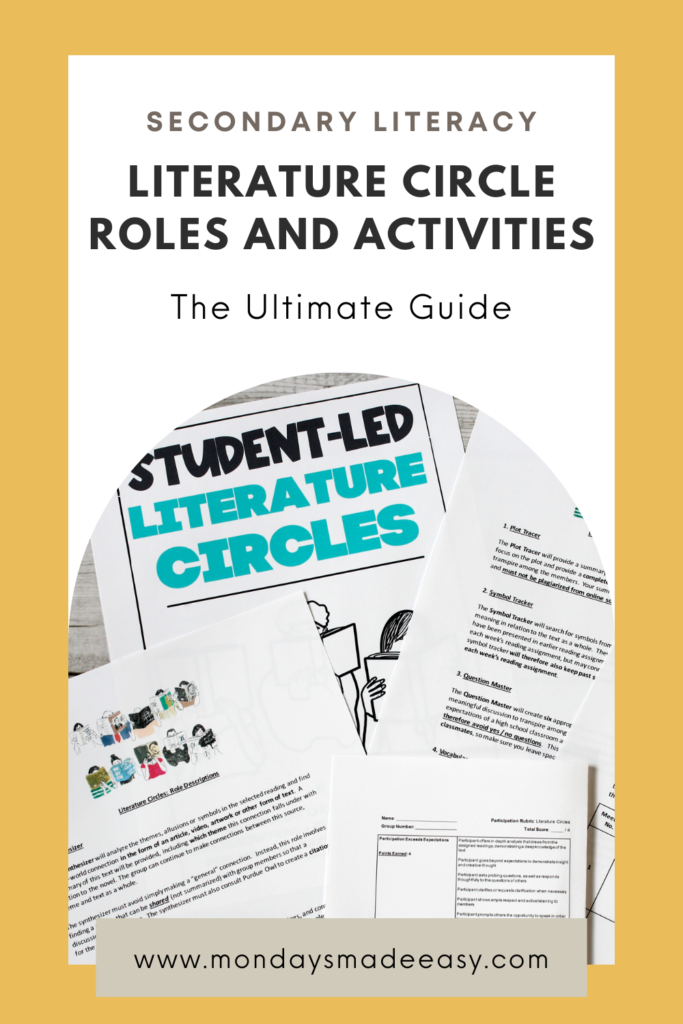
Do students need literature circle roles?
There is truly no right answer to this question. The benefits of liteature circle roles are that they offer structure, promote responsibility (which may improve attendance), and practice different reading strategies .
The disadvantage to literature circle roles is that they may stifle conversation and creativity ; a study from the Journal of Adolescent and Adult Literacy reported that students would read responses from their role sheets and “[did] not react to each other or question each other; instead, they simply [gave] each other their answers.”
If you are finding that your students are stifled by roles, the alternative would be to teach them how to lead their own group discussions . To do so, you can use a group discussion outline with stentence stems and self-assessment tools. Students can rotate through the role of notating the discussion with their peers. Through modelling this process, students can sucessfully take on the resposibility of leading and documenting their discussions.
My students are all at different reading levels. Should I still use literature circles?
Yes! Research from the International Reading Association concluded that literature circles are a great strategy for neurodivergent students, struggling readers, and accelerated learners alike .
How do you organize literature circle meetings?
You can use a graphic organizer to schedule literature circle meetings ; this graphic organizer can also indicate which reading assignments need to be completed for which meeting. I instruct students to divide the page number of their novel by the number of meetings within the graphic organizer. Students can use that as a guideline to establish how many chapters will be covered in each reading assignment.
Students can then note the literature circle roles for each week in the graphic organizer. I have every student fill out the graphic organizer so that they all know their role for each meeting.
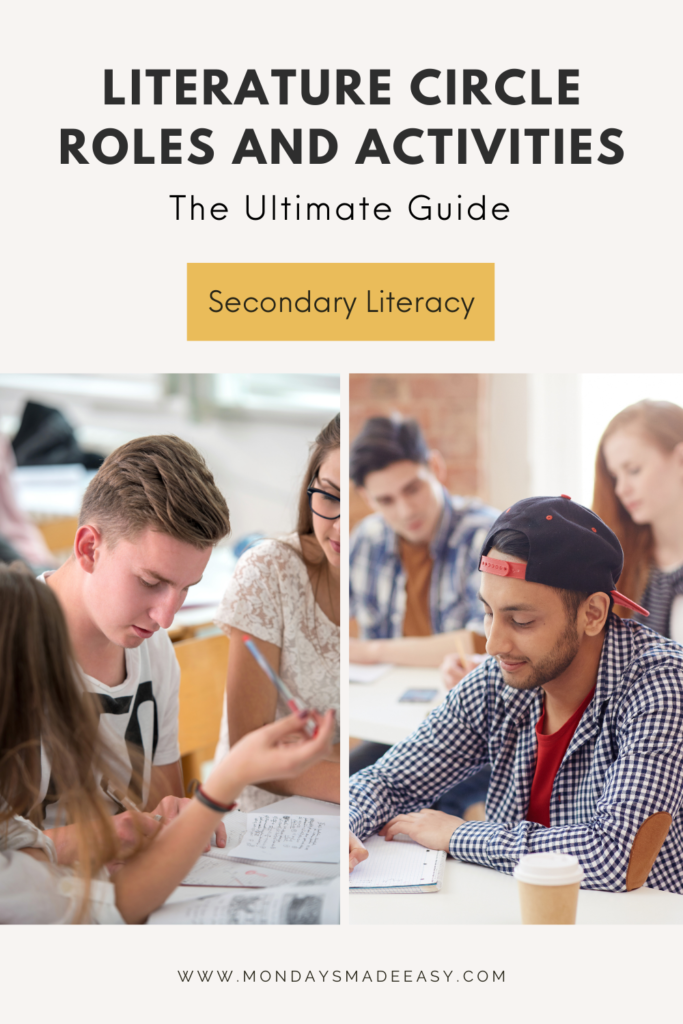
Can students complete the same literature circle roles every week?
This depends on your students and the roles they wish to continually assume. Some roles, like the illustrator, are especially suitable for particular students. It may be a good opportunity for them to utilize their strengths . This is especially true if you are creating groups of students with diverse learning profiles.
In my classroom, I make them switch their roles each week. Even though they might not particularly love a role, it is beneficial for them to step outside of their comfort zone . It also avoids the predictability of completing the same tasks for each reading assignment.
How do teachers assign grades for literature circles?
You can assign both a group grade and an individual grade for literature circles. The group grade can be based on group assignments and activities from literature circle meetings . You can use the group grade as the basis for adjusting individual grades for each student. These adjustments can be based on their performance during their literature circle roles. It can also include peer feedback from peer evaluation forms .
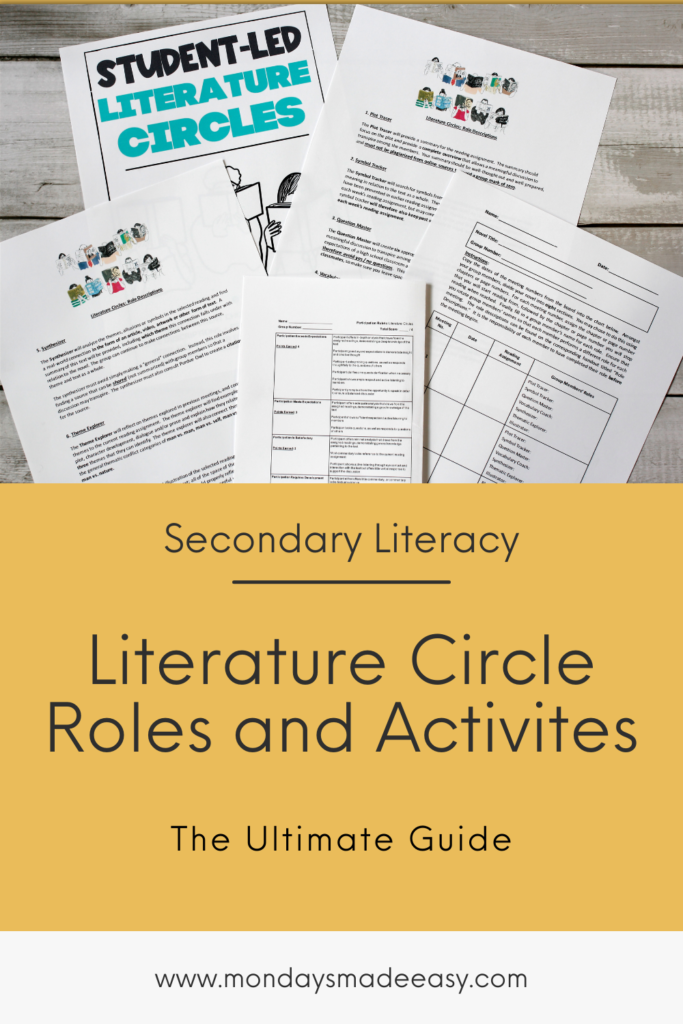
Wrapping up with Literature Circles
I like to finish my literature circle unit with a final project . An assignment that students really enjoy is creating movie trailers for their novels. This project is a great assessment because it prompts students to consider important elements of the novel , like characterization and theme. Since they don’t want to spoil the plot, it also encourages students to avoid simple summaries . As a bonus, showcasing these trailers also sparks extracurricular reading for students who are inspired by their classmates’ work.
If you’re just getting started with literature circles or are looking for more resources and activities to lead your unit, be sure to check out Mondays Made Easy’s Literature Circle Bundle . This bundle includes literature circle roles, rubrics, discussion activities, and the movie trailer project mentioned above.
Reader Interactions
[…] teaching literature circles or simply looking for a fresh approach, you may also be interested in The New Teacher’s Guide to Literature Circles on the Mondays Made Easy […]
[…] summative assessment for any novel. Furthermore, it serves as a fantastic summative assessment for literature circles or independent novel […]
Literature Circles: Getting Started
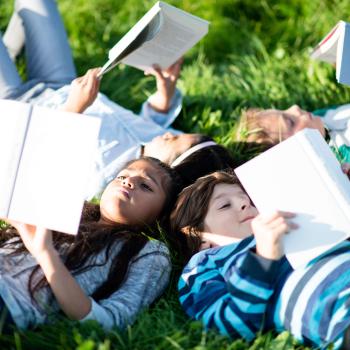
- Resources & Preparation
- Instructional Plan
- Related Resources
This lesson provides a basic introduction to literature circles, a collaborative and student-centered reading strategy. Students begin by selecting a book together then are introduced to the four jobs in the Literature Circles: Discussion Director, Literary Luminary, Vocabulary Enricher, and Checker. The teacher and student volunteers model the task for each of the four roles, and then students practice the strategies. The process demonstrates the different roles and allows students to practice the techniques before they are responsible for completing the tasks on their own. After this introduction, students are ready to use the strategy independently, rotating the roles through four-person groups as they read the books they have chosen. The lesson can then be followed with a more extensive literature circle project.
Featured Resources
Self-Reflection: Taking Part in a Group Interactive : Using this online tool, students describe their interactions during a group activity, as well as ways in which they can improve. Students can add rows and columns to the chart and print their finished work.
From Theory to Practice
Literature circles are a strong classroom strategy because of the way that they couple collaborative learning with student-centered inquiry. As they conclude their description of the use of literature circles in a bilingual classroom, Peralta-Nash and Dutch explain the ways that the strategy helped students become stronger readers:
Students learned to take responsibility for their own learning, and this was reflected in how effectively they made choices and took ownership of literature circle groups. They took charge of their own discussions, held each other accountable for how much or how little reading to do, and for the preparation for each session. The positive peer pressure that the members of each group placed on each other contributed to each student's accountability to the rest of the group. (36)
When students engage with texts and one another in these ways, they take control of their literacy in positive and rewarding ways.
Further Reading
Common Core Standards
This resource has been aligned to the Common Core State Standards for states in which they have been adopted. If a state does not appear in the drop-down, CCSS alignments are forthcoming.
State Standards
This lesson has been aligned to standards in the following states. If a state does not appear in the drop-down, standard alignments are not currently available for that state.
NCTE/IRA National Standards for the English Language Arts
- 1. Students read a wide range of print and nonprint texts to build an understanding of texts, of themselves, and of the cultures of the United States and the world; to acquire new information; to respond to the needs and demands of society and the workplace; and for personal fulfillment. Among these texts are fiction and nonfiction, classic and contemporary works.
- 2. Students read a wide range of literature from many periods in many genres to build an understanding of the many dimensions (e.g., philosophical, ethical, aesthetic) of human experience.
- 3. Students apply a wide range of strategies to comprehend, interpret, evaluate, and appreciate texts. They draw on their prior experience, their interactions with other readers and writers, their knowledge of word meaning and of other texts, their word identification strategies, and their understanding of textual features (e.g., sound-letter correspondence, sentence structure, context, graphics).
- 7. Students conduct research on issues and interests by generating ideas and questions, and by posing problems. They gather, evaluate, and synthesize data from a variety of sources (e.g., print and nonprint texts, artifacts, people) to communicate their discoveries in ways that suit their purpose and audience.
- 9. Students develop an understanding of and respect for diversity in language use, patterns, and dialects across cultures, ethnic groups, geographic regions, and social roles.
- 11. Students participate as knowledgeable, reflective, creative, and critical members of a variety of literacy communities.
- 12. Students use spoken, written, and visual language to accomplish their own purposes (e.g., for learning, enjoyment, persuasion, and the exchange of information).
Materials and Technology
Multiple copies of literature books
- Literature Circle Roles
- Discussion Director
- Vocabulary Enricher
- Literary Luminary
- Literature Circle Process
- Self-Reflection: Taking Part in a Group (optional instead of online version)
Preparation
- Review the basic literature circle strategy, using the Websites linked in the Resources section. Before you begin the lesson, you should have a strong working knowledge of how the strategy works.
- Preview and read the books that students will choose among for this lesson so that you are familiar with the plot and literary elements. According to Hill, Johnson and Noe (1995), it is best to choose books that arouse emotions, are well-written, and are meaningful (113). The books should reflect students' reading levels as well. Gather copies of the books for each student group.
- If desired, make overhead transparencies of the Literature Circle Roles and Literature Circle Process . Alternately, you might write the information on chart paper or the board.
- Make copies of the Literature Circle Role Sheets ( Discussion Director , Vocabulary Enricher, Literary Luminary , and Checker ) for students to use independently and as they practice. Overhead transparencies of the forms may also be useful as the class explores the requirements of each task.
- Make copies of the Self-Reflection Worksheet , or if students will complete the self-reflection online, test the Online Self-Reflection Checklist on your computers to familiarize yourself with the tool and ensure that you have the Flash plug-in installed. You can download the plug-in from the technical support page.
Student Objectives
Students will
- discuss, define, and explore unfamiliar words.
- predict text events using previous knowledge and details in the text.
- use evidence in text to verify predictions.
- ask relevant and focused questions to clarify understanding.
- respond to questions and discussion with relevant and focused comments.
- paraphrase and summarize information from the text.
- identify and analyze literary elements in text.
Session One
- Introduce literature circles by explaining they are "groups of people reading the same book and meeting together to discuss what they have read" (Peralta-Nash and Dutch 30).
- Emphasize the student-centered collaborative nature of the reading strategy by discussing how the strategy places students "in charge of leading their own discussions as well as making decisions for themselves" (Peralta-Nash and Dutch 30). Share some of the ways that students will work independently (e.g., choosing the text the group will read, deciding on the questions that the group will discuss about the text).
Discussion Director creates questions to increase comprehension asks who, what, why, when, where, how, and what if Vocabulary Enricher clarifies word meanings and pronunciations uses research resources Literary Luminary guides oral reading for a purpose examines figurative language, parts of speech, and vivid descriptions Checker checks for completion of assignments evaluates participation helps monitor discussion for equal participation
- Preview the way that literature circles work for students, sharing the Literature Circle Process on the overhead projector or chart paper. Alternately, pass out copies for students to refer to.
- Explain that the class will practice each of the roles before students try the tasks on their own.
- Choose a short book with at least eight chapters to read as a whole class, beginning during the next class session.
Session Two
- Review basic information about literature circles.
- Explain that during this session, you will act as the Discussion Director to demonstrate how to do the task.
- creates questions to increase comprehension
- asks who, what, why, when, where, how, and what if
- Pass out copies of the Discussion Director role sheet and preview the information it contains.
- Read Chapter 1 of the text chosen during the previous session together.
- Demonstrating the Discussion Director Role, pause during the reading, as appropriate, to add details to the Discussion Director role sheet; or complete the Discussion Director role sheet after the reading is complete.
- Re-read the questions on the Discussion Director role sheet and make any revisions.
- Demonstrate how the Discussion Director would use the Discussion Director role sheet to lead discussion.
- Allow time to discuss the first chapter freely in order to show how discussion of questions and ideas that are not on the sheet is also appropriate.
- After discussion is complete, ask students to make observations about how the Discussion Director role works. Answer any questions that they have about the role.
Session Three
- Have students get out copies of the Discussion Director role sheet and review the information it contains.
- Explain that during this session, everyone will have a chance to practice being a Discussion Director.
- Ask students to recall how you recorded information on the Discussion Director role sheet during the previous session in order to establish the expectations for this session.
- Read Chapter 2 of the text together.
- Working in the Discussion Director Role, have students pause during the reading to add details to their copies of the Discussion Director role sheet; or complete the Discussion Director role sheet after the reading is complete.
- After the chapter has been read, have students re-read the questions on the Discussion Director role sheet and make any revisions.
- Arrange the class in small groups of 4-6 students each. These groups are simply for practice, so they can be formed informally if desired.
- Explain that each group member will serve as the Discussion Director for about 5 minutes.
- To make sure the process runs smoothly, have group members arrange turn-taking by deciding who will go first, second, third, and so forth.
- Have the first Discussion Director begin discussion. Watch the time so that you can cue students to change roles. Provide support and feedback as appropriate.
- After 5 minutes have passed, ask the second person take over as Discussion Director.
- Repeat this process until everyone in the class has had a chance to practice the Discussion Director role.
- After discussion is complete, ask students to make any additional observations about how the Discussion Director role works. Answer any questions that they have about the role.
Session Four
- Explain that during this session, you will act as the Vocabulary Enricher to demonstrate how to do the task.
- clarifies word meanings and pronunciations
- uses research resources
- Point out the classroom dictionaries and other resources students can use as they serve in this role.
- Pass out copies of the Vocabulary Enricher role sheet and preview the information it contains.
- Read Chapter 3 of the text together.
- Demonstrating the Vocabulary Enricher Role, pause during the reading, as appropriate, to add details to the Vocabulary Enricher role sheet; or complete the Vocabulary Enricher role sheet after the reading is complete.
- Re-read the questions on the Vocabulary Enricher role sheet and make any revisions.
- Demonstrate how the Vocabulary Enricher would use the Vocabulary Enricher role sheet to participate in the discussion.
- Allow time to discuss the chapter freely in order to show how discussion of questions and ideas that are not on the sheet is also appropriate.
- After discussion is complete, ask students to make observations about how the Vocabulary Enricher role works. Answer any questions that they have about the role.
Session Five
- Have students get out copies of the Vocabulary Enricher role sheet and review the information it contains.
- Remind students of the classroom dictionaries and other resources they can use as they serve in this role.
- Explain that during this session, everyone will have a chance to practice being a Vocabulary Enricher.
- Ask students to recall how you recorded information on the Vocabulary Enricher role sheet during the previous session in order to establish the expectations for this session.
- Read Chapter 4 of the text together.
- Working in the Vocabulary Enricher Role, have students pause during the reading to add details to their copies of the Vocabulary Enricher role sheet; or complete the Vocabulary Enricher role sheet after the reading is complete.
- After the chapter has been read, have students re-read the questions on the Vocabulary Enricher role sheet and make any revisions.
- Explain that each group member will serve as the Vocabulary Enricher for about 5 minutes.
- Have the first Vocabulary Enricher begin discussion. Watch the time so that you can cue students to change roles. Provide support and feedback as appropriate.
- After 5 minutes have passed, ask the second person take over as Vocabulary Enricher.
- Repeat this process until everyone in the class has had a chance to practice the Vocabulary Enricher role.
- After discussion is complete, ask students to make any additional observations about how the Vocabulary Enricher role works. Answer any questions that they have about the role.
Session Six
- Explain that during this session, you will act as the Literary Luminary to demonstrate how to do the task.
- guides oral reading for a purpose
- examines figurative language, parts of speech, and vivid descriptions
- Pass out copies of the Literary Luminary role sheet and preview the information it contains.
- Read Chapter 5 of the text together.
- Demonstrating the Literary Luminary Role, pause during the reading, as appropriate, to add details to the Literary Luminary role sheet; or complete the Literary Luminary role sheet after the reading is complete.
- Re-read the questions on the Literary Luminary role sheet and make any revisions.
- Demonstrate how the Literary Luminary would use the Literary Luminary role sheet to participate in the discussion.
- After discussion is complete, ask students to make observations about how the Literary Luminary role works. Answer any questions that they have about the role.
Session Seven
- Have students get out copies of the Literary Luminary role sheet and review the information it contains.
- Explain that during this session, everyone will have a chance to practice being a Literary Luminary.
- Ask students to recall how you recorded information on the Literary Luminary role sheet during the previous session in order to establish the expectations for this session.
- Read Chapter 6 of the text together.
- Working in the Literary Luminary Role, have students pause during the reading to add details to their copies of the Literary Luminary role sheet; or complete the Literary Luminary role sheet after the reading is complete.
- After the chapter has been read, have students re-read the questions on the Literary Luminary role sheet and make any revisions.
- Explain that each group member will serve as the Literary Luminary for about 5 minutes.
- Have the first Literary Luminary begin discussion. Watch the time so that you can cue students to change roles. Provide support and feedback as appropriate.
- After 5 minutes have passed, ask the second person take over as Literary Luminary.
- Repeat this process until everyone in the class has had a chance to practice the Literary Luminary role.
- After discussion is complete, ask students to make any additional observations about how the Literary Luminary role works. Answer any questions that they have about the role.
Session Eight
- Explain that during this session, you will act as the Checker to demonstrate how to do the task.
- checks for completion of assignments
- evaluates participation
- helps monitor discussion for equal participation
- Pass out copies of the Checker role sheet and preview the information it contains.
- Pass out copies of the other three role sheets: Discussion Director , Vocabulary Enricher , and Literary Luminary . Every student should have one sheet, but they will not all have the same sheet.
- Explain that for you to have information to record on the Checker role sheet, you need students in the class to take on the other roles.
- Read Chapter 7 of the text together.
- Pause during the reading, as appropriate, to allow students to add details to the different role sheets that they have; or have students complete the different role sheets after the reading is complete.
- When the chapter is finished, have students re-read the questions on their role sheets and make any revisions.
- Ask student volunteers to lead the class in discussion, serving in the role that they have prepared for.
- As students complete their role, demonstrate how the Checker would use the Checker role sheet to participate in the discussion. To include students more in the assessment, you might ask class members to talk about the work that each student volunteer does.
- Take advantage of the opportunity to talk about positive, constructive feedback and to warn against mean or bullying comments.
- After discussion is complete, ask students to make observations about how the Checker role works. Answer any questions that they have about the role.
Session Nine
- Choose 6 or more students to participate as example literature circle groups. Select students who understand each of the roles that they are to complete well, and who will be able to understand the Checker role without as much practice as the rest of the class will have. You can ask for volunteers to serve these roles, but be sure that you choose volunteers who are confident about their ability to serve in the roles.
- Arrange the student volunteers in two small groups of model literature circles. Groups will switch after 5 minutes so that everyone in the classroom can practice the Checker role.
- Give the student volunteers copies of the the relevant role sheets: Discussion Director , Vocabulary Enricher , and Literary Luminary .
- Have students get out copies of the Checker role sheet and review the information it contains.
- Explain that during this session, everyone will have a chance to practice being a Checker.
- Ask students to recall how you recorded information on the Checker role sheet during the previous session in order to establish the expectations for this session.
- Read Chapter 8 of the text together.
- Pause during the reading, as appropriate, to allow student volunteers to add details to the different role sheets that they have; or have students complete the different role sheets after the reading is complete.
- When the chapter is finished, have student volunteers re-read the questions on their role sheets and make any revisions.
- Ask student volunteers to complete a literature circle discussion of the chapter for other students to observe, serving in the role that they have prepared for. If desired, you might allow students to be creative and perform at levels other than their best work. For instance, one student volunteer might participate as an uncooperative group member or as a member who has not read the text.
- As students complete their role, have class members use the Checker role sheet to record details on the discussion. To include students more in the assessment, you might ask class members to talk about the work that each student volunteer does.
- After 5 minutes have passed, have the example discussion group switch so that the second group takes over.
- Repeat the discussion process with the remaining students in the class taking on the Checker role.
- Once the second round of checking is complete, have students share observations and discuss the feedback they have recorded on the Checker role sheet.
- Again, reinforce positive, constructive feedback and comments.
- After discussion is complete, ask students to make any additional observations about how the Checker role works. Answer any questions that they have about the role.
- If there are remaining issues on the chapter that students want to discuss, be sure to allow time for this exploration as well.
- Explain that during following class sessions, students will work in literature circles independently.
- If the text students have read is complete, explain that students will begin a new book during the next session. If chapters remain, explain that groups will continue reading the text during the next session.
Session Ten
- If students are beginning new books, share basic details about the available texts and have students choose the books that they want to read.
- Arrange students in literature circle groups, based on book choice if students are beginning new texts, or based on similar interests or mixed abilities if the class is continuing with the text used for demonstration.
- Give each group copies of the Literature Circle Roles sheets, and ask students to choose the roles that they will complete for this session.
- Answer any questions, and then have students begin the reading and discussion process.
- As students work, circulate among the groups taking anecdotal data about their work and providing any support or feedback on the Literature Circle Roles . Remember that this is a student-centered discussion process, so take the role of a facilitator during these sessions, rather than that of a group member or instructor.
- At the end of the session, have groups rotate the literature circle roles.
Following Sessions
- Have students continue the process of reading the texts and rotating the literature circle roles until the books are complete.
- Provide some structural scheduling so that students know how much reading and work they should accomplish during each literature circle meeting.
- When books are finished, set aside a day for groups to share information about their reading, and then form new groups around new reading choices.
- Before students move on to a new book, have them complete the Self-Reflection Worksheet or use the Online Self-Reflection Checklist . When students begin the next book, ask them to use this self-reflection to think about how they participate with their new literature circle groups.
- Once students understand the basics of literature circles, try the ReadWriteThink lesson Literature Circle Roles Reframed: Reading as a Film Crew , which substitutes film production roles for the traditional literature circle roles.
- Ask Vocabulary Enrichers to choose 2-3 words from the reading and create pages for the words using the Alphabet Organizer . Groups can compile all pages created using the tool to compose a focused dictionary for the text. The dictionary might be shelved in the classroom library with the specific book students have read, so that others in the classroom can use the resource.
Student Assessment / Reflections
- As students work, take notes on their participation and engagement. Remember that discussion topics should grow naturally from students’ interests and connections to the text. Their group meetings should be open, natural conversations about books. Personal connections, digressions, and open-ended questions are welcome.
- Provide feedback to individual students in conferences and interviews. Base feedback on the feedback indicated on the Checker Role Sheets completed during the literature circle sessions as well as on your own observations. Suggest ways that students can improve their participation in the groups, pointing to the different role sheets that they have completed and relying on your anecdotal notes. Make connections to the Self-Reflection Worksheet or Online Self-Reflection Checklist that students complete when they finish the books. Encourage students to brainstorm strategies they can try in future literature circle meetings to improve their participation.
- Lesson Plans
- Calendar Activities
Add new comment
- Print this resource
Explore Resources by Grade
- Kindergarten K
It's Lit Teaching
High School English and TPT Seller Resources
- Creative Writing
- Teachers Pay Teachers Tips
- Shop My Teaching Resources!
- Sell on TPT
Literature Circles: What You Need to Know

Lately, everywhere I turn teachers are talking about literature circles–and for good reason! If you’re looking for a way to create rigor in your classroom and to cultivate authentic, real-life skills in your students, then literature circles may just be the activity your curriculum needs!
In this blog post, I’ll cover everything you need to know about literature or lit circles.
Disclosure: This post may contain affiliate links that earn me a small commission, at no additional cost to you. I only recommend products that I personally use and love, or think my readers will find useful.

What is a Literature Circle?
Simply, in a literature circle, students discuss a piece of literature together. Usually, this is done in small groups.
Traditionally in English classes, the whole class reads one literary work together. The students may complete several assignments around the text before completing a final essay or project as a capstone to the unit.
In a literature circles unit, however, there may be several groups of students with each group reading a different novel. These groups of students study, read, and work together to understand their text.
The level of structure in a literature circle will vary, but they usually include some structured and some unstructured discussions amongst students.
Are Literature Circles Effective?
At the time of writing, literature circles are considered to be one of the best practices for teaching secondary English and are gaining in popularity.
Literature circles combine some of the most effective teaching strategies we know of for language development: independent reading , collaborative discussion, and student-centered learning.
Lit Circles Encourage Choice
A benefit of literature circles is that they encourage student choice.
We know that when students feel that they have a say, they are more engaged. Allowing students to choose their text allows them to feel more empowered and involved in their own learning.
Literature circles also allow students some time for unstructured conversation around literature. Answering worksheet questions will get wearisome for even the best of students, but highly engaging conversations about interesting texts never get old.
Lit Circles Can Be More Authentic Ways of Interacting with Texts
One of the great features of literature circles is that they mirror the way readers actually interact with the texts that they read.
Literature circles invite students to discuss, question, and debate literature the same way that adults in a book club might.
While reading worksheets might be an effective way of making sure students read, they don’t mirror real life. When have you ever put down a great book in your adult life before immediately starting a book report on it?
The traditional assignments teachers often give students work for accountability, but they rarely instill the kind of routines and habits that lifelong readers use to stay lifelong readers.
Lit circles, however, can do this. They encourage authentic engagement with a text.
Want to learn more about the pedagogy behind literature circles? Here are some of the best professional development books on this topic:
Literature Circles Vs. Book Clubs
Literature circles and book clubs are similar in many ways:
- Lit circles and book clubs provide students with choices
- Both provide opportunities for small group discussion
- Both involve a variety of core texts in the classroom instead of a single novel or literary work
But there are some key differences. Literature circles tend to be more structured with a focus on an academic outcome than book clubs.
In a literature circle unit, students may only have three or four novels to choose from. Their groups might be anywhere from five to ten students. All of the novel choices will share a key quality such as a theme, historical time period, or author.
In a book club, students might have more than ten different novel choices that vary greatly. These novels may or may not have a unifying characteristic. Student groups may be as small as three or four students.
Usually, book clubs are focused on getting students to engage with and enjoy a text . Alternatively, literature circles are more focused on getting students to analyze a text.
Therefore, book club discussions may be more unstructured and less focused (“Who’s your favorite character?”).
Literature circle discussions will be more structured and focused on literary craft (“Which characters are dynamic and which are static?”)

How Do You Conduct a Literature Circle?
Every teacher will, of course, have his or her own way of structuring a literature circle. If this is your first time, however, it may help to have a few steps to follow.
Here’s my advice for creating and conducting literature circles. (But don’t be afraid to add your own flair to your lit circles unit!)
Step 1: Decide on Your Academic Goals
First, you should know why you’re conducting literature circles. What skills or topics are you trying to teach? Knowing the end goal will help you select novels that will support your educational mission.
If your only goal is to teach a standard or skill, then you should choose novels that will serve this purpose. For example, if you want students to practice writing personal narratives, assign memoirs.

But if you’re using a literature circle to teach a genre, your novel choices should all be from that genre. For example, if you’re teaching a dystopian unit using lit circles, you’ll obviously choose books from the dystopian genre.
Let’s say that you wanted to teach a social justice unit in your English class. (I highly recommend this! Social justice gets my students engaged and talking every time!).
If your unifying concept is social justice, then you’ll obviously want to choose novels with a social justice theme.
In my Black Lives Matter Social Justice Literature Circle bundle , I niched down even further and focused on the Black Lives Matter Movement.
I decided to include The Hate U Give , Dear Martin , and All American Boys . Together they offered a variety of protagonists, story lengths, and Lexile levels.
When choosing novels, give as much variety as possible.
Step 2: Choose a Summative Assessment
A summative assessment is any final assignment that is meant to demonstrate mastery of a skill or concept. This could be an essay, a test, or a project. (I’m a fan of authentic assessments as summative assignments.)

Will your students be completing a literary analysis essay at the end of their literature circles? Completing a formal discussion? Will they present a speech?
You always want to lesson plan with the end in mind. Once you know what the students’ final outcome should be, then you can plan backward.
What skills will need to be taught? How much time will you need to give them to work on this final project?
For example, when designing my Black Lives Matter Social Justice Literature Circle Bundle , I knew I wanted students to deliver a speech . A speech, after all, is a powerful way to speak out against social injustice.
I wanted students to research an injustice that spoke to them. At the end of the quarter, they present a speech on it to the class.
Once I knew that students would be giving a speech , I made sure to provide time every week for students to research, outline, and practice their speeches.
Grab a FREE Copy of Must-Have Classroom Library Title!
Sign-up for a FREE copy of my must-have titles for your classroom library and regular updates to It’s Lit Teaching! Insiders get the scoop on new blog posts, teaching resources, and the occasional pep talk!
Marketing Permissions
I just want to make sure you’re cool with the things I may send you!
By clicking below to submit this form, you acknowledge that the information you provide will be processed in accordance with our Privacy Policy.
You have successfully joined our subscriber list.
Step 3: Determine the Level of Structure for Your Literature Circles
We’ve already discussed that literature circles will be more structured and more analytical than a book club. But even within the realm of literature circles, some are more structured than others.
The amount of structure will inevitably affect the type of assignments students complete.
Loosely Structured
One less structured method could be to have all students working on the same assignments but responding with content from the novel they chose.
For example, maybe one week you present a mini-lesson on characterization and then students analyze the protagonist from their novels specifically.
The advantage to this is that you have to prepare less. All the students get one lesson and one assignment.
The disadvantage is that you aren’t able to really dig into the nitty-gritty of each novel with the students that are reading it.
Tightly Structured
For you type-A teachers, you could create assignments specific to each novel. For example, each student will have reading questions to answer specific to the novel that he or she is reading .
Obviously, this will take way more prep time on your part. But students will be able to dive more deeply into the novels that they read.
In my Black Lives Matter Social Justice Literature Circle Bundle , all students will complete the same general assignments: reading questions, quizzes, writing prompts, book discussions, etc. But each assignment is specific to the novel that each student is reading.
This way, each student is doing work individualized to his or her novel of choice, but the grade book is still essentially the same for each student.
Step 4: Create A Calendar for Reading and Discussing
Once you have the books, the summative assessment, and the lessons and assignments for students along the way, all that’s left to do is plan with a calendar.
This will vary greatly depending on the ability of your students, the lengths of the novels, and how much homework time you are comfortable assigning. If students will be doing all of the reading in class, you may want to opt for shorter books or do a graphic novel lit circle instead.
Obviously, different students will read at different paces and groups with longer books may take more time to finish than groups with shorter books. Keep this in mind when planning group and whole class activities.
If you’re planning a unit that will take a whole quarter (nine weeks of instruction time), aim for about five weeks of reading. This will give you one week to introduce the literature circles and for students to choose their novels and two weeks to wrap up the unit and complete final assessments.
From there, you can break up each novel into five mostly equal parts. For example, if Group A’s book is 250 pages, they’ll all need to read 50 pages each week. Group B’s book might only be 200 pages, so they’ll need to read just 40 pages each week.
Be very clear with your expectations for reading . How much will students need to do outside of class? How much time will they be given to read during class? I recommend giving them a calendar or list of deadlines with the expectations on it.
You’ll also need to decide how often the literature circles will meet. I recommend letting them discuss their novels at least once a week. This will keep students accountable for their reading and provide some intrinsic motivation to keep them going with the unit.
Running Literature Discussion Groups
What will you have students do when they meet with their groups? That’s up to you!
You may want to provide students with a list of questions to answer or conversation starters. If your students are fairly independent, they may not need these; they might be able to jump into a discussion on their own!
I recommend, however, not dictating every moment that students discuss together. The magic of literature circles happens when student conversation goes “off script” and they begin to explain confusing areas to one another or naturally debating the author’s intent.
We want to encourage students to come up with their own questions or goals for their discussions. One of literature circles’ greatest benefits is independent learning!
It’s wise to provide students with literature circles roles and goals, however, to keep students on task. We all know how easy it is for students’ conversations to stray away from the main objective.
Literature Circle Group Roles
Google “Literature Circles Roles” or “Student Roles” and you’ll come across all kinds of creative roles for students to undertake while working together. The title of the job isn’t important; what matters is that each student feels responsible for the success of the group and feels included.
That said, here are some basic roles that you can let students assume during their group meetings:
- Facilitator : The facilitator guides the conversation, reads the questions aloud to the group, and keeps the discussion moving forward.
- Timekeeper : The timekeeper makes sure that the group doesn’t spend too much time on a single question or task. He or she sets limits to the discussions and gently lets the group know when it’s time to move on or when time is running out.
- Recorder : The recorder acts as the group’s scribe, writing down collective answers or taking notes on the group’s big ideas.
- Encourager : The encourager makes sure that everyone is heard and given opportunities to share. During discussions, the encourager will make a point to specifically ask quiet group members for input or deliberately make sure that everyone has shared an idea before the group moves on.
- Summarizer : The summarizer takes everything that group members have shared, summarizes it, and helps the recorder decide what to write down.
There are, of course, many more roles that you could create. (A fun option to add might be an Illustrator, who creates sketch notes of the group’s discussion!)
Roles may also vary depending on any tasks you give student groups to complete or depending on the book that students are reading.
Make sure that students rotate through the group roles so that they have a chance to try a variety of different leadership tasks.
It’s ok for there to be double roles in large groups, too. For example, a six-person group may want two Recorders who take turns writing down responses.

How Long Should Literature Circles Last?
This will vary a lot depending on the length of your class, the length of the novels, and the outcome goals of the literature circles.
If students are reading full novels independently, I think you will probably need at least a full nine-week quarter for this. Especially if you are teaching other skills or concepts during the unit.
If you’re in a model that has A and B days, in which you only see your classes every other day, you may even want to stretch literature circles out to a full semester.
But, if your students are doing literature circles around graphic novels or short stories, you could easily cut down a literature circle to just a few weeks. It all depends on how independently your students will be working.
Use your best judgment. I always recommend leaving a “buffer week” for any unit planning. If you do this, you should be able to adjust a little as you go.
In my Black Lives Matter Social Justice Literature Circle Bundle , I recommend completing the unit over the course of nine weeks: one week for a unit introduction, five weeks for reading and crafting speeches, one week for final book discussions and speech practice, and the last week for presenting speeches. Plus the magical buffer week!
The unit bundle comes with a suggested pacing guide, but even that would need to be adjusted by the educator according to the needs of his or her students.
A Final Word on Literature Circles
If you want to give students choice, increase student independence, and reinforce a variety of skills and lifelong learning habits, then literature circles are the way to go!
Ready to try literature circles, but intimidated by the amount of prep work that they seem to need? Try my done-for-you, print-and-go (or upload-and-go!) Black Lives Matter Social Justice Literature Circle Unit .
It includes everything you need to teach three Black Lives Matter-inspired novels, a speech project, and supplemental activities. Check it out here!


- ELEMENTARY TEACHING , LITERACY
Elementary Literature Circles: Roles, Activities & Teaching Ideas for 2024
Elementary literature circles are a fun, collaborative learning experience for 3rd, 4th, and 5th grade students to participate in. This blog post will dive into all things literature circles: What they are, why you should do them, how to implement them, and much more. You will have what you need to begin implementing them in your classroom.
This blog post will answer the following questions about elementary literature circles in the classroom:
- What is a literature circle?
- What are the benefits of implementing literature circles in an elementary classroom?
- How do you implement literature circles in the classroom?
- What are the different literature circle jobs and roles at the elementary level?
- How do I set up behavioral expectations for elementary literature circles?
- What are some strategies for encouraging meaningful discussions in my literature circles?
- How do I hold students accountable during literature circles?
- What are some tips for making elementary literature circles more successful in my classroom?
- How do I implement literature circles in my classroom?
- What is the difference between literature circles and student book clubs?
- Are literature circles and guided reading the same thing?
- What are some potential obstacles of literature circles and how can they be avoided?
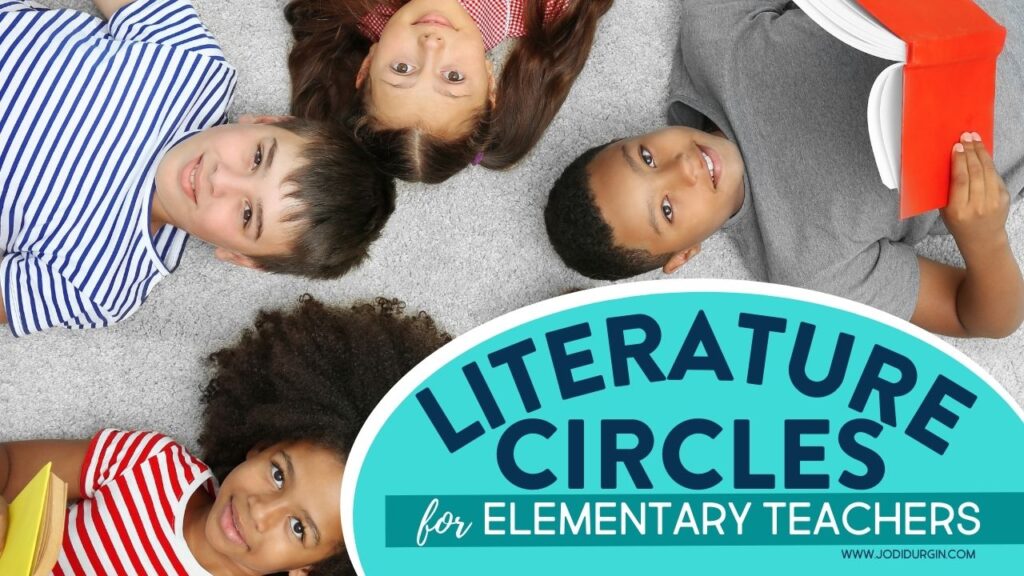
What is a Literature Circle?
A literature circle is part of a balanced literacy program where a small group of students meet to have an in-depth discussion about a text they are currently reading. These weekly meetings are primarily student-led, with students responding to the text and other readers critically. During these meetings, the teacher acts as the facilitator, helping to guide discussions as needed only.
What are the Benefits of Literature Circles in Elementary Classrooms?
During elementary literature circles, students can engage in critical thinking and reflection as they read. They can be differentiated according to students’ interests and reading levels. They can also be free-flowing, or students can practice the skills they are learning in class which allows for endless learning opportunities. Each group of students gets what they need specifically, so no two groups will end up being the same. Additionally, teachers can use flexible groupings of students as their needs change throughout the year! This works incredibly well if the whole class is reading the same book.
How do you Implement Literature Circles in the Classroom?
Before you begin your elementary literature circles, evaluate your students’ current reading abilities to identify their strengths and weaknesses. In addition to looking at their academic needs, it’s important to consider personality, work habits, and peer relationships. Utilize running records and classroom observations as tools to collect data and determine how to group your students. Use all of this information to group your students.
Follow these steps to implement elementary literature circles in your classroom easily and quickly:
Day 1: Introduce
- Books : Either choose one book the whole class will read or choose a book for each group. Students could also select a book for their group by voting on a choice of two or three books you pick.
- Roles/Jobs : Your students can choose their roles within their group, or the teacher can assign them. I know that my students always like a choice when appropriate. Choose a team leader for each group to be in charge of problem-solving around choosing roles. Please see the detailed list below about each role during a literature circle.
- Only one person can talk at a time.
- Respond at least once during each meeting.
- Come to the meeting prepared. All assignments for their role are completed. They have their paper, pencil, and book ready to go before the meeting begins.
- No reading ahead. Students must all read the same pages each week.
- Raise your hand to share during the literature circle.
Day 2 and 3: Review
- Review and model the rules as a whole class and in small groups.
- Review the roles in small groups as other students begin reading the assigned pages of their book. The teacher can pull small groups based on the role/job each child has. For example, pull all the Word Wizards and review how to use the dictionary to look up unknown words.
- Show activity sheets for each role. Some teachers prefer to have a worksheet that corresponds to each position in the literature circle, but these are unnecessary. It is helpful when just beginning, but students become more self-sufficient as the year goes on.
Day 4: Literature Circle Meeting Day
- Review expectations : It is vital to review your expectations before allowing students to meet for their literature circle, especially when just beginning to explore this approach to reading instruction. You could call up a few students to model their roles just before the meetings start so students can get immediate feedback and clearly understand what you expect.
- Literature circle meeting : Students meet with group members to discuss their books. Your students should follow all the expectations you have set during the week, and you should be facilitating as needed. By this time, all students should clearly understand the book, express their ideas, and build on others’ statements during the discussion. This is an excellent time for you to take notes about each student’s progress over the year. You will gain an understanding of how well students understand the texts they read.
What are Roles Assigned in Literature Circles? What are those Individuals Responsible For?
Below is a list of literature circle roles (also called literature circle jobs) that can be used at the elementary level, so they run smoothly and all students are engaged, thinking critically, and sharing with the group.
- The Discussion Director : This student is responsible for keeping all members on time and on track during the book meeting. They are responsible for ensuring everyone in the group has a chance to respond. If a student is shy, the discussion director will solicit a response from them.
- The Connector : This student is responsible for sharing any connections that they make while reading the assigned pages. They share connections with themselves, the text, other texts, or the world with the group and respond to others’ responses appropriately.
- The Illustrator : This student is in charge of drawing an illustration of a main event from the text. The illustrator explains the event in detail and why it was important to the reader.
- The Questioner : This student is in charge of noting any questions or wonderings they had while reading. The questioner will share these questions aloud, and the other group members will respond, leading to some thoughtful discussion.
- The Predictor : This student is responsible for making and sharing predictions about the text as they read. This would also be a good role for each child in the group. All group members could share their predictions about what will happen next at the end of the meeting.
- The Summarizer : This student will be in charge of summarizing the week’s reading to the group. They will share aloud, and other students can respond by adjusting the summary if necessary.
- The Word Wizard : This student is responsible for writing down any new or challenging words as they read. They will then use context clues and a dictionary to record each word’s meanings. These words with definitions will be shared with the literature circle during their meeting at the end of the week.
How to Set Behavioral Expectations for Literature Circles
When you are launching your elementary literature circles, be sure to be very clear about the behavioral and academic expectations during literature circles. Students will be working independently throughout the week in preparation for their meetings at the end of the week. It is important to remember to practice and model each expectation multiple times throughout the first week. In the following weeks, you will still need to restate the expectations before beginning so that every student understands what is expected and can be successful. You will also need to monitor and facilitate as needed throughout the process until students get the hang of the routine and the type of deep thinking you are looking for.
How to Encourage Meaningful Discussion in Literature Circles
First, make sure to model the expectations for meaningful discussions as explained above. It is important to remember that students, especially those in younger grades, do not know how to have academic conversations. Having assigned roles and students prepared when coming to the meeting later in the week helps students sort through their reading reflections about the text they are reading, helping them feel confident and prepared to go into the discussion.
Remember the main goals for elementary literature circles are:
- Communicate
- Critically Think
- Collaborate
Explain these goals and their meanings to students. During the literature circle meetings, you will want to walk around and help guide any struggling students and help them modify how they ask, respond, and state their thinking. Providing students with sentence stems for these types of discussions is extremely helpful until they get the hang of communication that shows their peers’ critical thinking.
How to Hold Students Accountable during Literature Circles
Students need to be held accountable for their roles and responsibilities during literature circles. Assigning each member’s roles is one way to ensure everyone does their part and there is a conversation that shows deep thinking. However, many times there will be a student or two who struggle to stay engaged because it is too hard or uninteresting. Make sure they have some incentive for them to try their best at all times. Using classroom management strategies like a reward system helps here. As the teacher, you can always stand near anyone who may be struggling, so you are nearby when and if they need help remembering the expectations.
5 Tips for Making Literature Circles More Successful in your Classroom
Here are 5 tips for making your elementary literature circles more successful:
- Explicitly teach the expectations.
- Model and practice the expectations.
- Choose engaging books you know your students will like. Listen to them and have them give recommendations of novels they will read.
- In the first several weeks of starting literature circles, pull small groups of students doing common roles for the week. Do this while other students are reading their books on days 2-3. This allows you to teach specific skills required for each of the roles in literature circles.
- Remember, your role is the facilitator. You are there to help guide IF NEEDED. Try just to listen.
How to Implement Virtual Literature Circles
The whole process, as explained above, translates well to virtual learning! All that students need is the text for their group and any recording sheets you want them to use to be prepared for their role in their literature circle. For the meetings, you can use breakout rooms and go from room to room to observe!
What is the Difference Between Literature Circles and Student Book Clubs?
The difference between book clubs and literature circles may not be that obvious to all teachers. Elementary literature circles are more structured and geared toward thoughtful discussion and critical thinking. Book clubs are more relaxed and very much student-driven. Students would base groupings on the book they’d like to read and discuss informally in book clubs.
Literature Circles vs Guided Reading
Guided reading and literature circles are different because one is more teacher-led, and one is more student-led. Guided reading is skills-focused and data-driven. The lessons are taught in small groups or with individual students. The teacher leads these lessons. Elementary literature circles are collaborative and geared towards critical thinking. All students are meeting with their small group at the same time while the teacher helps the discussion as needed.
What are Some Obstacles of Literature Circles? How can they be Avoided?
When planning and implementing elementary literature circles, you could face some obstacles. In an ideal world, all of the students participating in a literature circle meeting will be engaged, actively listening, and enthusiastically participating. As teachers, we know that this does not often happen organically. Some students may struggle to do this due to inattention, lack of motivation, or forgetting the expectations. In order to anticipate and prepare for this, it’s important to explicitly teach expectations at the beginning of the school year, post them in the classroom, and refer to them as needed.
Students who are working towards being independent learners may need additional support to reach their highest potential. Partnering these students’ with models and having regular check ins with them will help these students be active participants in the literature circle meetings.
Another common concern with literature circles is that students will learn to read with blinders because they focus on their specific role in the group that they miss out on the rest of the text’s big ideas. Consider switching your students’ roles each week or having them read the pages once through without knowing their part for the week to avoid this.
Elementary Literature Circle Activities and Resources
Mystery unit for literature circles.
This mystery unit is so engaging that when we did it in my classroom during the last week of school (while the kids all had summer vacation on their mind) they all came in excited to read with their detective clubs and were happily writing right up until the last day of school. No joke. I’ve never seen kids so motivated to learn that late in the school year.
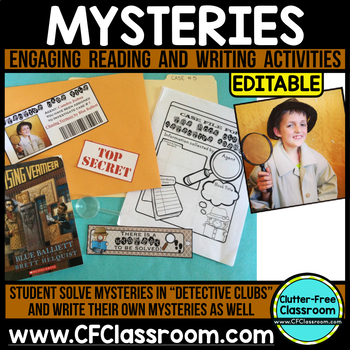
You might also like...
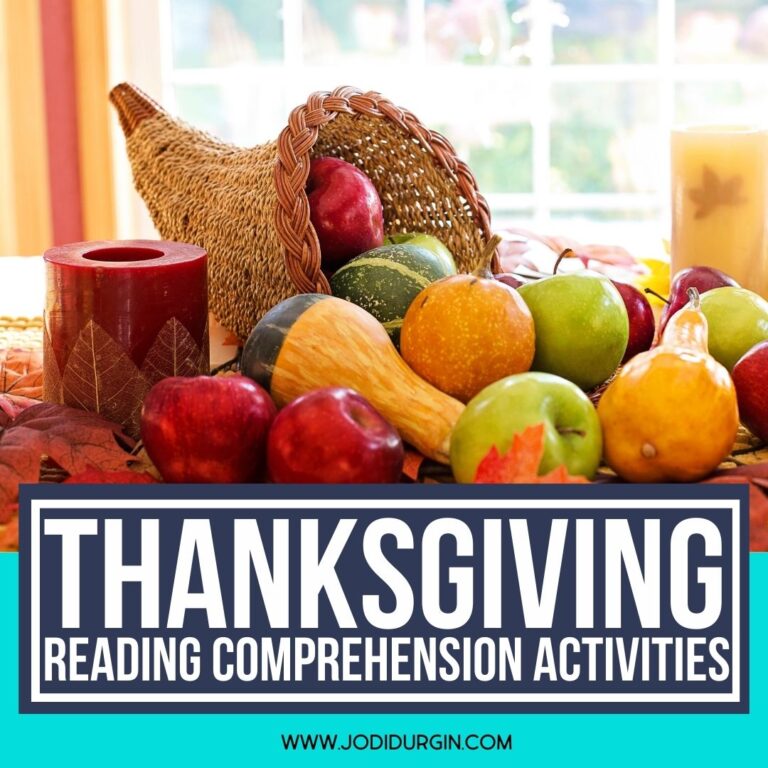
Thanksgiving Reading Comprehension Activities for 2nd, 3rd, and 4th Grade
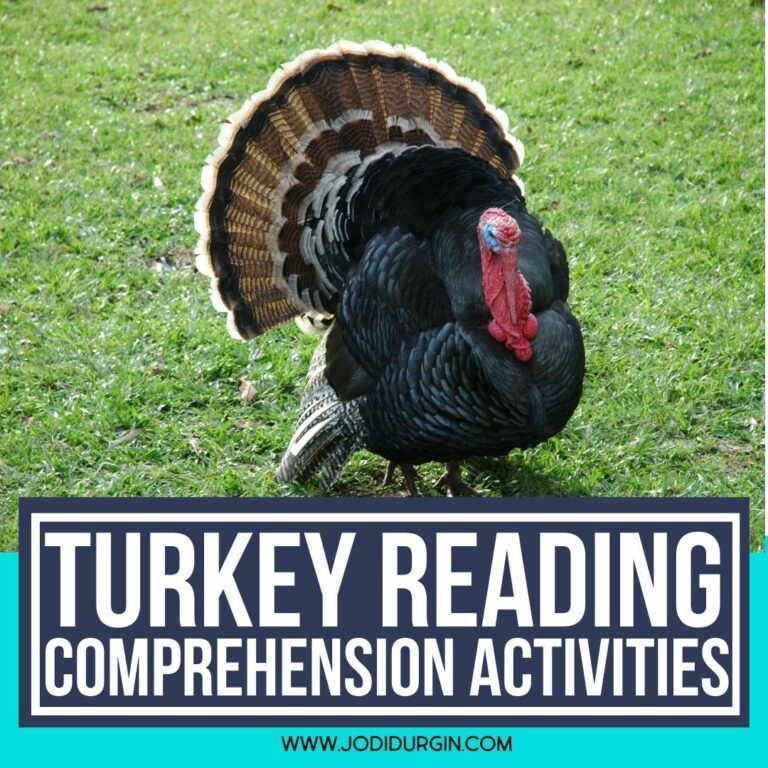
Turkey Reading Activities for 2nd, 3rd, and 4th Grade
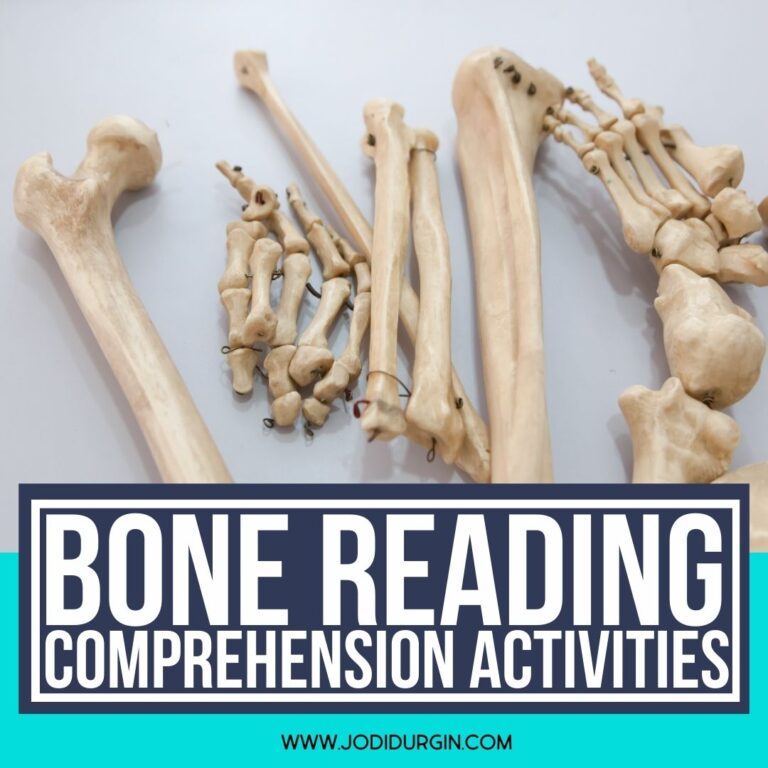
Bones Reading Comprehension Activities for 2nd, 3rd, and 4th Grade
Join the newsletter.

- CLUTTER-FREE TEACHER CLUB
- FACEBOOK GROUPS
- EMAIL COMMUNITY
- OUR TEACHER STORE
- ALL-ACCESS MEMBERSHIPS
- OUR TPT SHOP
- JODI & COMPANY
- TERMS OF USE
- Privacy Policy
- On My Bookshelf
- Teaching Resources
- Privacy Policy

August 6, 2021
- Literature Circles: Skill Focused Activities

You Might Also Like
Post a comment.

Find It Fast
Get support, shop my tpt store, top categories.
- my bookshelf
Post Topics
Blog archive.
- ► April (1)
- ► December (3)
- ► August (4)
- ► July (10)
- ► June (2)
- ► February (2)
- ► November (3)
- ► October (2)
- ► September (2)
- ► July (2)
- ► June (9)
- ► May (1)
- ► March (1)
- ► February (1)
- ► January (1)
- ► December (1)
- ► November (2)
- ► October (1)
- ► September (1)
- Literature Circles: Online Discussions
- Literature Circles: Holding Teacher Led Discussions
- What I'm Reading & Planning in August
- ► June (1)
- ► May (3)
- ► February (6)
- ► January (5)
- ► December (2)
- ► October (6)
- ► September (6)
- ► August (5)
- ► July (6)
- ► May (2)
- ► April (4)
- ► March (4)
- ► February (4)
- ► December (6)
- ► November (10)
- ► October (13)
- ► September (10)
- ► August (14)
- ► July (7)
- ► May (4)
- ► April (7)
- ► March (10)
- ► February (7)
- ► January (7)
- ► November (4)
- ► October (8)
- ► September (13)
- ► August (13)
- ► July (9)
- ► June (6)
- ► May (7)
- ► April (13)
- ► March (12)
- ► February (11)
- ► January (12)
- ► December (7)
- ► November (11)
- ► October (14)
- ► August (12)
- ► July (12)
- ► June (7)
- ► May (8)
- ► April (14)
- ► March (17)
- ► October (12)
- ► July (11)
- ► June (5)
- ► May (14)
- ► February (13)
- ► January (13)
- ► December (8)
- ► November (13)
- ► September (12)
- ► August (11)
- ► May (5)
- ► October (4)
- ► September (4)
- ► August (3)
- ► July (4)

Literature Circles in First Grade
- Reading & Literacy , Stations and Centers
Literature circles offer the perfect opportunity to support advanced first grade readers!
Thinking about those students who need an extra push?
What about your higher readers?
Hoping to hold them more accountable?
Literature circles might be what you want to do!
A lot of teachers don’t think they can do this in first grade, but I promise you can!!
As you move into your year you get a pretty good idea of where all your students are at and what it is they need.
Well, I always have a handful of students who are above where they are “expected” to be and some who are WAY above what we are working on in first grade.
These kiddos need a good push and, for me, literature circles have been the best way to do that.
And guess what?!
My students LOVE it!!
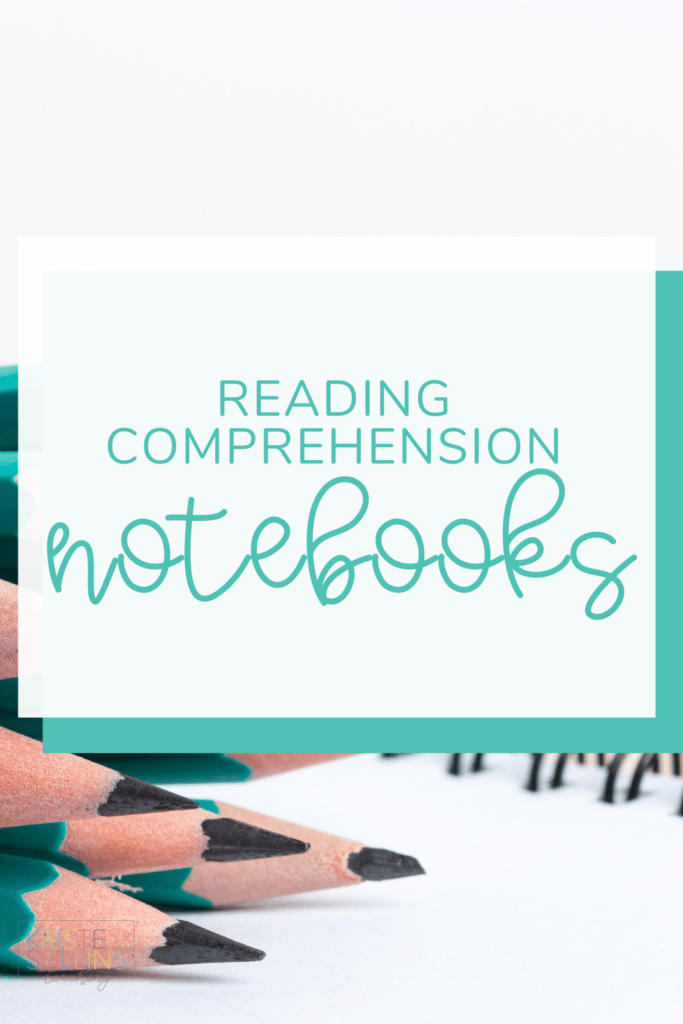
How do you Set Up a Literature Circles in First Grade?
Like everything else we do in the classroom, literature circles take structure, consistency and practice.
Students need to be taught how your literature circles are going to work and what your expectations are.
My typical reading groups include reading the text at my table, discussing it, and writing about it; but literature circles put more responsibility on my students.
They are expected to read a chapter and complete an assignment PRIOR to meeting with our group.
Now, this is still first grade so expect to continue to have discussions about responsibility when students don’t do what they are expected to.
Starting Literature Circles for First Grade
- Pick a book students will enjoy and that is at a level every member of the group can successfully read independently. I've found chapter books to work the best, but you can do some practice assignments with shorter books to get your students into the routine.
- Introduce the book to the group and identify unknown/tricky words that students may encounter. I like to add these to an anchor chart that we hang on one of my cabinets. That way students can refer to it throughout the book.
- Explain what a literature circle is and what your expectations are
- You will read the assigned chapter on your own before our next meeting
- You will complete the assignment included with that chapter before our next meeting
- During each meeting you will share your insights from the given chapter and your assignment (or assigned role *see Optional Roles)
- You will respect other student’s takeaways and be a involved in group discussions
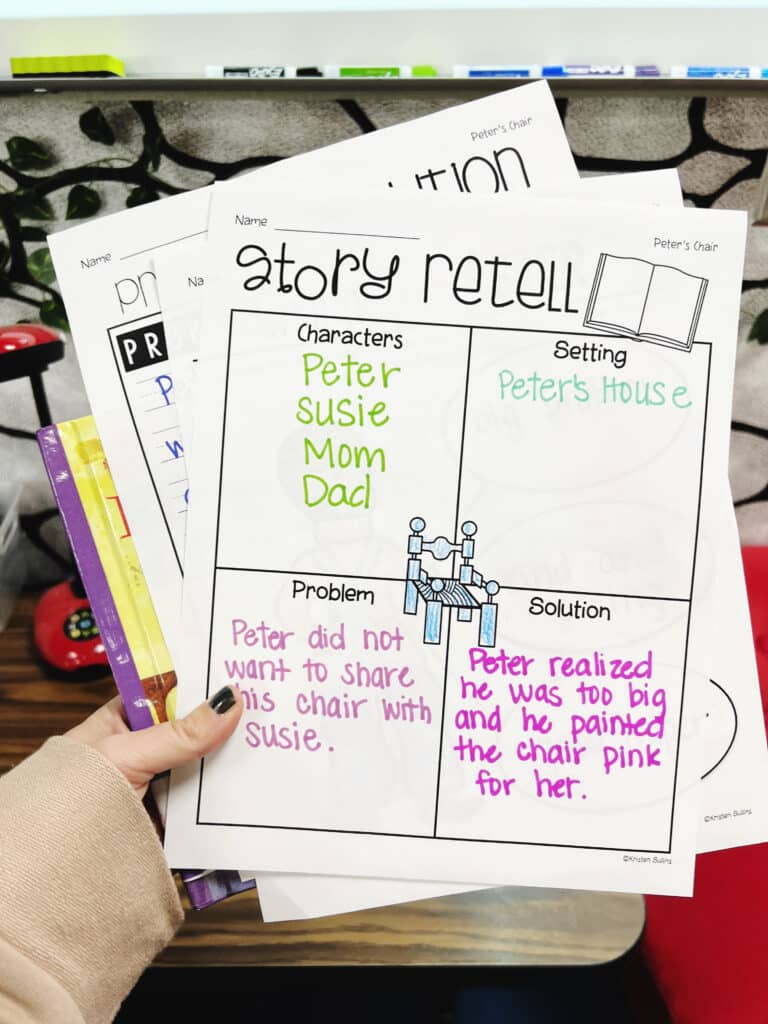
Structuring Assignments and Optional Literature Circle Packets
Over the years I’ve gone back and forth from creating a packet and just using a notebook.
Creating a literature circle packet is really nice, especially if you’re just trying literature circles for the first time.
It involves each student having their own packet (folder with brads) with assignments inside. (See more on Assignments below)
If you don’t decide to do a packet, using a notebook is just fine! I have found that it is easy to just post the assignment each day/week where students can see it.
My literature circle group has a preselected spot on my cabinets where I put up those trick words we discussed when introducing the book.
That is where I post their assignment for the chapter. They then complete the assignment in their notebooks. (More info on this below under assignments)
What if a student doesn’t do their job?
If they don’t do their job, it is hard to discuss the reading as a group. If students are not prepared to meet because they did not read the chapter (or assigned role), they are sent back to their seat to complete it.
My FIRST Literature Circle Assignment
Word investigator ~ After reading the first chapter, students identify 3 words in the chapter that were unknown words. They include the page number and the definition. They will share these words and definitions in our first literature circle meeting!
The first time you start literature circles you will need to teach your students how to use a dictionary. I have a set of 6 children dictionaries in my library students can access at any time . You will need to teach them:
- How to use a dictionary
- What to do if there is more than one definition
- Where the dictionaries are located in the classroom
** We add these words to a small anchor chart that we hang on my Literature Circle cabinet**
Literature Circle Assignments
Each book will have all these assignments, but there are different ones for each chapter. Sometimes they will complete one of these assignments and add more as the book continues. For example, they may complete the character assignment after chapter 2, but then are required to add new significant characters that are introduced. While other assignments are a one-and-done, like when I have students visualize and draw a specific event from a chapter.
If you choose to use a notebook, I usually distribute post-it’s so students can use them as markers for each section. You want to make sure students have enough pages to complete each assignment.
Here are my typical literature circle assignments:
- Word investigator (first assignment – info above)
- Characters – Name and description of characters
- Visualize – Draw setting, characters and events
- Predictions – write what you think will happen. This typically comes after students read a chapter involving the problem.
- Map it! – students map out they story using key details including setting, characters, and events
- Retell – students write a short synopsis (and he’s we call it a synopsis!) if the story ** This is the last assignment after the book is complete.
Other assignments I’ve included have been writing about any surprises, arguing a better ending and even doing a review of the book.
More Details on Literature Circles in First Grade
Optional Roles
This can be a fun way to shake up what is expected for your students and to give them a different type of responsibility! Once you have completed your first literacy group chapter book you can change the assignments into roles. Students will be given a different role (assignment) each. They would then be responsible for reading their chapters and completing their role. Then during our literacy circle meetings they would share their findings.
When a student is given a role for a book or a chapter, it is their responsibility to read that chapter and complete that specific assignment. For example, if a student is the discussion Director, they are in charge of having a solid understanding of the chapter and guiding group discussion.
They essentially are the teacher, and will be asking the other students to discuss and elaborate on their roles. The word investigator will share any unknown words and definitions that came up, the visualizer will describe and share how they visualized a specific part of the chapter with a drawing, the character friend will describe the characters and possibly share drawings of the characters, etc.
Here are some of the roles we use: word investigator, discussion director, visualizer, story mapper, character friend, story predictor, re-teller. I make sure students don’t get the same role twice and guide them through what their expectations are.
I sometimes don’t start this in book 2, it depends on the students I have and their confidence in the assignment/role requirements. There have been years where we didn’t do roles at all and just stuck to the assignments, but this can be fun!
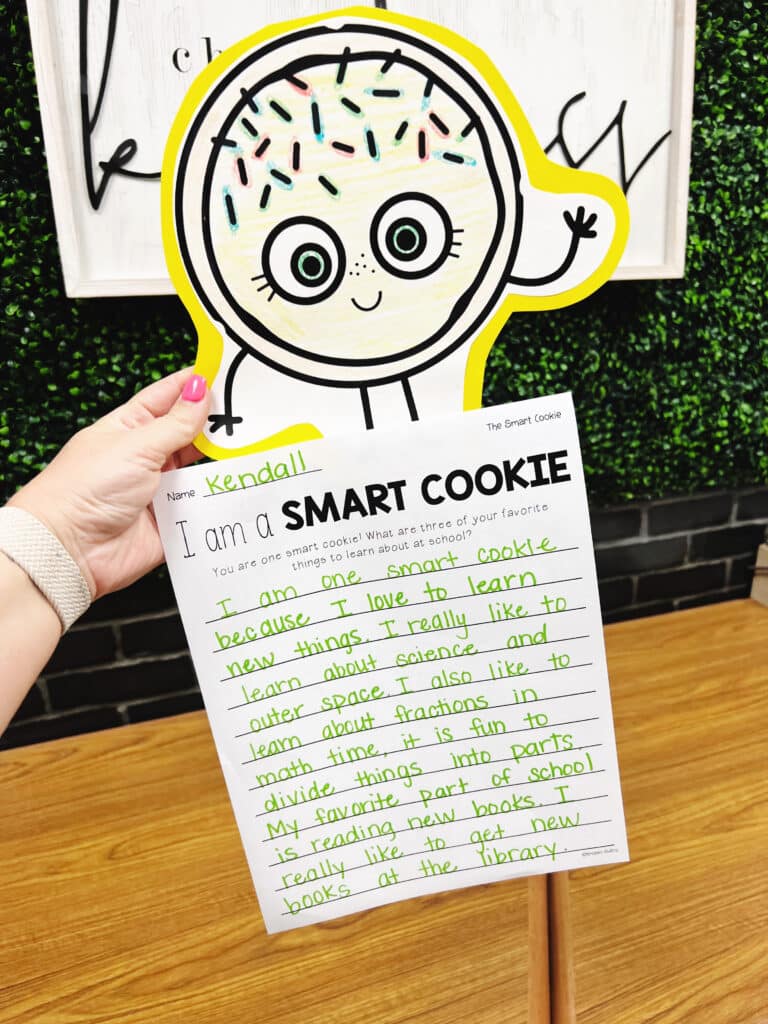
Overall, I have found literature circles to not only be a lot of fun, but really beneficial for my students who need that extra push.
We often worry about our students who are below level or struggling (rightfully so), but we also need to make sure we are challenging our students who are meeting and exceeding expectations!
There are a lot of different ways you can structure literacy circles, but this is what I have found to work best in my classroom.

Literature Circle/Book Study Activities
This link will take you to my favorite book and author studies!
I use these read aloud companions all year long and they make the perfect literature circle “activity packets” that I mentioned earlier in the blog post to help monitor students' comprehension of the book they read!
More First Grade Reading Favorites
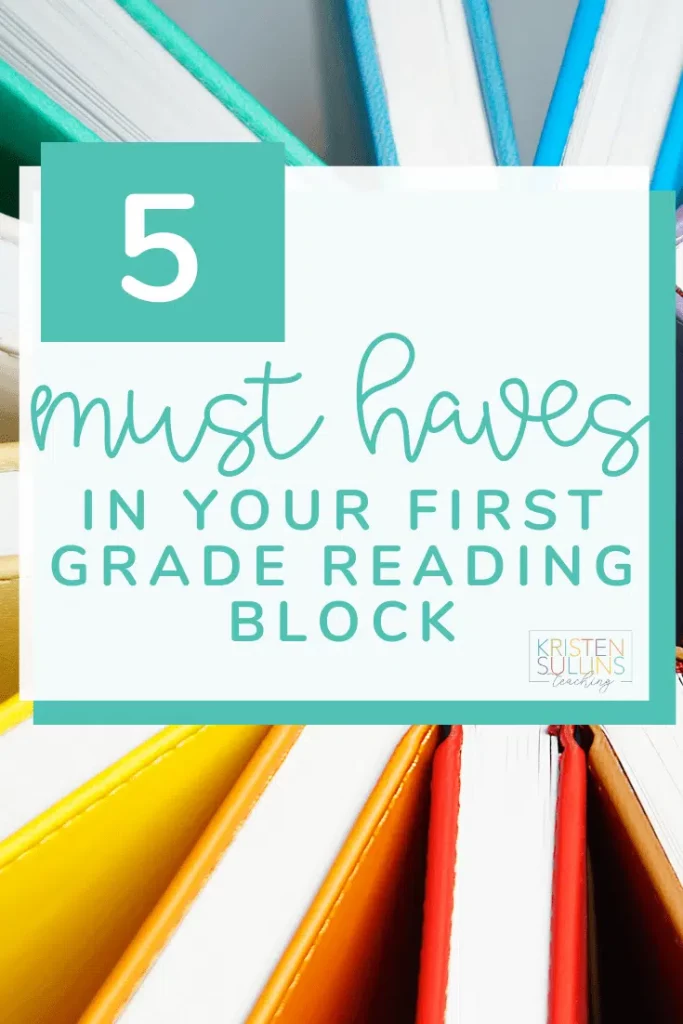
sign up for free stuff
Sign up to receive weekly emails with tips, free resources and info about upcoming sales.

Kristen Sullins
I am a current Elementary Librarian and Enrichment Teacher, mother of two, follower of Christ and Texas native. In my own classroom, I love to save time by finding unique ways to integrate writing, social studies and science into all parts of my day. I also love all things organization!
YOU MAY ALSO ENJOY...
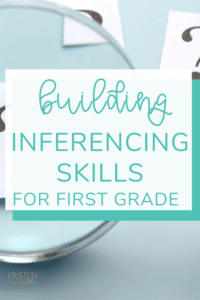
©2019 Kristen Sullins. All Rights Reserved
Site by Ashley Hughes
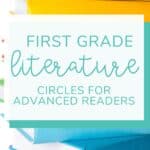
- Skip to main content
- Skip to primary sidebar
Pre-order my book and get a free bonus! LEARN MORE
The Measured Mom
Education resources for parents and teachers
PS PK K 1 2 3 10 Comments
How to get started with literature circles
This post contains affiliate links. As an Amazon Associate I earn from qualifying purchases.
Sharing is caring!
- Pinterest 1788
This post contains affiliate links.
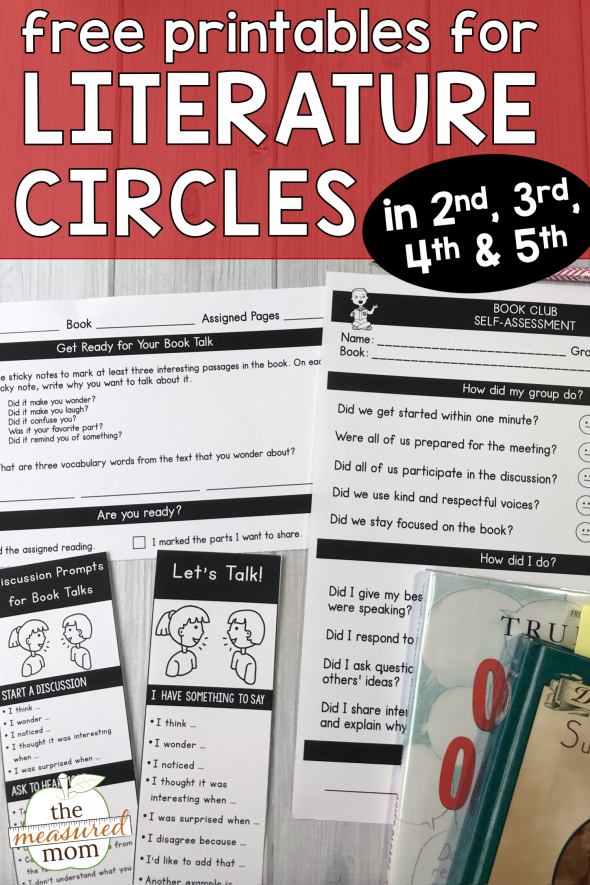
Have you ever been part of a book club?
A number of years ago (pre-kids and gray hair), my sister taught kindergarten and I taught first and second grade. Though both of us had started our careers with older learners, we loved our young students – and we constantly sought out ways to improve our teaching.
But we also knew that our content knowledge was taking a hit. Most of our school days focused on teaching literacy and math – not high level social studies and science concepts.
To make sure we kept learning about the world around us, we created our own private book club – the Anna-Kate Book Club. Each month we chose a new nonfiction topic, selected our own books, and read them in the rare moments we weren’t in the classroom. At the end of the month, we hopped on the phone to talk about what we’d learned.
Over 15 years (and a total of ten kids between us) later … I still remember many of the things we talked about.
Talking about books is powerful.
It’s so powerful that many teachers have book clubs in their classroom. We often refer to them as literature circles .
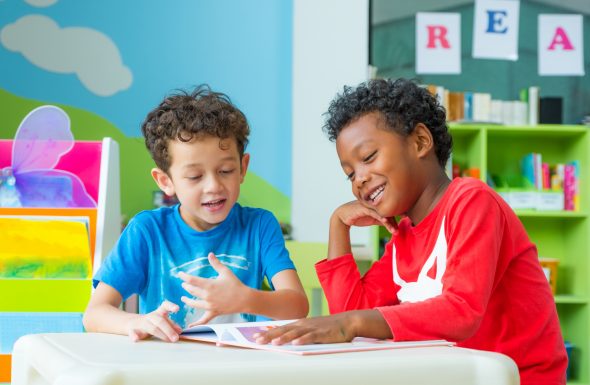
What ARE literature circles?
Literature circles are small groups of students who meet to discuss the same book. The discussion guides students to a deeper understanding of the text. With the right modifications, we can implement literature circles in all grade levels.
Woah – groups of kids talking together during classtime. Sounds like it could get out of hand very quickly.
Are literature circles really worth it.
Literature circles have so many benefits! Here are four.
The opportunity to choose their own books and discuss them with their classmates helps our learners develop a love of reading. If they love to read, they’ll be motivated to do it more often. And the more they read, the stronger readers they will become.
Another benefit is the power of conversation. When students talk about their reading, they can become more critical thinkers. Discussion helps them make sense of the text. Feedback from other students helps them form new ideas.
A third benefit is that literature circles allow our students to become active participants in their own learning . “Students commit to reading because they raise the questions and they consider their own experiences as they respond.” (Getting Started with Literature Circles, by Noe & Johnson)
Finally, the literature circle format helps our students learn to have meaningful, respectful discussions – an important life skill, to be sure.
The biggest reason literature circles FAIL
As a new teacher, I had something many young teachers possess – enthusiasm and optimism.
I collected every book I could find about literature circles. I researched, read, highlighted, and knew, without a doubt, that literature circles were right for my classroom.
I quickly prepared some materials and jumped in with both feet.

Quickly the noise and chaos became more than this type A teacher could bear.
I struggled to get literature circles off the ground.
I made the mistake that many teachers make – the biggest reason that literature circles fail – I had failed to think through the logistics and plan accordingly.
Before you begin, think through the logistics.
- How will students choose their books?
- How will you form groups?
- How many groups will meet at a time?
- How often will groups meet?
- As a teacher, what will be your role?
- How will you teach your students how to participate?
- How will students prepare for their meetings?
- How will you and your students assess their learning?
But don’t overthink it.
Yes, you do need to think through all the logistics to make sure that students know what’s expected of them and so you can help them stay on track.
But you don’t have to overdo it.
There are a lot of clever ideas out there about “roles” that you should assign to students in literature circles – the Discussion Director, Word Wizard, Literary Luminary, etc. With this model each student has a particular role in the group – whether that’s to keep everyone on track, point out new vocabulary words, or locate “golden” passages worthy of discussion.
It’s not wrong to use these roles if they work for you and your students. But “sometimes, managing the roles takes so much energy and focus that students lose sight of their real purpose – to talk about books.” ( Getting Started with Literature Circles , by Noe & Johnson)
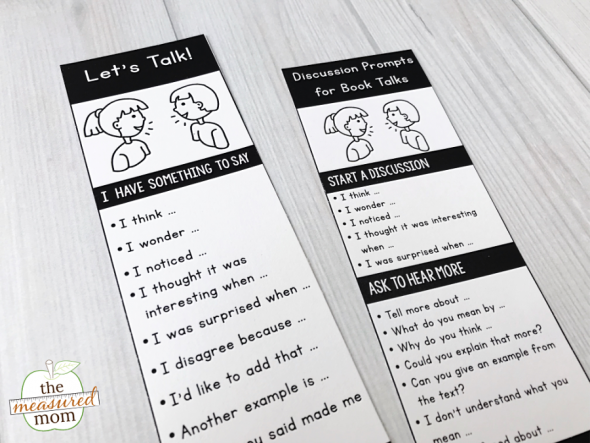
Rather than focusing on specific roles, I recommend a strong focus on helping all students listen and discuss. At the end of this post, you’ll find printable bookmarks that can help.
Just get started.
Just as you shouldn’t jump in before you’ve thought through the details, you shouldn’t wait until you know exactly how everything will go. You can’t plan for every single contingency. At some point, you just need to start.
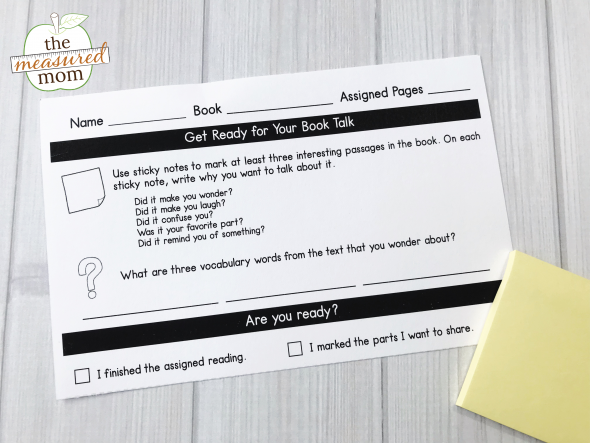
Make sure you’re clear about what students are responsible for before each meeting. You might give them a half sheet like the one pictured above (it’s included in the download at the end of this post).
Help students reflect on the process.
After you’ve implemented literature circles, assess how they’re going – and include your students. They will not go smoothly at first – and maybe not for some time. Invite your students to do self-assessments, and hold class discussions to talk about things you might improve.
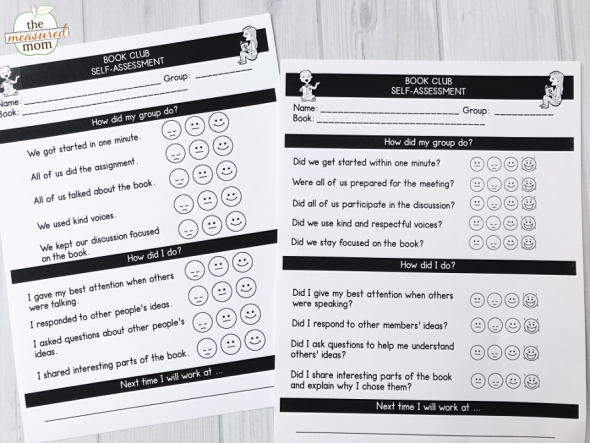
The above self-assessment forms are included in the packet at the end of this post.
I hope this post gave you some things to think about as you plan for literature circles in your classroom!
Where to learn more
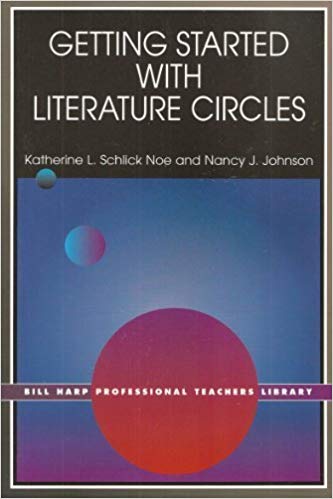
- I highly recommend this short book – this oldie but goodie is packed full of goodness!
- The authors of the above book have a companion website – super helpful! You can visit it here.
Check out the rest of my blog series about teaching reading in grades 3-5!

Get your Literature Circle Freebies!
Free reading printables for pre-k-3rd grade.
Join our email list and get this sample pack of time-saving resources from our membership site! You'll get phonemic awareness, phonics, and reading comprehension resources ... all free!

You May Also Enjoy These Posts:
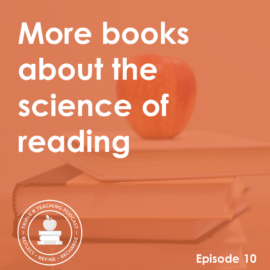

Reader Interactions
10 comments.
June 6, 2019 at 11:14 am
Thanks so much! I’m already thinking of ways I’d like to implement literature circles in my classroom! I just found you on Pinterest today! I can already tell this will be a valuable group ?
November 29, 2018 at 11:27 pm
November 30, 2018 at 7:24 am
You’re welcome, Anna!
November 22, 2018 at 12:57 pm
Thank your for the freebie. You’re an incredible teacher! I’m a huge fun of your resources. Best regards, Dorothy
November 24, 2018 at 3:53 pm
You’re very welcome, Dorothy!
November 21, 2018 at 12:50 pm
Ahhh, those were the days, Anna!
November 23, 2018 at 8:01 pm
Another life time ago, sister! Maybe in about 15 years we can have round 2. 🙂
November 24, 2018 at 1:38 pm
Julie Behnke
November 21, 2018 at 10:11 am
Thank you so much for this Book Club Freebie. I have already started book clubs in second grade with my students reading above grade level. I gave them a choice of several chapter books and they agreed on one.
I am using Reciprocal Teaching. Each student will end up with a role. We are starting small with only two roles. I have been teaching them about Predicting, Questioning, Summarizing, and recently Clarifying. I made role cards with pictures and we are starting with Predicting and Questioning.
We have done these whole class with a read aloud. Now, I am equipping my small chapter book group to go alone!
I really like the Assessment Sheet you have provided. I have been thinking about accountability and I hope this form, with some conversation around it, will do the trick!
Thank you so much for all of your freebies. You are appreciated by me and so many others.
May God bless you and your family today and always.
November 23, 2018 at 8:08 pm
Wow, I would LOVE to visit your classroom, Julie! I remember doing reciprocal teaching in college as we were learning how to use it – how fantastic that you’re doing it with second graders! I’d love more feedback from you in the comments as I share posts about literature circles. I know my readers would learn a lot from you!
Leave a Comment Cancel reply
Your email address will not be published. Required fields are marked *
This site uses Akismet to reduce spam. Learn how your comment data is processed .
Science of Reading Resources
Popular freebies.
Get instant access to science of reading workshops and over 2000 printable resources!
Become a Member
On Lemon Lane
June 26, 2020 By On Lemon Lane
How to Get MORE Out of Literature Circles with Weekly Assignments FREEBIE Included
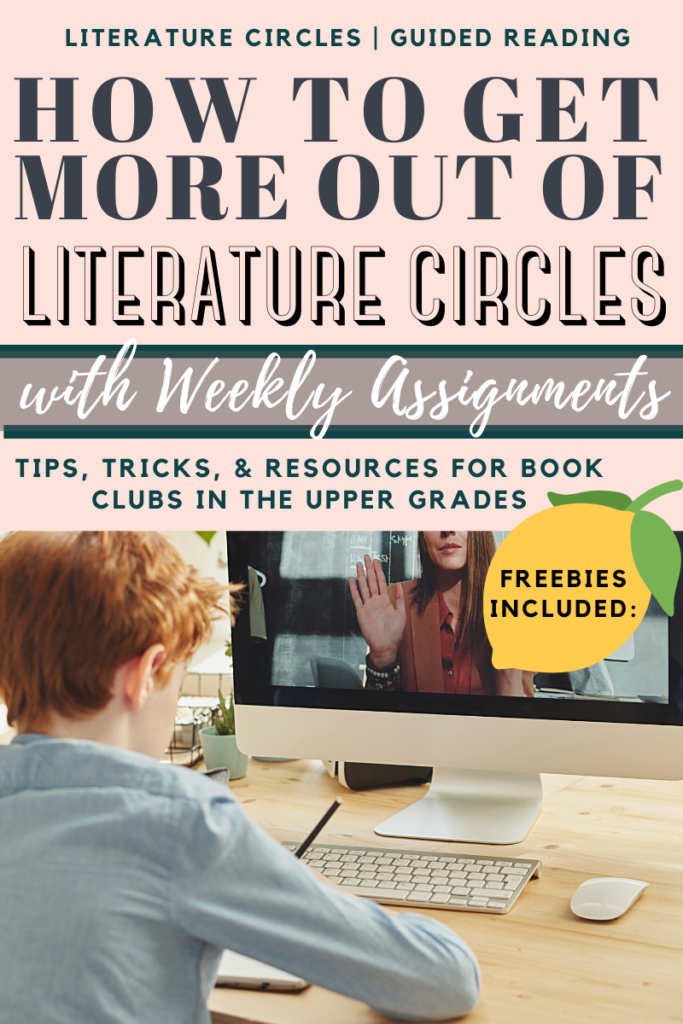
If you’re reading this, I hope this means you have already read my post on, “ How to Set Up Literature Circles in the Upper-Grade Classroom,” as well as the post on, “How to Keep Students Focused and Accountable During Literature Circle Discussions.” If not these are great places to start. If you also find yourself thinking I’m not here for information on setting up Literature Circles… Don’t go anywhere. These Strategy Focused bookmarks and student response pages are so extremely accommodating, their application and potential in the classroom go far beyond Literature Circles.
The idea for these strategy focused activities originated with my Literature Circle Groups. My set-up for Literature Circle groups evolved over the years, each year getting a little better, a little more effective, and a little more streamlined. What began as a weekly bookmark | summary and a letter to the teacher about what you read and the strategies used written in a reader’s notebook, eventually led to google classroom submissions, and finally to the finished product|program were going to explore in this blog post: Strategy Based Bookmarks and Strategy Based Digital Reading Responses.
Benefits Behind the Bookmarks and Digital Response Pages:
- These activities can be used with any text. Specifically fiction, novels, and digital reading passages. This allows you to use them again and again. Based on the text assigned you can easily differentiate amongst your students and apply rigor.
- These activities are editable through Google Drive. You can easily and quickly edit the text to your classroom’s needs, or alter the text to include more text-specific questions. The Active Reading Strategies are also editable in a way that you can completely customize the activities by moving different sections in and out of the response area.
- Use hard copies in the classroom, or assign the Digital Version Student Response pages in Google Classroom. Whether you start in the classroom, as a hybrid model, or distance learning classroom, you won’t skip a beat moving from one type of learning to the other. These pages are made to accommodate your unique needs as a teacher.
- By focusing student’s reading assignments on a single strategy you simplify your planning. Teach a whole class mini-lesson on the strategy of the week, practice together, then allow students to work independently with an appropriate text as they demonstrate the modeled strategy. This simplifies your planning 10 fold, while still allowing you to differentiate to your student’s needs.
- By focusing on a single strategy classroom discussions can be united and depth from different texts is added. No matter what text you are using, as long as the strategy is the same, students can connect, relate, and give great insight to a strategy that may have been one dimensional by only using a whole-class text.
- Active Reading Strategy Pages include my teaching notes, Elements of Fiction Pages include Anchor Charts. I’ve done my best to make the implementation of teaching these strategies through these products as seamless as possible. So much that I’ve included basically a script of how I introduce each active reading strategy (Editable text so you can make it your own) as well as a completed anchor chart that defines and gives examples of each Element of Fiction.
- The use and application of these pages are endless. Use these anywhere there is some type of reading assignment. Think ELA integration with History, Social Studies, or even use the Active Reading Strategies in Science. Use these as a Guided Reading lesson, Literacy Station Rotations, Whole-Class Novels, Classroom Book Clubs, or how they originated in weekly Literature Circle Assignments.
- This product is flexible across a large span of grade levels. Because it is text-dependent it can be used and implemented in grades as young as elementary looking to study chapter books or novels, to your middle school upper grades and High School Students.
Watch Video above for Preview of Making Connection Bookmark & Digital Student Response
What’s Available
Scroll to the end for more information on purchasing.
Active Reading Strategies Click Here to Purchase
- Making Connections (Free Download)
- Making Predictions
Click Here to Purchase
- Making Inferences
- Visualizing
- Asking Questions
- Synthesizing
- Summarizing
- Active Reading Strategies BUNDLE
Elements of Fiction Click Here to Purchase
- Point of View | Voice
- Mood | Tone
- Elements of Fiction BUNDLE
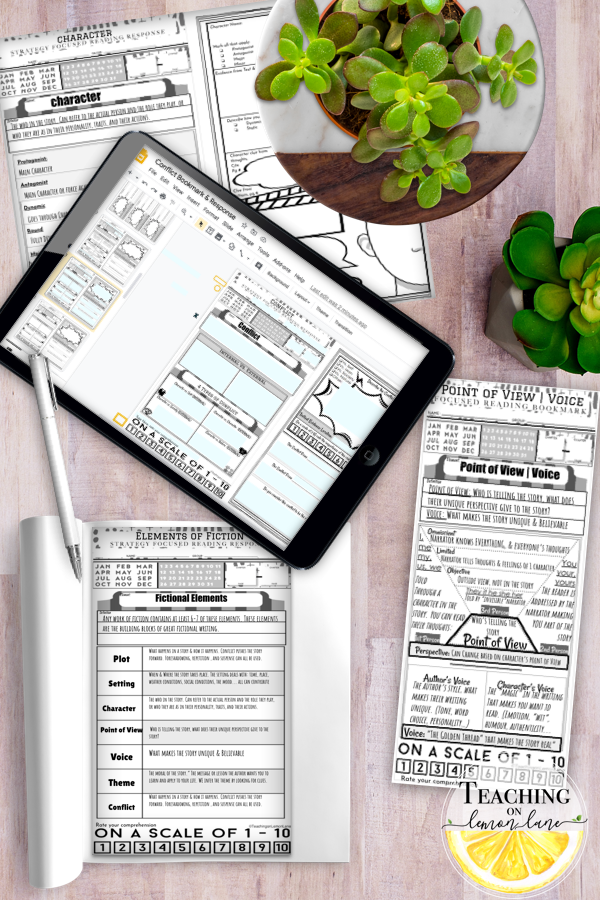
SAVE BIG AND PURCHASE BOTH SETS AS A MEGA BUNDLE
Watch the video above to preview everything included in the Mega Bundle.
How I use Them in the Classroom:
As was mentioned these originated as Strategy Focused Bookmarks that my students used during Literature Circles. At the beginning of a reading assignment. Students write the new reading assignment and due date at the top of the bookmark. We would do a quick lesson on the strategy we will be focusing on for the week, I like to follow the To, With, By model. Meaning I would introduce the strategy to them using a picture book. (High School | Middle School teachers… Don’t check out on me with the mention of a picture book. Big kids love picture books too, not to mention they are a WONDERFUL way to EASILY Integrate other subject material. If you can’t find a picture book or can’t bring yourself to picture book, find a brief reading passage instead! Model the strategy completely. This mini-lesson|introduction is done completely TO the students. Notice with each strategy focused bookmark, I’ve included my personal notes with how I teach that specific strategy. This takes all the guesswork out for you and gives you a great base to start your discussion. Next, try applying the strategy to the remainder of a picture book or reading passage WITH your students. By the time you are done with this lesson students will be ready to work independently (BY) on their next assigned reading.
The Bookmarks lend themselves well to literature circle reading assignments or Classroom book clubs. Within the bookmarks, I’ve included strategy focused boxed activities. These boxes and the text within them can all be moved, manipulated, and edited to your own classroom needs. I’ve created these to be either printed double or single-sided. These activities act as the assignment that corresponds with the reading that week. Students have the week to complete the reading and the Strategy Focused Bookmark Activities.
At the end of each week, I have students turn in their bookmarks and meet with their group to have a discussion on what was read. In order to keep their group discussions focused on the weekly strategy and meaningful, I created the Roll and Respond Activity. Click Here to Learn More about the Roll & Respond Pages and “How to Keep Students Focused and Accountable During Group Book Discussions.”
How to use in a Digital Learning Classroom:
Because of the need for resources that can be used in the regular classroom as well as adapted to a Distance Learning Classroom or Hybrid, I modified the bookmarks and created a Strategy Focused Digital Student Reading Response. Both are included in every Bookmark download. This allows you to use and assign these in a completely digital setting. If you are setting up Literature Circles to be completed through Distance Learning… WHICH I HIGHLY RECCOMEND. I still recommend printing off these bookmarks and giving them as a hardcopy to your students. I would include this in a packet and have students take a snapshot of the completed bookmark to show they have completed it. Each week I would hand out a new bookmark, with a new strategy to focus on while they complete the reading for the week, or handout every bookmark they would need with the start of a new novel! Maybe I’m old fashioned but I think something concrete like a book and a bookmark will help things feel a little more normal.
From these simply assign the specific Digital Reading Response through Google Classroom. To do so, begin by creating a student version of the slides. Once the Google Slide File is open, hold down the [control] or [command] key while you click on the slides your students will use.*** Only click on the slides you want students to see/use. Next, click on [File] then, [Make a Copy]. From there click on the [Selected Slides] option. Rename the file to include [Student Version] or something to that effect in the title. Then click OK. This will create a new copy of only the slides you selected and add it to your Google Drive. Making it EASY to assign these pages digitally or during distance learning.
Because the entire class is focused on the same strategy, having students respond to a strategy focused question, or having a group discussion can be really rewarding. Despite everyone using different texts, their response will be focused and just as meaningful to a student not reading the same text. Use the Digital Versions of the accompanying Roll and Respond Sheets to have students respond at the end of their reading assignment using digital tools like FlipGrid, Screen Castify, Zoom, or Google Meet! Click Here to Learn More about the Roll & Respond Pages and “How to Keep Students Focused and Accountable During Group Book Discussions.”
Give it a Whirl, Enjoy this Free Download:
In order to access the download, you must be logged in. Not a member? Not a problem! Sign-up is FAST, FREE and Easy-Peasy Lemon Squeezy! Click here to become a member!
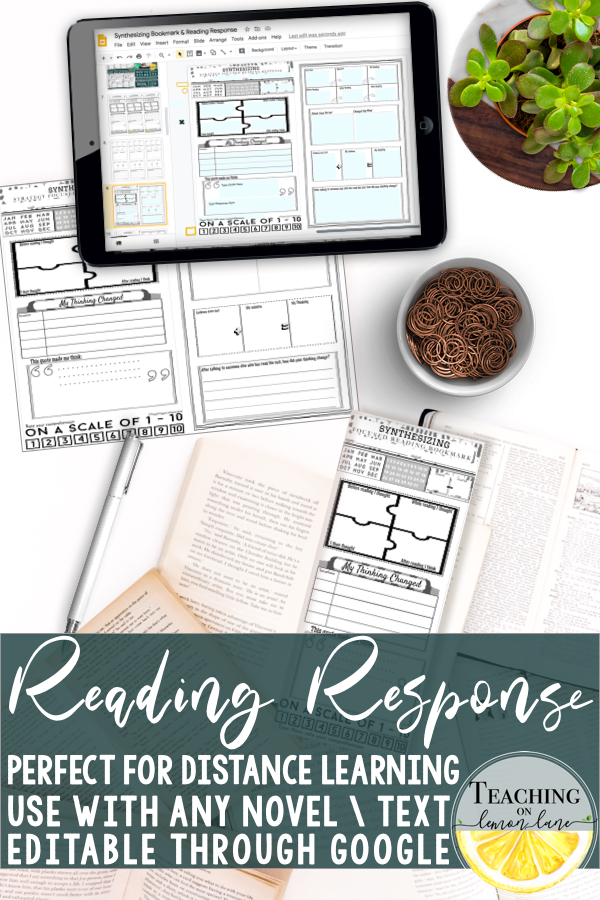
CLICK HERE TO DOWNLOAD FREEBIE
Not a member? Not a problem! Sign-up is FAST, FREE and Easy-Peasy Lemon Squeezy! Click here to become a member! Already a Member? Click Here to Log In
***Remember these downloads are for personal use only. Your membership is good for one license of each product, meaning sharing or emailing with a friend is strictly prohibited. However, telling a friend how to become a member and download on their own is warmly encouraged and very much appreciated!
Save Big with Bundles: Bookmarks, Digital Responses AND Roll & Responds
***Something to keep in mind, if you like the idea of using these in your classroom make sure to check out the Roll and Respond Pages. Both were made to be used in conjunction with the other. Both activities are great on their own but are taken to a whole other level when used in a partnership. See options below to SAVE BIG by bundling!
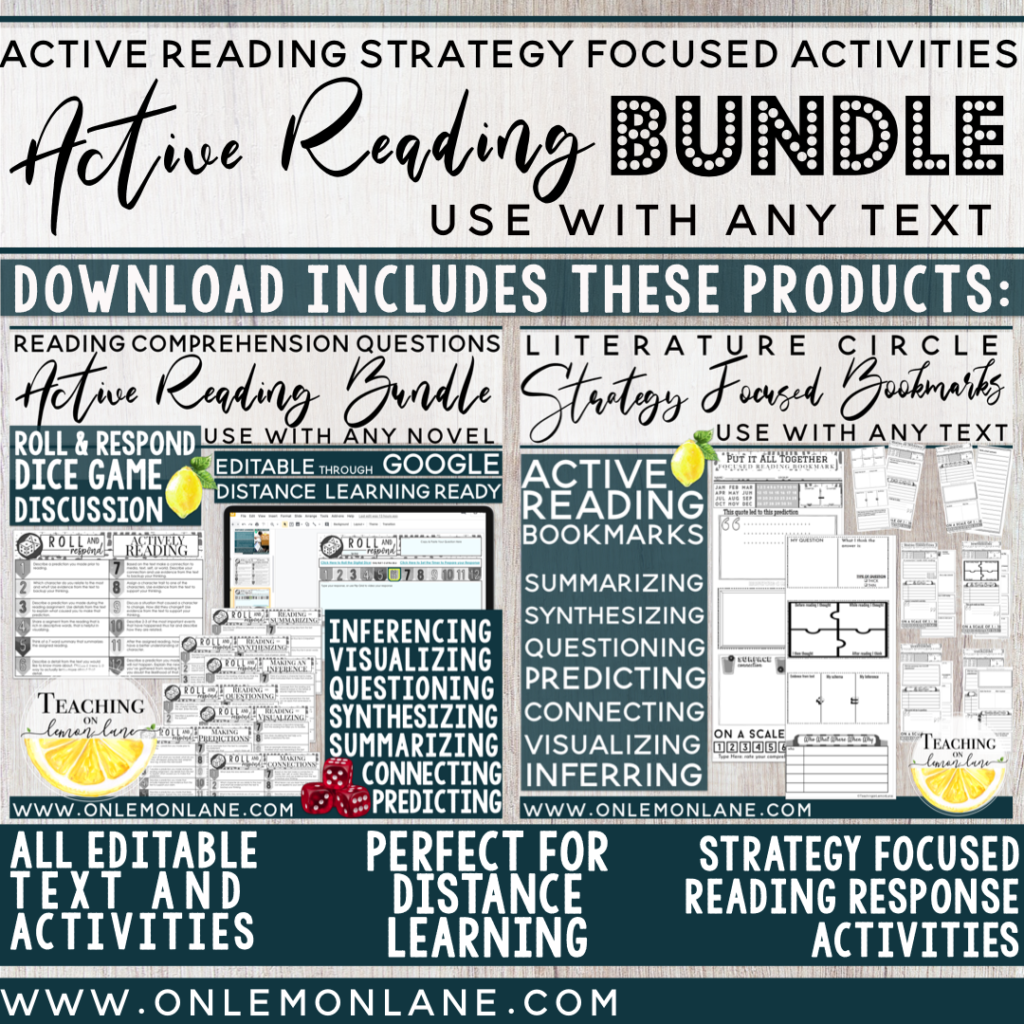
Active Reading MEGA Bundle: Roll & Respond and Strategy Focused Activities
Click Here to Purchase on Teachers Pay Teachers
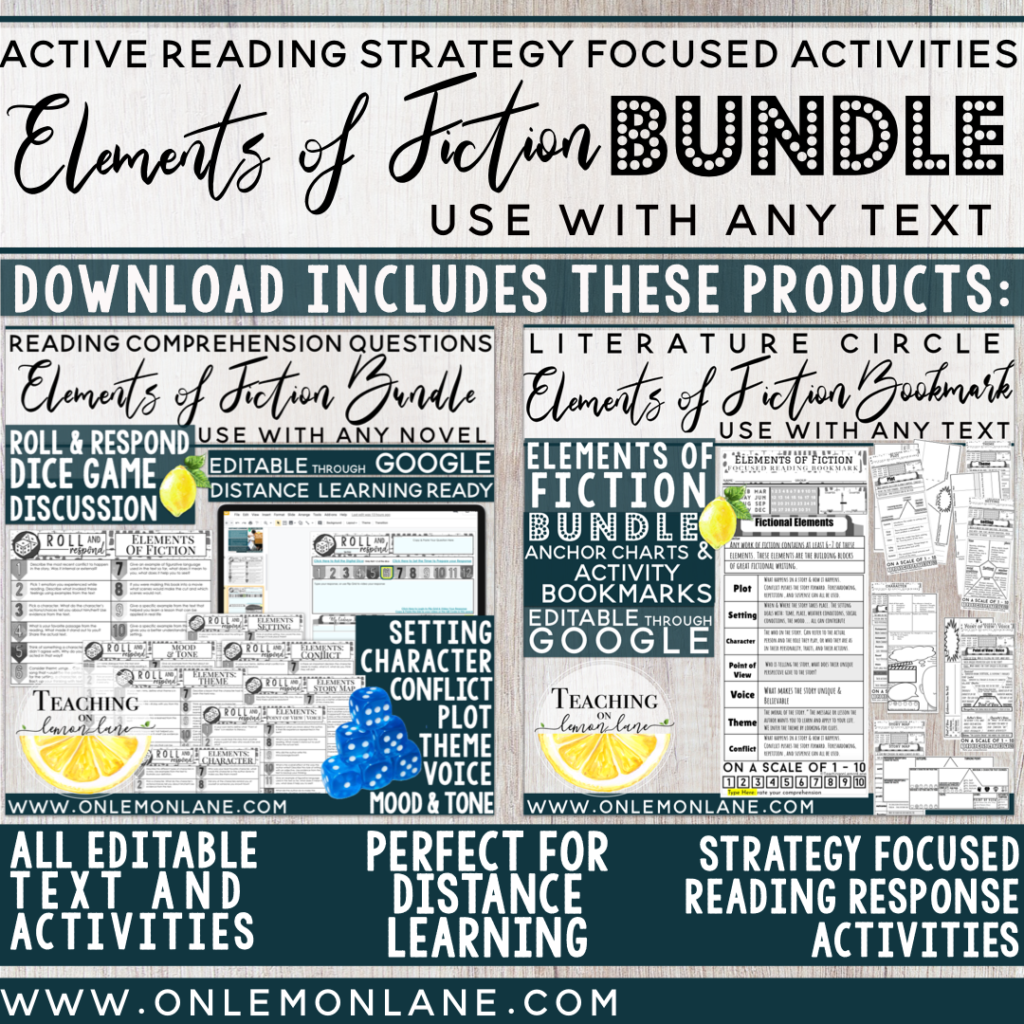
Elements of Fiction MEGA Bundle: Roll & Respond and Strategy Focused Activities
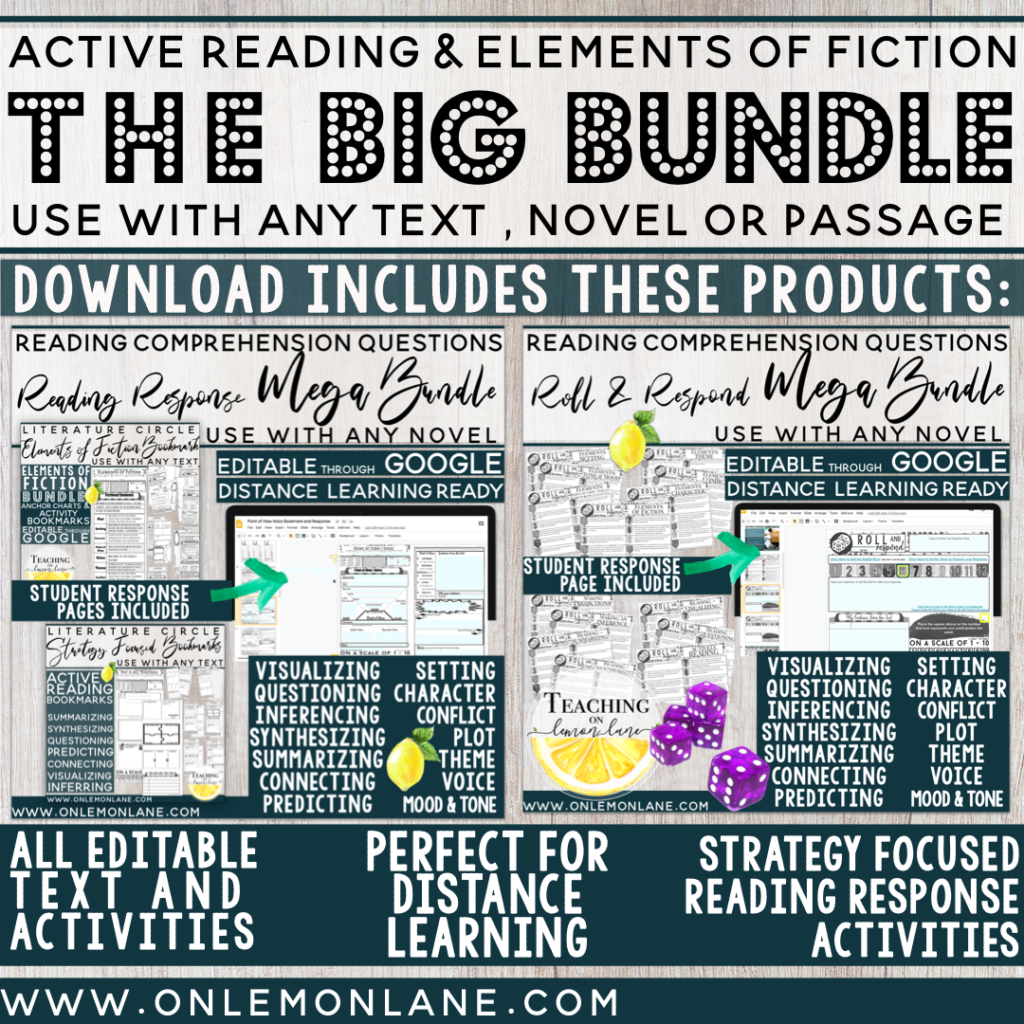
BIG BUNDLE: Element of Fiction & Active Reading Strategy Roll and Responds & Activity Pages
BEST VALUE: Click Here to Purchase on Teachers Pay Teachers
Watch the video above to see what’s included in the BIG BUNDLE
If you liked this, make sure to check out these related posts! (Freebies Included)
- If you would like to learn more about, ” How to Set up & Organize Literature Circles, Book Clubs, or Novel Studies in your Classroom,” Click Here.
- If you are looking to learn more about, “How to Get More Out of Your Literature Circles, Book Clubs, or Novel Studies with Strategy Focused Reading Assignments,” Click Here
- If you would like to learn more about, “Setting Up Your Classroom for Distance Learning, Virtual Teaching or a Modified Schedule,” Click Here
- If you would like to learn more about, “Why You Should Set-Up Literature Circle Roles|Jobs in the Upper Grades and How to Do So,” Click Here
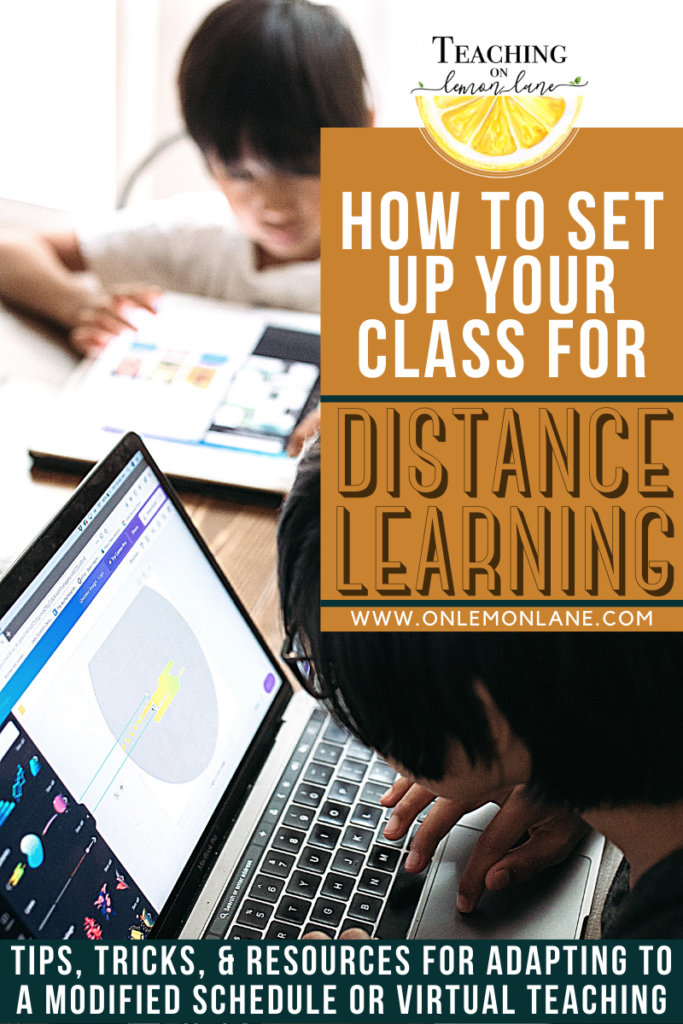
All Bookmark Products include Editable Bookmarks AND Digital Student Responses
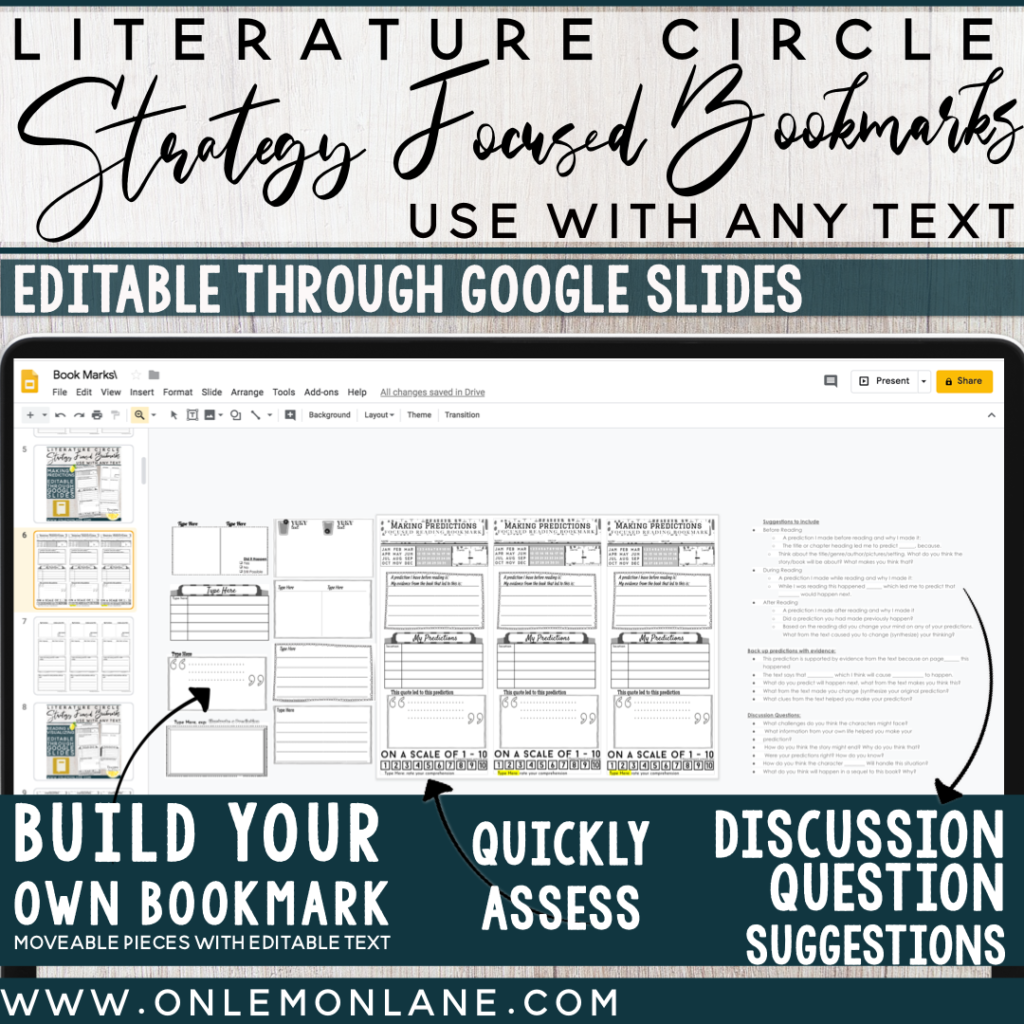
Bookmarks & Digital Response BUNDLES:
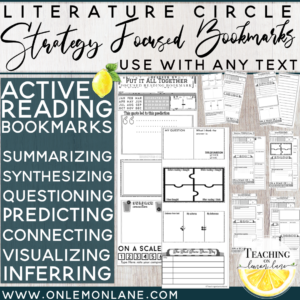
Active Reading Strategies Bookmark & Digital Responses BUNDLE
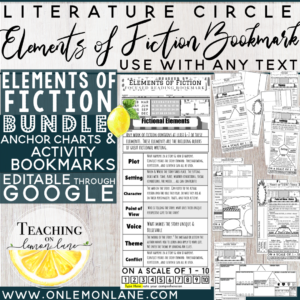
Elements of Fiction Bookmarks & Digital Responses BUNDLE
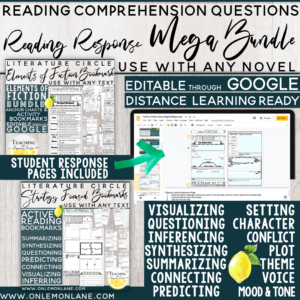
Active Reading & Elements of Fiction Bookmarks & Digital Responses BUNDLE
Individual Active Reading Strategies: Bookmarks & Digital Response
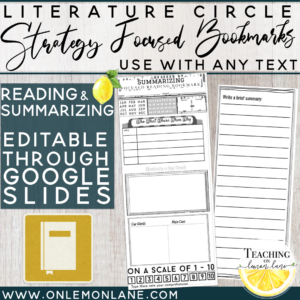
Summarizing Bookmark & Digital Response
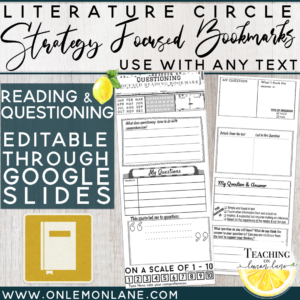
Questioning Bookmark & Digital Response
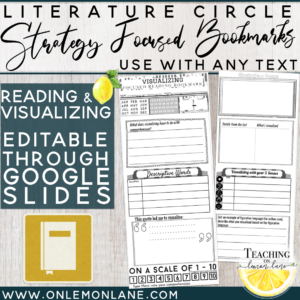
Visualizing Bookmark & Digital Response
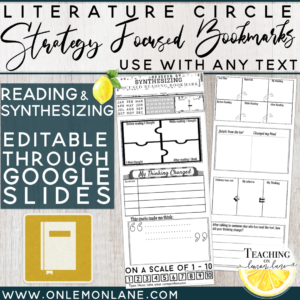
Synthesizing Bookmark & Digital Response
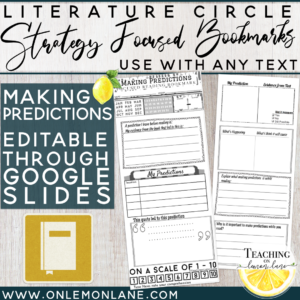
Making Predictions Bookmark & Digital Response
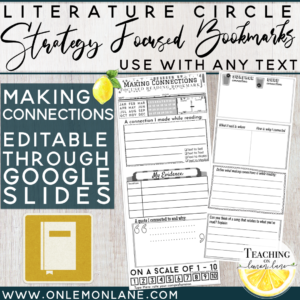
Making Connections Bookmark & Digital Response
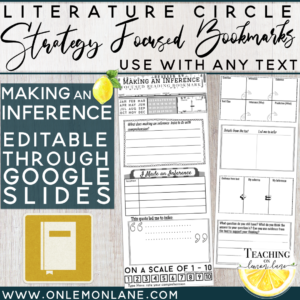
Inferencing Bookmark & Digital Response
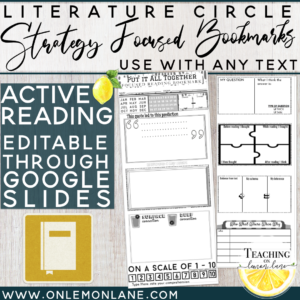
Active Reading Strategies Bookmark & Digital Response
Individual Elements of Fiction Bookmarks & Digital Response:
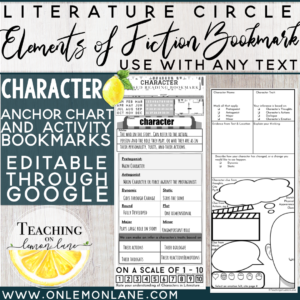
Character Bookmark & Digital Response
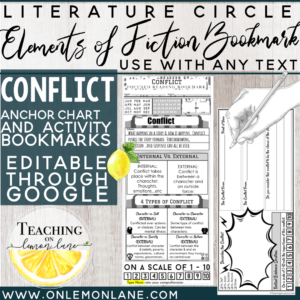
Conflict Bookmark & Digital Response
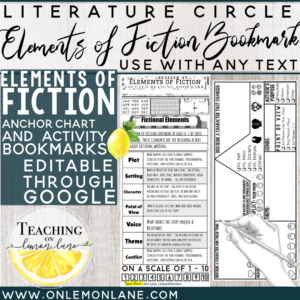
Elements of Fiction Bookmark & Digital Response
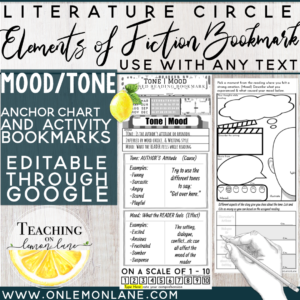
Mood/Tone Bookmark & Digital Response
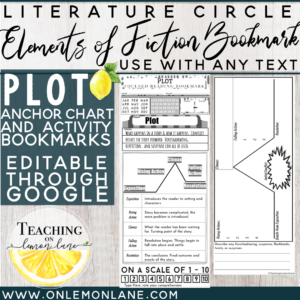
Plot Bookmark & Digital Response
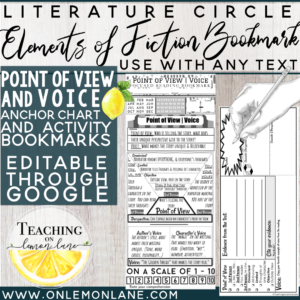
Point of View | Voice Bookmark & Digital Response
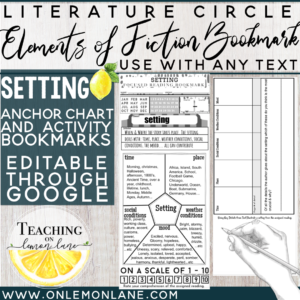
Setting Bookmark & Digital Response
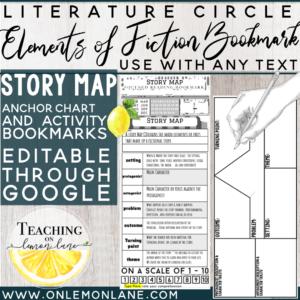
Story Map Bookmark & Digital Response
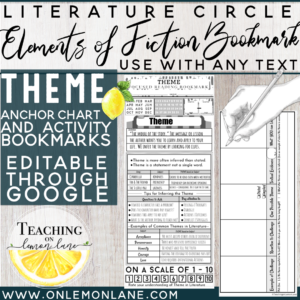
Theme Bookmark & Digital Response
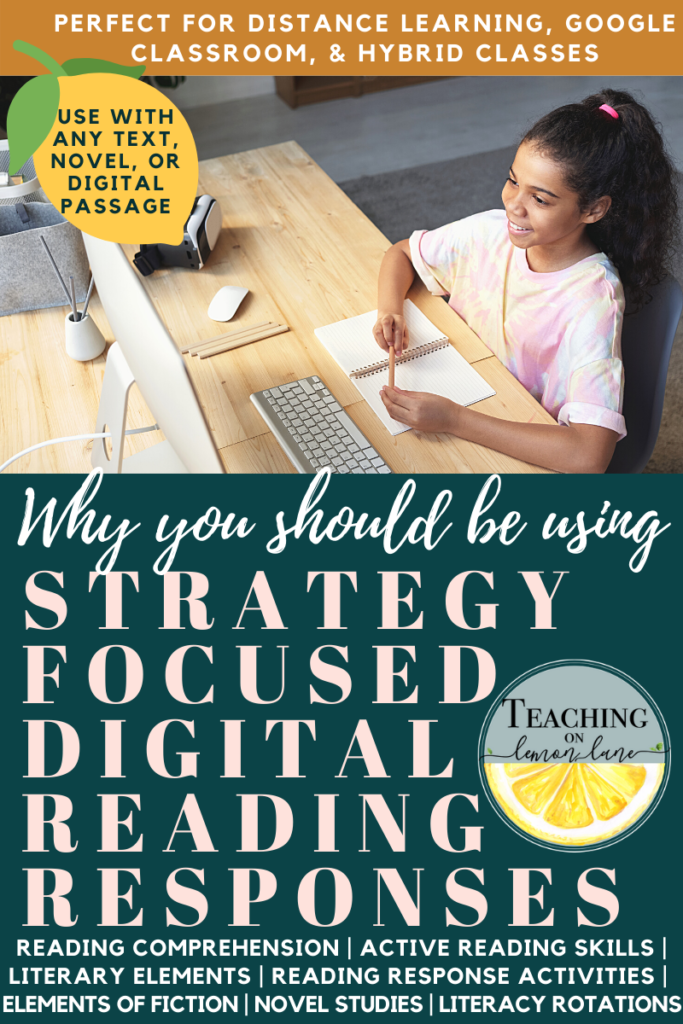
If you’re interested in only purchasing the Digital Student Response Pages, Click Here!
Stay in the loop, let’s connect!

To stay up-to-date on new blog posts, freebies, exclusive promo codes, and sales… Join the Teaching on Lemon Lane Community! Pick any or all of the following to stay in the loop of all things Teaching on Lemon Lane.
- Follow @TeachingonlemonLane on Instagram
- Like Teaching on Lemon Lane on Facebook
- Join our exclusive Teaching on Lemon Lane Facebook Group
- Sign-Up for our Monthly Newsletter: No Spam, only make your life easy-peasy, lemon-squeezy goodness… Promise.
If you enjoyed this PLEASE SHARE! Sharing on Pinterest, Facebook, or tagging on Instagram is a simple, yet wonderful way to support the efforts of Teaching on Lemon Lane!

- Become a Member
- Member Login
Inspiration & Creatives
Add a little zest.

Join the Newsletter
Let's be Friends!
📚 Adding a Little Zest to your Teaching! 🍏Fresh Ideas for Upper-Grade Teachers 💕Detail Oriented Products 🍋 Everything’s Better with a Little Lemon
No Thanks! I don't have an Instagram Account

Literature Circle Models
I’v experimented with many different types of Literature Circles, and this page includes an overview of the models I’ve tried. I had some success with all of them, but some of these models are only effective with students who are already motivated to read and do homework. Read through the overviews at the top of the page, and scroll down to learn more about the methods that interest you.
Literature Circle Models Overview
- Classroom Book Clubs – My favorite method is a flexible approach to Literature Circles that does not require the use of extensive handouts and assignment booklets. I call it Classroom Book Clubs because it’s a more relaxed method that seems like a club and not a reading lesson. It’s also highly effective for improving reading skills as well as promoting the joy of reading and helping kids connect through literature.
- Mini Literature Circles – Want a quick and easy introduction to Literature Circles? This method can be used with the leveled readers that come with many reading series.
- Literature Circles with Roles – I personally don’t recommend this model, but I’ve left information about it on this page because many people have heard of it. I have not found it to be particularly effective with all types of learners. Read Harvey Daniel’s book Literature Circles: Voice and Choice in the Student Centered Classroom to learn about this model. You can find a simple version listed below on this page, but if the model appeals to you, you would enjoy Harvey Daniel’s book. Be aware that Harvey Daniels himself no longer advocates this extensive use of this model, but there are many other wonderful ideas in the book.
- Nonfiction Literature Circles – My newest addition to this collection of Literature Circle strategies is Nonfiction Literature Circles. Adding nonfiction has been one of the missing pieces of the reading puzzle for me!
- Literary Lunch Bunches – These are fun, informal Literature Circles that kids attend on a voluntary basis. The program is called Literary Lunch Bunch because you hold the meetings during lunch, in your classroom or another quiet area (such as outside at a picnic table).
Classroom Book Clubs
Watch this short video to how Classroom Book Clubs work!
After 15 years experimenting with Literature Circles in my classroom, I finally found an approach that students enjoy, an approach that’s free of cumbersome management systems. In the video below, I share 7 steps to Classroom Book Clubs success!
Mini Literature Circles using Leveled Readers
Are you required to use a basal reading program in your classroom? Many programs have leveled readers that can be used to introduce Literature Circles. Leveled readers are thin paperback stories or nonfiction selections, and they are written on a variety of reading levels. A Mini Literature Circle can be done in one or two days depending on the time allowed. Here’s how:
- Assign 3 or 4 students to a leveled reader based on their reading level. Alternatively, allow students to browse through the selection and choose the group they want to join. If you have 6 or 7 copies of each book, split the group in half for the Literature Circle discussion since the groups seem to work best with 3 or 4 students.
- Give class time for students to read the leveled reader alone, with a partner, or with audio support.
- Then provide a Journal Prompt such as the ones described in the section above.
- Allow class time for students to write a response, and then form discussion groups.
- Print out the Mini Literature Circle directions, and give to one person in each group who will serve as the discussion leader. Each person will need 2 popsicle sticks or craft sticks for the Talking Sticks discussion method used in this activity.
- As the students meet to discuss the book, circulate through the room to observe their discussions and interactions.
Literature Circles with Roles
Some students enjoy having roles within their Literature Circles, although many teachers find Literature Circles with roles to be less effective with students who aren’t already motivated to read. Personally, I found that assigning roles prevented deeper discussion of the book.
If you do want to try this method, download and print the Literature Circles Preparation Form . Give students a copy of the Literature Circle Role Descriptions . Make one Role Finder Dial per team. Assign each person on the team one role and have them prepare their assignment as described. On the day of the meeting, all students complete their worksheet during the meeting itself. For the next meeting, turn the dial one place to see the new role assignments. Students keep rotating roles until they finish their book.
Nonfiction Literature Circles
Eventually, I began to experiment with Literature Circles using nonfiction books, and at first I used the same basic format as my fiction circles. Then I realized that nonfiction books are different and the meeting structure could benefit from some tweaking.
First, I developed some Nonfiction Response Questions for their Reading Response Logs. Then I decided to allow students to read together every day since the text is generally more difficult for them. They don’t do well with reading on their own when the vocabulary is so challenging. They also seem to like to talk about all the new things they are learning. So now we have what we call “reading days” and what we call “meeting days.” On the reading days they simply read together and take notes on what they are reading. They may stop and discuss the material, but they shouldn’t get bogged down for too long.
When they finish the book, we schedule a Meeting Day. Prior to the meeting, they have to write a response in their Reading Logs. On the day of the meeting they read their responses and discuss what they thought of the book. I try to meet with each group for a few minutes, and I generally have a set of discussion cards prepared that they can talk over together.
Before the meeting, I prepare a different set of question cards for each book, and the questions guide them through some of the more important points of the book. (See sample – Whales and Dolphins ). Finally, they take their computer test on the book and complete the Nonfiction Reflection Form . Here’s a blank Discussion Card Template you can use if you would like to make your own cards for reading discussions.

Inspired Elementary
Teaching ideas that inspire a love of learning
Join the Newsletter
Literature circles 101.
Literature circles in the elementary classroom are one of my favorite ways to boost students’ reading engagement and get them excited about reading! After successfully launching literature circles in my 4th grade classroom, I knew that when I moved down to 2nd grade, I had to find a way to make literature circles work there as well. After establishing routines and creating new resources, my students THRIVED IN LITERATURE CIRCLES and I will never teach without them again!
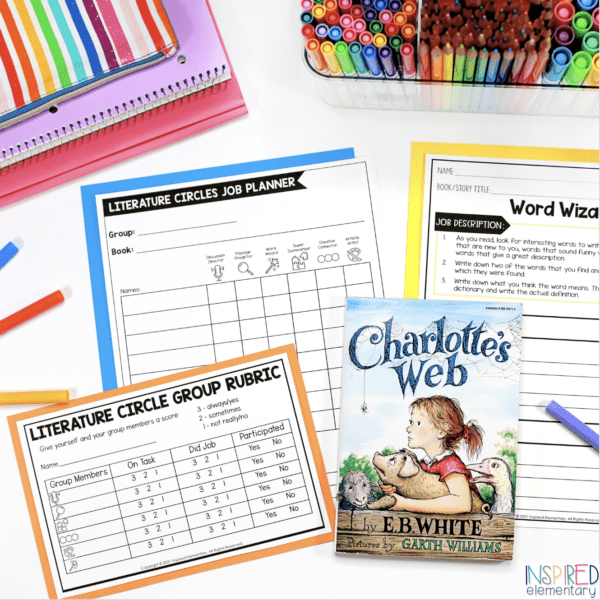
The KEY TO LITERATURE CIRCLE SUCCESS is HOW you introduce them!
I have been fortunate enough to coach many 2nd-5th grade teachers on how to implement literature circles, and I have put together a FREE LITERATURE CIRCLES TRAINING that will teach you my step-by-step process to planning, organizing, implementing, and managing literature circles . You can access the FREE training on LITERATURE CIRCLES MADE SIMPLE HERE!
But if you want just a quick overview of literature circles before diving into the one-hour training, here’s the gist….
SMALL GROUP ROUTINES ARE KEY!
- Students have to know how to work in small groups in order for literature circles to run smoothly. In both my 2nd grade and 4th grade classrooms, students were well accustomed to working together in small groups. After the first two months of school (usually November) is when I began teaching the literature circles jobs. We didn’t actually begin literature circles until December or January.
PRACTICE THE JOBS AHEAD OF TIME
- Around November (second month of school where I live) I introduce the concept of literature circles.
- I use a specific process to teach the different jobs.
- I created six jobs for grades 2/3 and eight jobs for grades 4/5. The wonderful thing about the job sheets is that they are differentiated, so really, I could use what best suited my students’ needs.
- For primary grades (2nd/3rd), I introduced one literature circle job a week. For upper graders, I introduced two jobs per week.
- We would use our grade level anthology to practice each job. After completing a reading section together, I would give all students the same job sheet and we would complete it whole class. This allows students to ask questions for clarifications. It also allowed me to model what a complete job sheet looked like vs. an incomplete job sheet.
- Once we have gone through all the jobs, students are ready to begin literature circles.
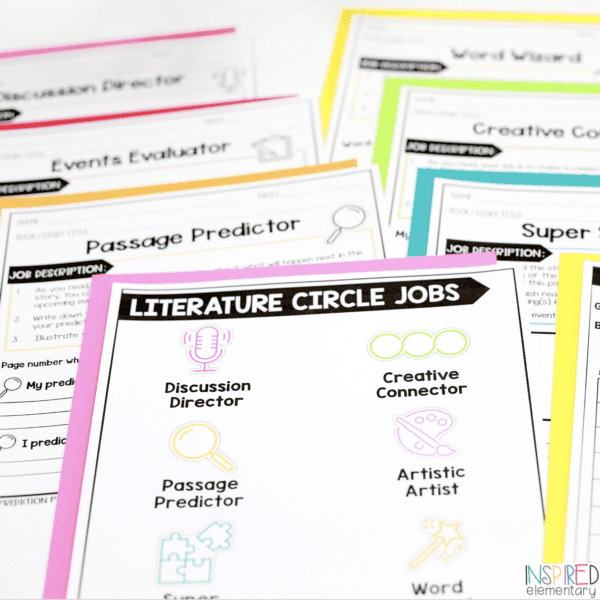
Here are the eight literature circle jobs:
- Discussion Director
- Creative Connector
- Passage Predictor
- Super Summarizer
- Artistic Artist
- Word Wizard
- Spotlight Seeker
- Events Evaluator
FORMING GROUPS
- I have ran literature circles in the classroom with both homogeneous and heterogeneous reading groups. I prefer to group students who are reading at a similar level because this allows me to differentiate and challenge my students that need a push.
- For 2nd and 3rd grade, I like to start literature circles by reading the same short chapter book as a whole class.
- For 4th and 5th grade, students get to go “book shopping” and select their books and we begin literature circles.
- We begin with a pre-reading activity to get students excited about their books (“Book Cover of Predictions” activity is my favorite).
- Once groups have their books selected, I pre-plan out the pace of reading for each lit. circle group. I use a Student Planning Page to divide up the reading for each book, as well as pre-assign jobs. This makes transitions smooth from group meeting to group meeting, because students already know what job is next.
- For older students, and ones that can work really well together, I have let them independently choose which job they want to do next. The rule is that they just can’t repeat a job before doing all the others.
BEGINNING LITERATURE CIRCLES
- For the first day of literature circles, I assign students their literature circle job and have them get together in their group to read the first chapter (or two). For 4th and 5th graders, this is usually the only time they read their book together in class. However, in 2nd and 3rd grade my structure is a little different and students have reading time in class and job completion time in class. Whatever they don’t finish becomes homework.
- After the initial reading together, students go back to their desks and independently complete their job. If they don’t finish it in time, I assign it as part of their homework.
- The next day, students meet together in their literature circle group and share their completed job sheets. Students use “Literature Circle Discussion Prompts” to use for any extra discussion time.
- I use a Group Agenda, so students know their order and stay on track with the time.
- When lit. circle time is up, I collect job sheets and give out the new jobs for the next portion of reading. I like to organize the jobs in a file crate that students can easily access the job sheets.
- I assign the next chunk of reading for each group and students complete that independently during class reading time or as homework.
MANAGING LITERATURE CIRCLES
- When students are meeting in their literature circle groups, I like to float from group to group to listen to their discussions. Remember, literature circles are student led, NOT teacher led!
- The Discussion Director writes down notes on their job sheet to report about group time. I also use Group Rubrics so students can rate their group members’ participation and job completion. These can be used towards participation grades or just as an informal check-in tool.
- When groups finish up their books, I like to give them a final book project.
LITERATURE CIRCLES RESOURCES…
If you are ready to jump in and start literature circles in your classroom, I have created a comprehensive Literature Circles Made Simple resource, that includes ALL THE TOOLS you need to effectively launch literature circles!
This resources includes differentiated versions of each job sheet , so you can pick and choose what bests suits your students’ needs! Group rubrics, planning pages, job slides, and more are all included to help you run literature circles with ease! There are also included Google Slides™ versions of each job sheet, planning pages, and more!
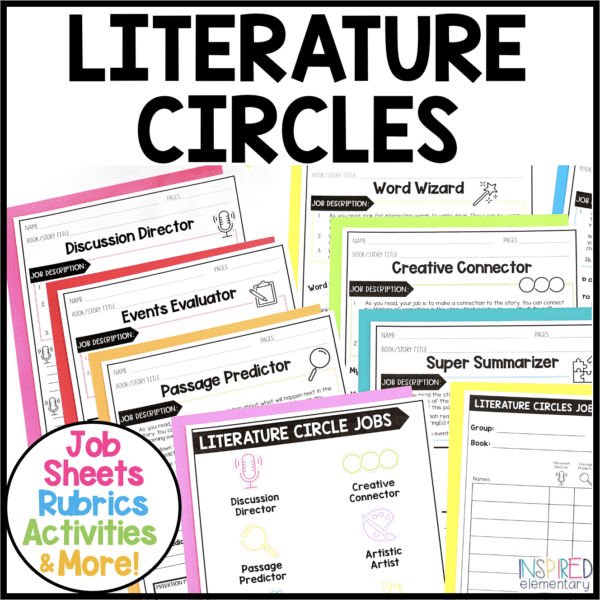
I LOVE literature circles and I LOVE that they can be done in both primary and upper grades! I hope you will give them a try in your elementary classroom!
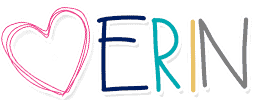
January 9, 2016 at 10:09 pm
I am starting lit circles (for the first time EVER) with my second grade RTI group on Monday. Nervous, but grateful to have found your amazing (and free!!!) resources. THANK YOU!
January 22, 2016 at 3:51 pm
Do you have any recommendations are great literacy circle books?
February 1, 2016 at 8:32 pm
Hi, Laura! Yay! I am so excited that you got literature circles going in your class. Second grade is the perfect age to introduce them. I hope they are off to a great start!!! Erin
October 22, 2016 at 9:30 pm
Quick question- I purchased your Literary Circles packet and am going to get the Comprehension packet as well…but how do you split your groups when there are 27 kids. Do you just drop some jobs from that group then? I'm trying to incorporate this – not with novels but with my 4th graders and our Reading Street Stories. Thanks!
October 25, 2016 at 6:45 pm
Do you switch their jobs weekly or switch them when they start a new book?
Thanks for any info!
May 16, 2017 at 2:32 am
Hello! It depends on the book. 🙂 If it is a longer chapter book, then I switch jobs every time I assign a new chunk of reading. That can mean two different jobs for the week. If it is a shorter book, that students will finish within a week, I have them only do one job. I hope that help and thanks for the question. I wish you all the best! Erin
January 20, 2017 at 2:44 am
Hello! I teach a very struggling third grade group (many on first grade level, high students are on level). Once you moved away from anthology stories, did you change groups so that they were levelled as opposed to mixed? Also on Wednesdays, what kind of whole group activity went on as a literature circle activity?
May 16, 2017 at 2:50 am
Hello! Thanks so much for your question! I definitely try to keep literature circles mixed, especially when starting them out. Even after moving away from the anthology stories, I like to have mixed groups for the first few chapter books, too.
However, because you have such a handful of third graders that are struggling, I think leveling them might be more appropriate. I think it really depends on the group of kids that you have each year, whether or not leveling them is necessary. When students struggle so much with a text, it makes it almost impossible for them to do their lit. circle "job." That is why leveling them and giving them a text that is more appropriate will help them be successful in lit. circles.
As for the Wednesday activity, this is during the anthology reading. We take a break from lit. circles for a day to work on a whole-class comprehension activity. It varied week to week, but that's what the time was designated for.
I would love to hear how literature circles went for you this year! I'm so sorry it took me so long to respond, I somehow missed your comment. Please feel free to email me at [email protected] .
Have a wonderful rest of the year with your third graders! Erin
October 7, 2017 at 2:30 pm
Thankyou for this wondrous post, I am glad I observed this website on yahoo. UK
March 15, 2018 at 12:50 am
Do you have a recommended book list for students in third grade?
July 8, 2021 at 3:25 am
Oh my! As I was reading the blog post, I just kept thinking how AMAZING it sounded. As I kept on scrolling, I couldn’t help but feel nervous about what type of money I was going to be hit up for. I am AMAZED and SO THANKFUL that you are so willing to share this free resource. I am SO excited to start this with my Year 3 Aussie kids!
Leave a Reply Cancel reply
Your email address will not be published. Required fields are marked *
Notify me of follow-up comments by email.
Notify me of new posts by email.
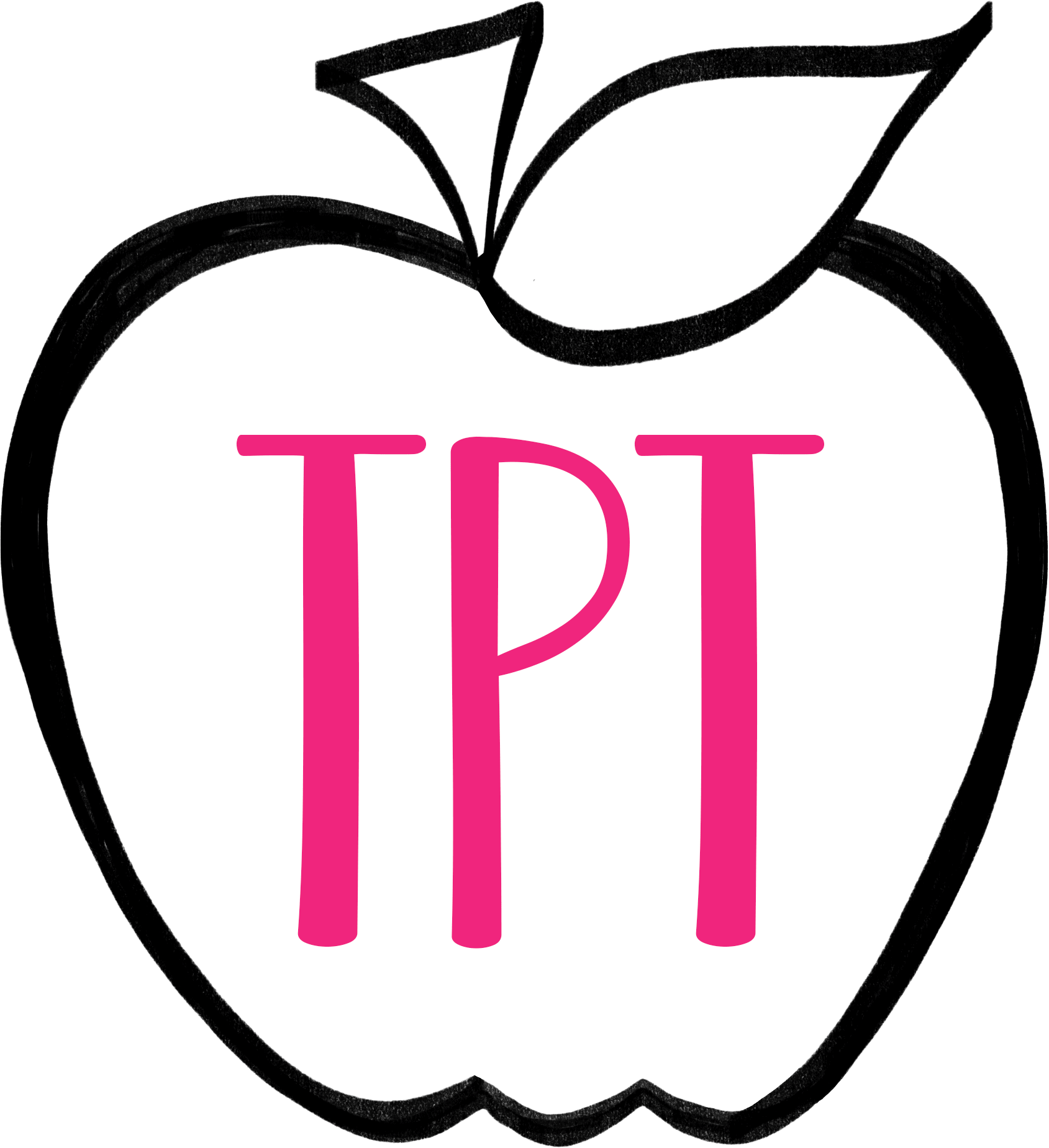
Quick Links
- Hi, I’m Erin!
- Disclosures
- Privacy Policy
- SOLVE IT STRIPS
- SIGHT WORDS
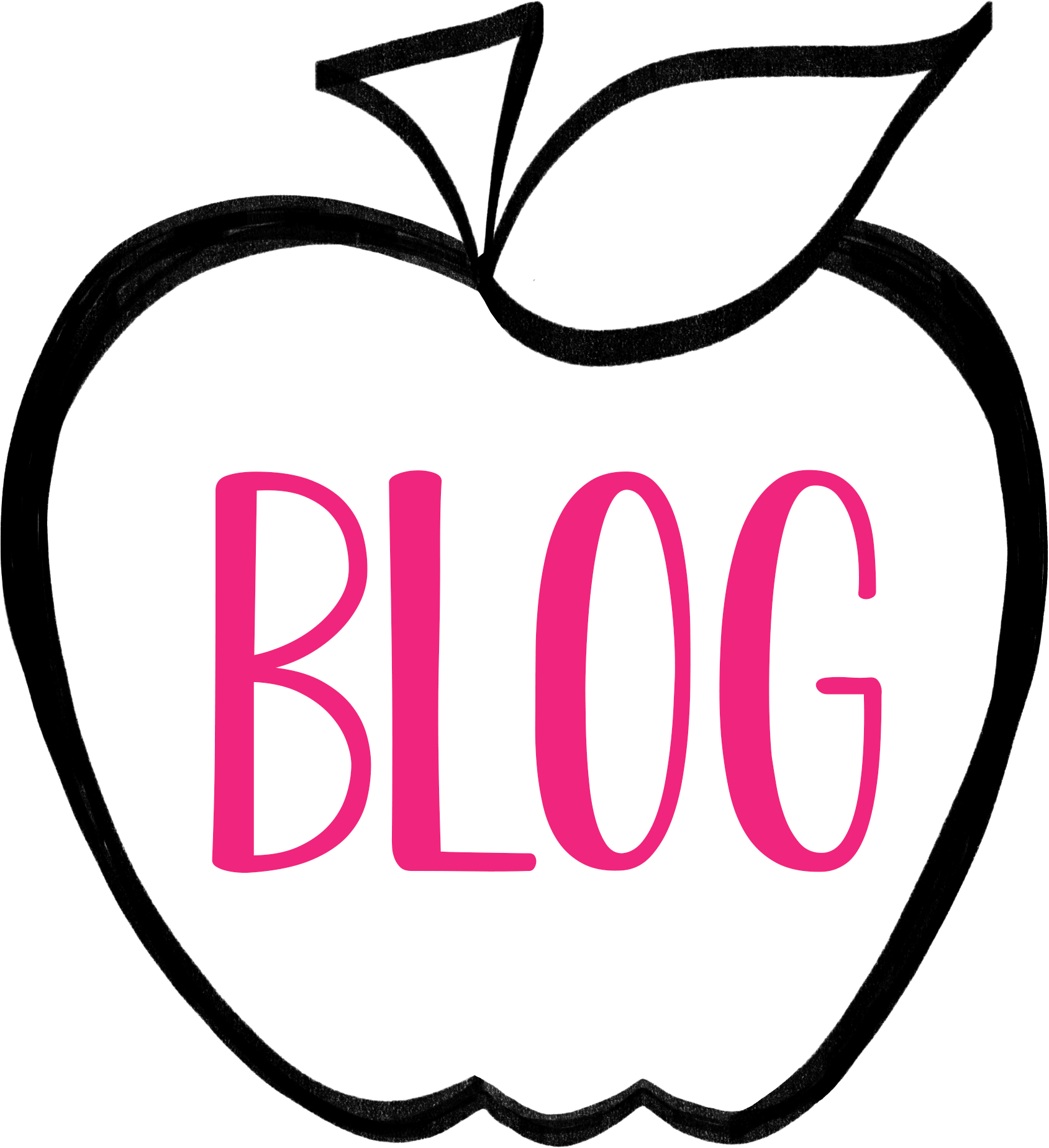
- Our Mission
How to Create a Classroom Literature Circle
This book-discussion method is simple to set up in class but requires preparation and flexibility.
This how-to article accompanies the feature " Classroom Literature Circles Expand Thought ."
Teachers who want to try out literature circles need to know one thing -- no two circles look the same.
"It's an approach that's so different in every classroom," says Katherine L. Schlick Noe, an education professor at Seattle University who has written extensively about literature circles. "So many people use them in different ways."
The keys to success are simplicity and adaptability. And although it might seem that the most logical subjects in which to use literature circles are those heavy in reading, such as language arts, history, and English, they can be used in other subjects. A high school science teacher in North Carolina, for example, uses literature circles to help her students understand complex scientific terms.
Noe advises teachers to give students one thing to think about and put the emphasis on the conversation, starting with a five- or ten-minute discussion. Teachers can set up the circles so that each group meets one at a time, with the teacher sitting in, or so that all the circles meet at once, and the teacher circulates among them.
A common mistake is for teachers to give students too much to do, such as a long list of questions or complicated projects. Their energy then goes into the tasks rather than delving deeply into the books, Noe explains. She suggests students use Post-it notes to mark passages or pages they want to discuss, or write down a quote or a thought as they're reading to prepare them for the circle discussion.
Here are a few tips:
- Offer students a choice. Sixth-grade teacher Alisa Gladstone says letting her students pick a book, a theme, and a project gives even the most reluctant reader a vested interest in the material.
- Don't dominate the discussion. Part of the fun is seeing where the students go in the circle. Teachers should observe, offer feedback, and gently guide things back on track when necessary, but they should not micromanage.
- Encourage reflection. After the students finish their circle, have them write about what they thought of the discussion. For younger students, it can be a few sentences. For older students, it can be a stream-of-consciousness-style journal entry.
- Assign a project. Many teachers have their students do projects at the end of the book discussion. This is an especially effective way for the nonverbal students to express themselves, Noe says. Some of Gladstone's students did maps, acrostic poems, and timelines. First-grade teacher Jennifer McFarland's students have done puppet shows, dioramas, and a story quilt.
- Be aware of common pitfalls. Students who read too far ahead and give away the ending, students who are unprepared, and discussions that go too far off track can derail a literature circle. McFarland talks to parents at the beginning of the school year about making sure their children don't read beyond the assignment.
Get Around to Circles
To get more information on literature circles and additional tips on getting started, check out these Web resources:
- The Literature Circles Resource Center provides examples from teachers of different methods, resources for doing theme units, and suggestions for how to choose books and projects.
- This video from Carol Morgan School, in Santo Domingo, Dominican Republic, shows a literature circle in action.
- Teacher Jennifer McFarland's classroom Web page includes examples of literature-circle projects.
- LiteratureCircles.com includes reviews of books that work well in literature circles.
Alexandra R. Moses is a freelance writer in the Washington, DC, area who specializes in education.
- Skip to main content
Welcome, Fellow Math Enthusiast! I’m so happy you’re here!
- Counting & Cardinality
- Addition & Subtraction
- Multiplication & Division
- Place Value & Base Ten
- Measurement & Data
- Geometry & Fractions
- Vocabulary & Discourse
- Math Manipulatives
- Classroom Management
- Classroom Organization
- Holidays & Seasonal
- Social-Emotional Learning
- Privacy Policy
- Terms of Use
- SHOP RESOURCES
- BECOME A MEMBER
- Search this website
Teaching with Jillian Starr
teaching little stars to shine brightly
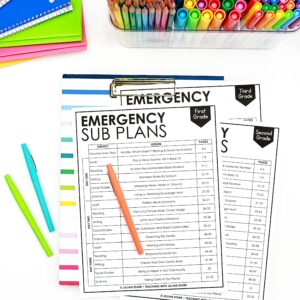
Free Sub Plans (Grades 1-3)
Get 3 FULL DAYS of sub plans so you can take your sick days when you need them! Zero-prep plans AND editable templates to customize your classroom info and routines!
How I Introduce Literature Circles (Book Clubs)
In the second half of the year, students really start to find their groove. They have revisited the routines and expectations after their vacation, and most are starting to exhibit more independence. This has always been the PERFECT time for me to introduce Literature Circles (or Book Clubs) to my reading groups.
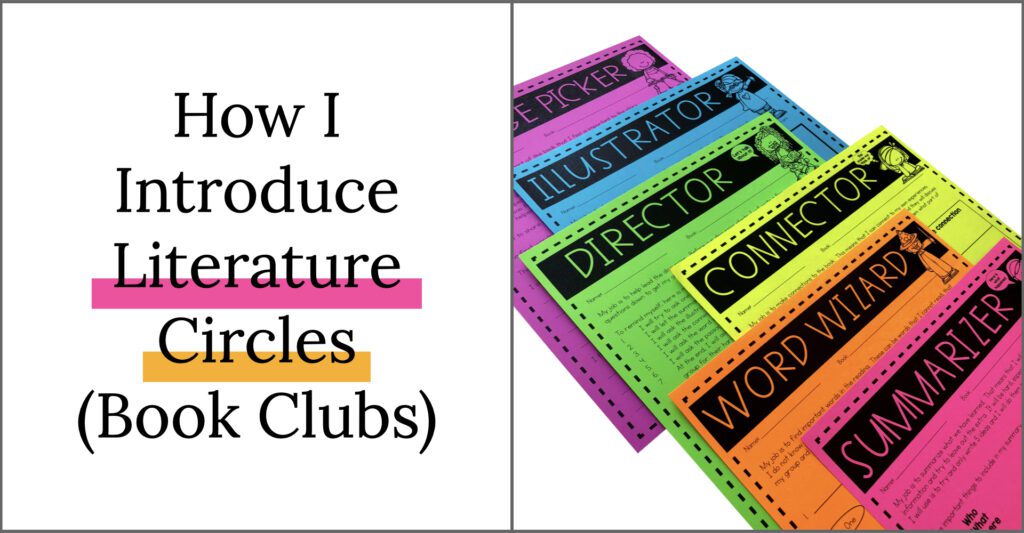
If you’re not familiar with Literature Circles, I like to think of them as a structured book group. It’s a great way of helping students engage in independent discussions around a shared text. There are multiple roles, and each student is given a specific role for the duration of a conversation. These roles include Discussion Director, Word Wizard, Passage Picker, Illustrator, Connector, and Summarizer.
Depending on the grade level I’m working with, my rollout may look different. For example, in first grade, I typically venture into Literature Circles with my group(s) that are reading beyond the end-of-year benchmark. That is not because I don’t feel like my other students can handle the responsibility of independent work, but rather, there are skills and strategies that I would prefer to be our focus within those groups. However, in third grade, I make it a point to include Book Clubs in all groups, but use their level of independence and engagement during our reading groups as an indicator of readiness.
Today I want to discuss HOW I introduce literature circles to my students to ensure that they can successfully run these groups independently during our reading block. If we are going to focus on a single word during all of this, it would be EXPLICIT!
Introducing Literature Circles with A Teaser
I start the introduction within my small group reading time. After a regular reading group meeting, I give them a little “teaser” at the end.
“Next time we get together, I am going to share something really exciting with you! Have you ever heard of grown-ups having a Book Club or a Book Group? It’s when a group of people get together and they get to talk about a book they’ve read. Often times one person helps run the conversation, and the rest of the group each take turns discussion different parts and it gets to be a really great conversation. The next time we meet, I’m going to teach you all about running your own book clubs (without the teacher). It’s a big responsibility, but I think this group is ready for the challenge!”
The level of excitement they show is SO worth this little preview! Then, they come to our next meeting BEYOND ready and willing to listen!
Introducing Literature Circles as Book Clubs
When I reconvene with my group, I like to start by revisiting my summary of Book Clubs from the day before, just to refresh their memories. Then, I move into explaining WHY I think Book Clubs will be a great choice for their group.
It usually includes language around how their ability to understand books, and the focus they’ve shown during independent reading time. I also make sure to mention that I’ve watched how they talk about books together in the group, and how much I want to give them MORE chances to do that outside of our reading group.
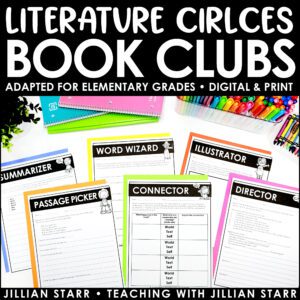
Literature Circles
One thing I steer clear of during this conversation is equating their readiness for Book Clubs with a love of reading. The reasoning behind this is that many of my students who are earlier on in their understanding of reading can have an equal love of reading. They just may need to be focusing on a different set of skills at this time. As a struggling reader myself, this is ALWAYS at the front of my mind.
I explain that Book Clubs are not just sitting around talking about a book! That can be really fun and helpful too, but our Book Clubs are different. With our Book Clubs, there is a structure, called Literature Circles. Everyone in the group will get a different job/role and each one gives a different way to share about the book. Every person will get a turn to share their work for that job during their group time, and your job will change each time (so don’t worry, you’ll get to try them ALL out!)
Then, it’s time to introduce the format of these different roles of that make up the Literature Circle.
Introducing Literature Circle Roles
The discussion director.
I explain that the Discussion Director acts as the leader of the group for the day. Their job is to run the group and make sure that the conversation goes smoothly. I make sure to let them know that EVERYTHING they need to do will be given to them, so they don’t have to worry about remembering. This usually alleviates ANY worry and helps them focus on the excitement of what’s to come.
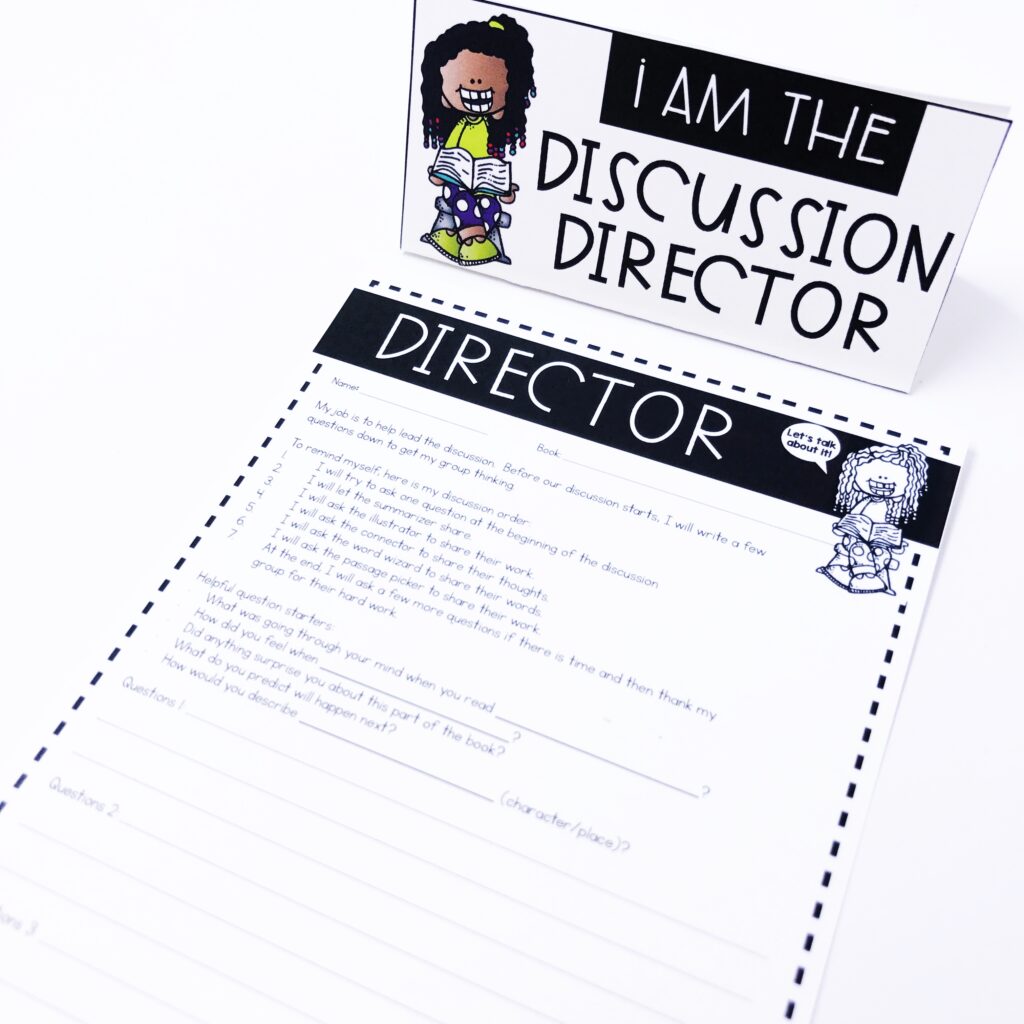
I take the time to share possible questions the discussion director could ask to keep the conversation going during literature circles. I show them the page that they can use to support them, and that it includes the order of people the director asks to share. (e.g. After a few conversation starters, the Discussion director asks the Summarizer to share their work.)
The Summarizer
The summarizer can be a difficult role during literature circles. I like to model summarizing with a familiar story. I show the group the “Summarizer Page” and explicitly show how I can use the prompts and keywords to help me summarize that familiar story.
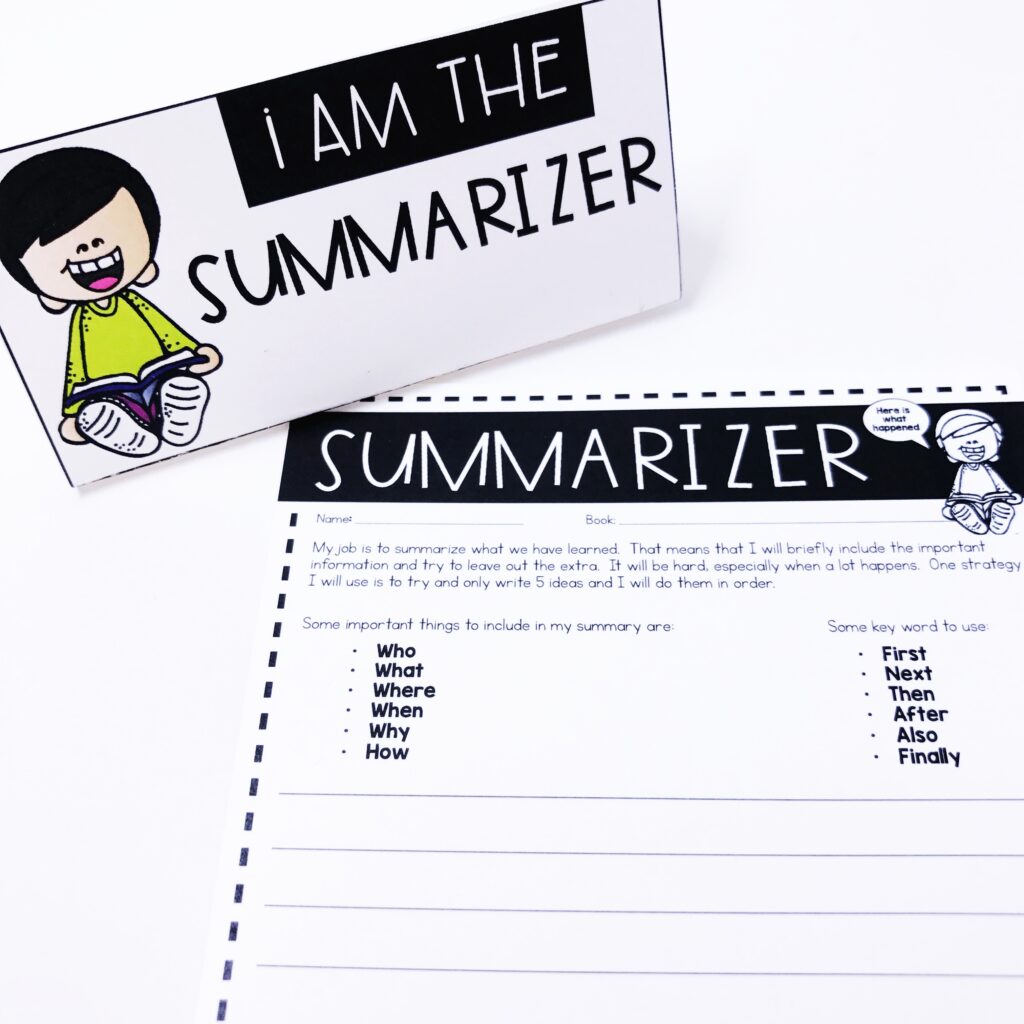
Then I sometimes pick a second familiar story and ask the students to do the summarizing (aloud). We go through each of the prompts and keywords, and I record their responses on the sheet to demonstrate. Together we come up with a cohesive summary and students can later reference that example when working independently.
The Illustrator
The illustrator is usually the favorite role of my students during literature circles. I introduce the idea that students can pick a favorite part or what they believe to be an important part of the book, and then illustrate that scene. I ask them to do it without the book in front of them (I always have perfectionists who understandably want their work to resemble the book…but I stress that we want to see THEIR interpretation).
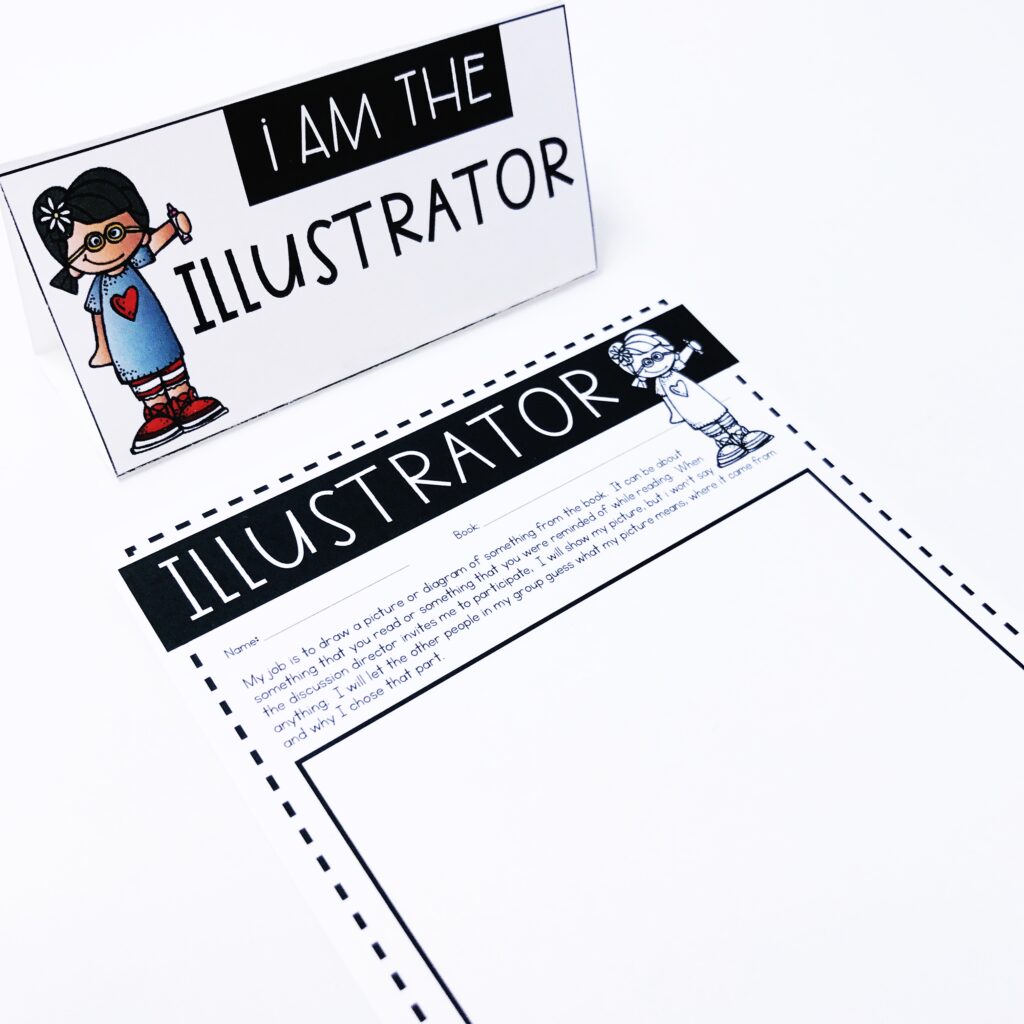
I then explain that the illustrator does not tell the rest of the group what they have drawn. Instead, their group examines their work and it is the group’s job to try and uncover what part of the book was illustrated. Only after the members of the group have made their guess, does the illustrator confirm (or deny) the guesses, and then share WHY they picked that part of the text.
The Connector
The connector may be one that you need to give a little more time to as you introduce literature circles, depending on how much you have discussed text connections with your class. For students to be successful in this role, they need to have an understanding of text-to-self, text-to-text, and text-to-world connections.

Once this understanding is established, I go through how the connector uses their role page to record the different types of connections they made throughout the text. Once they get the hang of it, it actually comes quite quickly for them! We then discuss how students can share out this work by describing some of the connections they made, and asking if their peers had any other connections they would like to add.
The Word Wizard
The role of the Word Wizard in Literature Circles is to draw our attention to the vocabulary within the text. I explain that students can choose words for a variety of reasons:
- They cannot read the word
- They don’t know what the word means
- They think it was a great word choice/juicy word
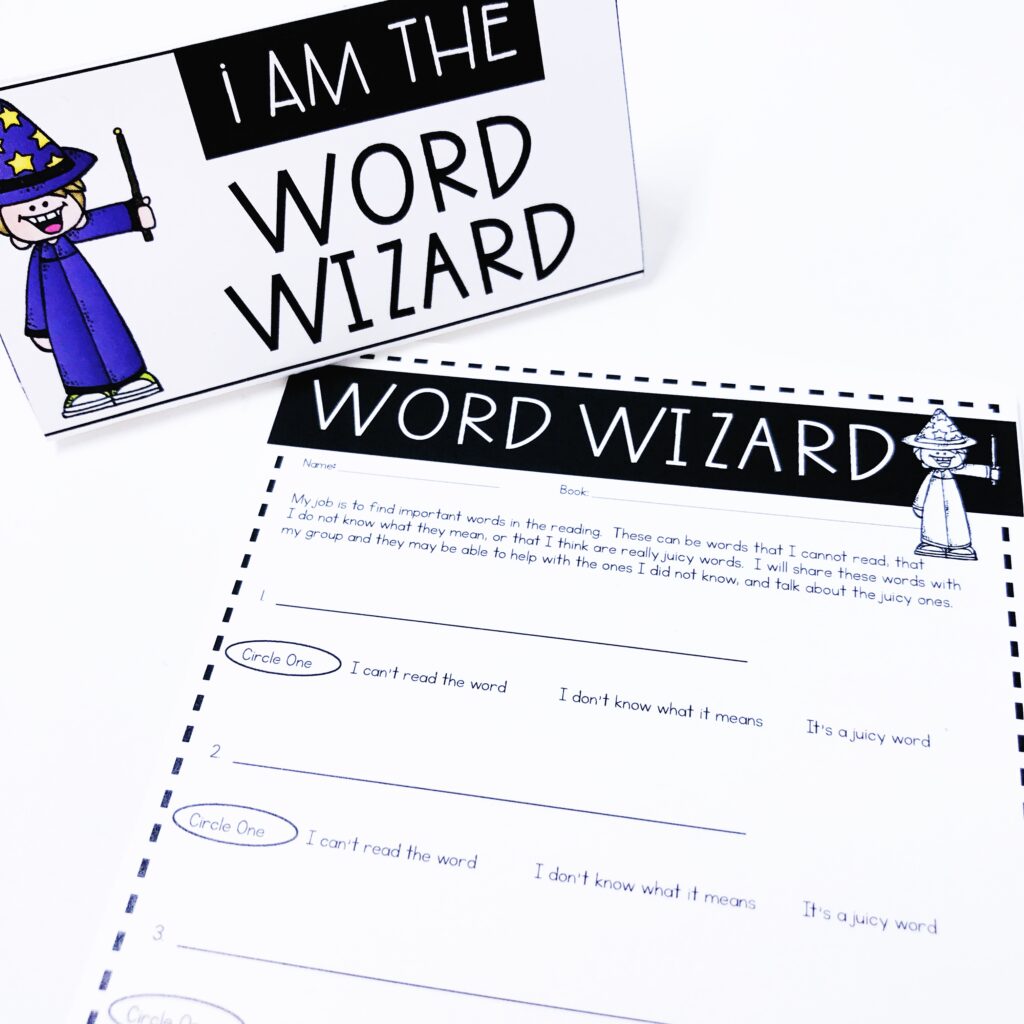
These words make for great conversations during the discussion. I love when their peers help them read an unfamiliar word, or listen to the definitions they provide. It’s a great way to naturally enhance and reinforce strong vocabulary.
The Passage Picker
The passage picker is the role that I give as an “extra” if I have more than 5 students participating in literature circles. It’s not because I don’t love this role, but because I think there are elements of it that can be covered in different roles. Nonetheless, I introduce it to my students.

I explain that the passage picker gets to choose ONE small section of writing, called a passage, from the text that stood out to them. This can be because it surprised them, they liked the imagery, it gave them a clue about what was coming next, it made them laugh…etc.
I love listening to the student’s reasoning behind their selection, and then listening to the reaction from their group. “That made me laugh too!” or “Yes! That’s when I KNEW he wasn’t going to give up without a fight!” It’s a great addition if you have enough students to fill the role.
Putting It All Together
After explicitly teaching each of the roles within Literature Circles, and modeling how the Discussion Director can end the meeting, I explain the next steps.
I tell students that during our next reading group, we are going to practice a round of literature circles. I let them know that I will be there to support them, but I will really just be watching and not interfering unless they need me. I have found this gradual release of responsibility the best way to ensure that students are successful with this model.
If all goes well during their first round, I give them the option to try it on their own later that week during a reading center rotation. If I think they might benefit from some additional support, we typically give it another go during our reading group time, where I can be there to help facilitate.
How Did it Go?
I like to finish literature circles by having students reflect on how they feel the group functioned that day. I give them a quick “group check-in” form that acts as a rubric. I have students complete them and turn them in privately.
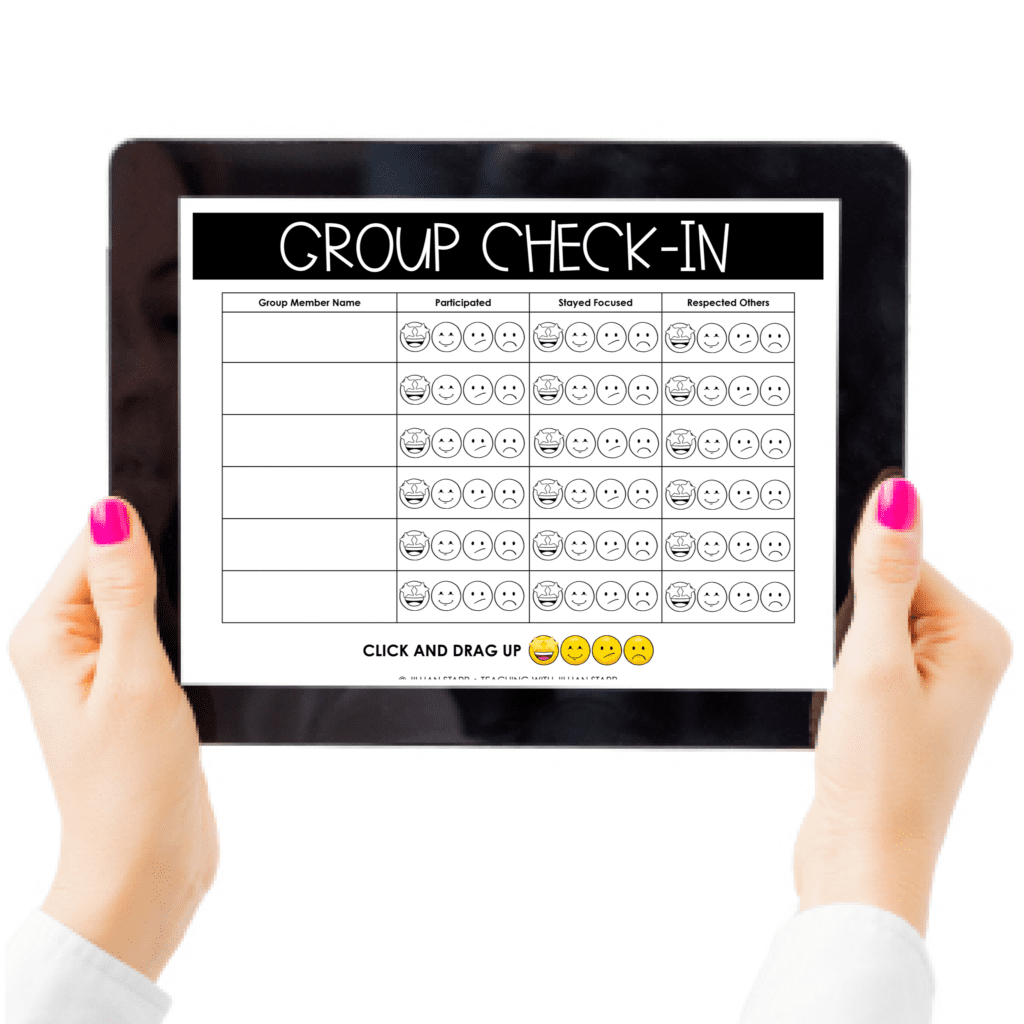
I also let students write any additional information they wish to include on the back. This allows students a safe place to share their thoughts, as well as anything that may have come up that I should be aware of.
I use these reflections to guide future conversations with the group and try to help problem-solve any issues that may have come up.
Taking Literature Circles Digital
During remote learning, literature circles are a WONDERFUL answer to making reading groups work! I have included ALL of these role pages and reflections in a digital form . This way, students can complete these pages during asynchronous learning time, and then come together in small break-out rooms to have meaningful conversations around shared text!
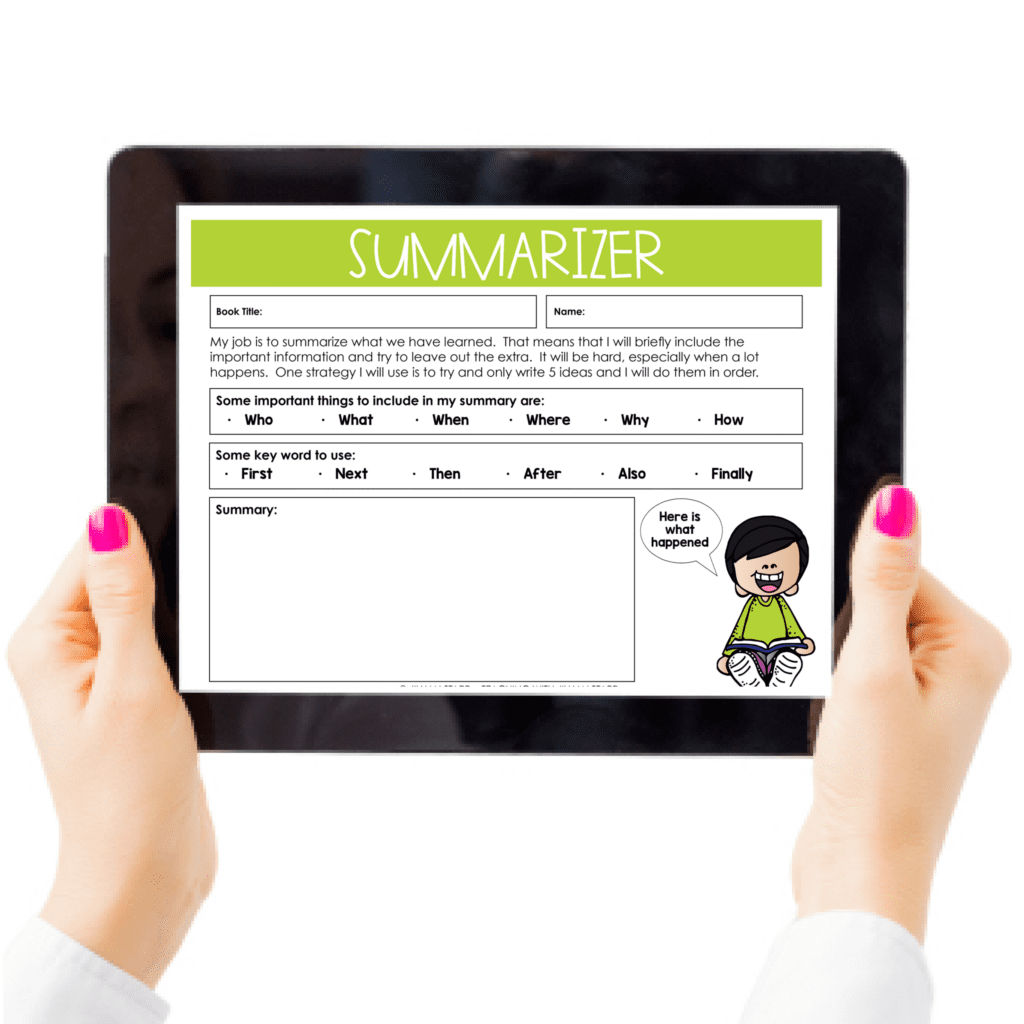
What text should I use? While it’s difficult to put physical books in students’ hands during remote learning, you can definitely use apps and websites like Epic and Reading A-Z and others to offer shared texts to your students.
Tools For Literature Circles
I LOVE literature circles, but found that I needed to modify a lot of the content to make it accessible for younger students. I created these literature circle role pages to help my students stay on task and organize their thinking:
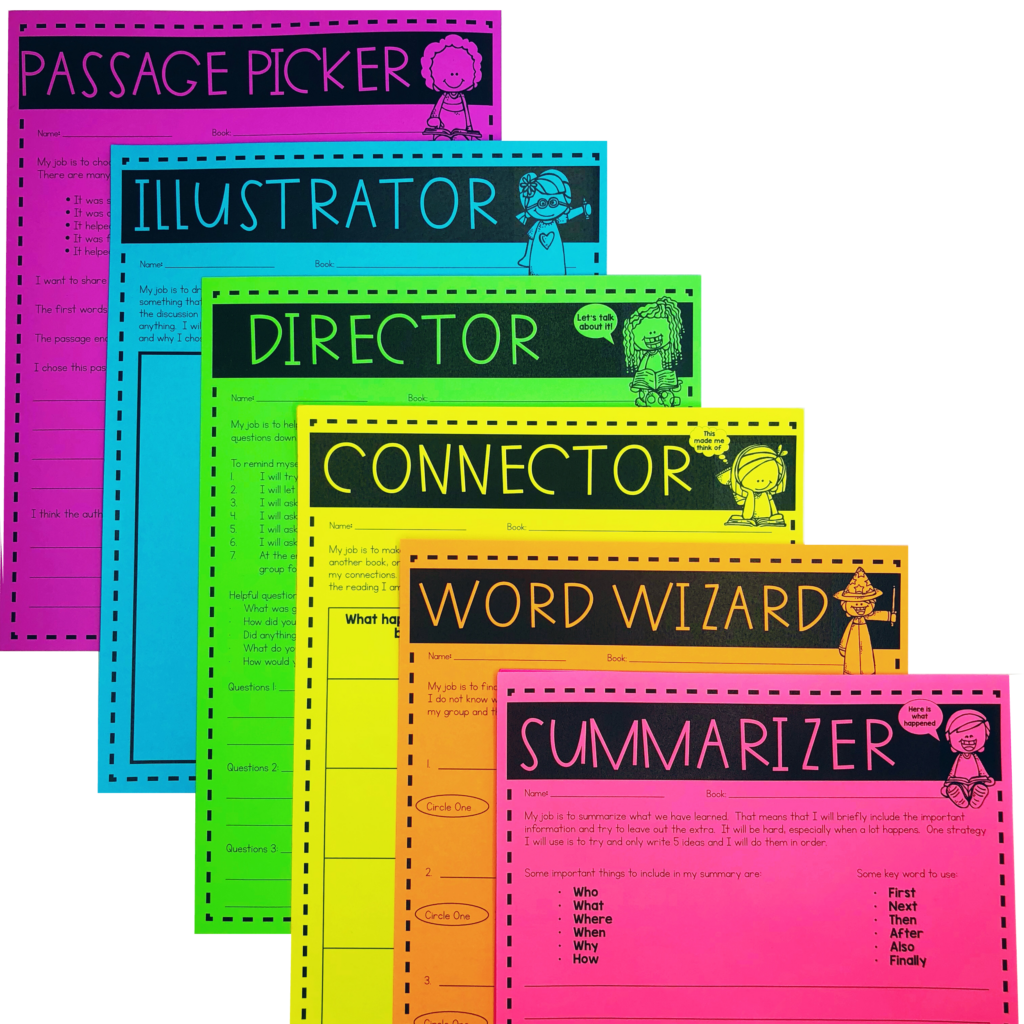
I also use these table tents to designate the different roles. This has two purposes:
- It helps all of the students in the group remember who is working through which role during that discussion.
- The back side of the table tent provides all of the necessary prompts and information for each role, so the student can use it as a helpful reference tool!
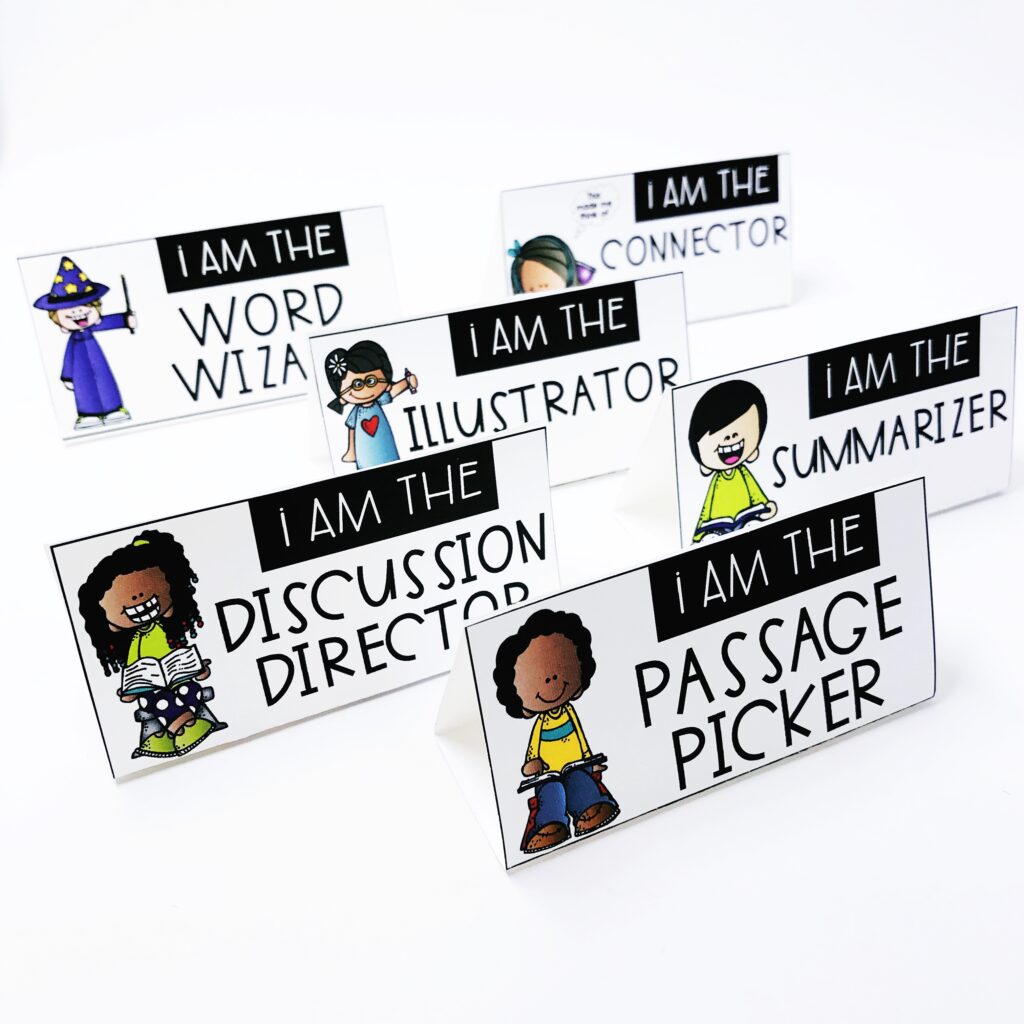
You can also find all of these resources HERE on Teachers Pay Teachers.
Still not sure? Check out this post sharing 5 Reasons to Try Literature Circles in Your Classroom!

More Favorite Resource
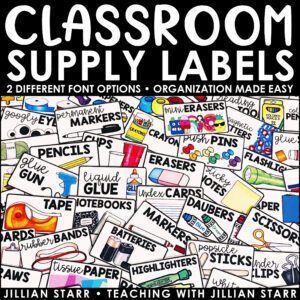
You May Also Enjoy These Posts:

Reader Interactions
Do you run your reading time like your guided math time? Do you meet with every group every day? When do the students complete the work? I think I saw that it was one of your reading station rotations. I completed your Guided Math Academy this summer and with the help of my campus math specialist, I have jumped in and am loving it! I’m trying to now wrap my head around if I can do the same method with reading. Letting go of the whole group focus on one story for the week is hurting my brain! Lol! I have been teaching for 17 years and it can be hard to let go of old habits.
Thank you for your feedback and your blog. You push me to be a better teacher.
Hi Elizabeth! Thank you so much for your kind words and to let me know that Guided Math Academy has helped your teaching! I run my reading groups similarly to my Guided Math groups. I do not meet with each group every day, just like with Guided Math. However, my students are working on a combination of differentiated word work/phonics, literature circles, reading response (essentially letters back and forth with me), and independent reading. This is in second and third grade. My first grade centers looked different because their early reading skills benefitted from a different focus. I hope this helps!
Hi Jillian! I really liked reading how you introduced literature circles with your students! I teach 6th grade and wondered if you think that this format of guided reading would work well with upper elementary/middle school-aged students? Thank you!
Hi Sarah! I think Literature Circles can work very well in upper grades. However, the roles become more complex and there is more responsibility given. I would not replace direct, small-group instruction with literature circles. Instead, they can be a wonderful practice that students engage in *while* you are providing direct instruction to another group. Does that make sense?
Thank you for replying! I will have to look at more information to learn more about literature circles in upper elementary. I like that the students would have more responsibility and be able to take ownership while growing their love for reading. I also, thank you for noting to keep small group instruction while the students complete their tasks on their own. This gives me a lot to consider for the next school year. Thanks again!
Leave a Comment
Your email address will not be published. Required fields are marked *
This site uses Akismet to reduce spam. Learn how your comment data is processed .
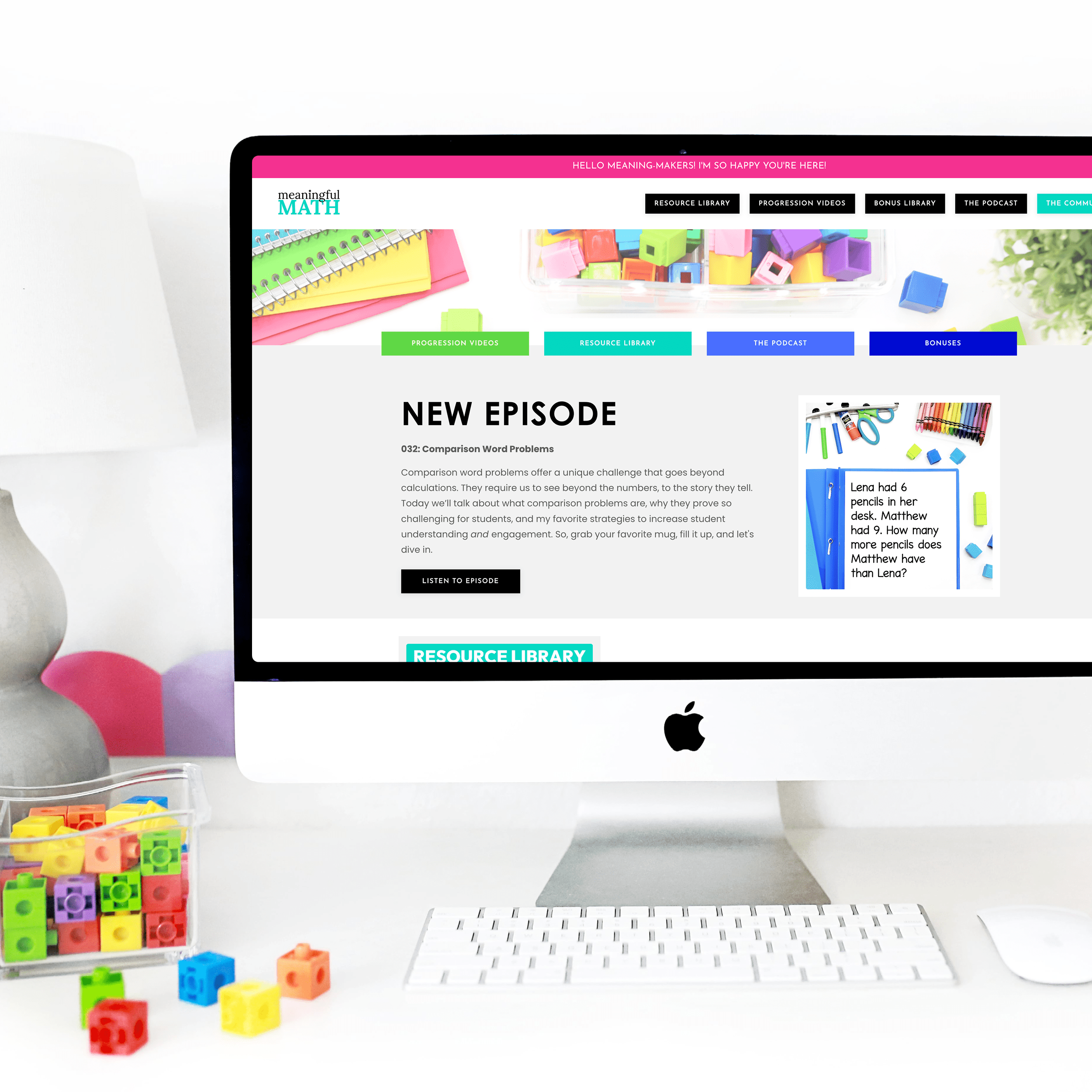
Ready to go deeper?
JOIN MEANINGFUL MATH

hello I'm Jillian
I’m so happy you’re here. I want every child to feel confident in their math abilities, and that happens when every teacher feels confident in their ability to teach math.
In my fifteen years of teaching, I sought every opportunity to learn more about teaching math. I wanted to know HOW students develop math concepts, just like I had been taught how students learn to read. I want every teacher to experience the same math transformation I did, and have the confidence to teach any student that steps foot in their classroom. I’m excited to be alongside you in your math journey!
Follow Me on Instagram!


High School Literature Circles: 7 Lessons After Almost 20 Years
- November 30, 2022
- AP Literature , Novels/Full Length Plays
The first group of students I used literature circles with was the class of 2005. They were tenth graders at the time. (And don’t tell my current classes, but this group of students is one of my favorites of all time.) Back then, Harvey Daniels’s notion of literature circles was pretty new. I followed all the “rules.” We used the standard roles in literature circles, students kept logs of their work and we had regular meetings. But the truth is, those roles for literature circles are not necessarily appropriate for our upper level students. So I want to share what I have learned after close to 20 years of experience using literature circles in high school English.

7 Things I’ve Learned after Nearly 20 Years Using Literature Circles in High School
One: roles in literature circles don’t make sense for upper level high school.
I love the concept of giving everyone a role, but the original roles like word finder and illustrator just don’t make sense for juniors and seniors in high school. At this point in their reading careers, they should all be doing the hard stuff. I like to give my students a little more discretion. Sometimes I ask everyone to do portions of a role, like have everyone bring 2-3 quotes that stood out or have them consider something about the protagonist. But for the most part, I don’t bother.
The truth is that upper level high school student who have selected a book they are interested in reading can navigate a really good discussion without our interference and micro-managing.
Two: Set a Consistent Schedule
When my students are working on a book club unit in high school English, I like to let them know the schedule ahead of time. We generally have a specific day that is for book club meetings (Friday) along with designated days for reading (Monday) and full class lessons (Tuesday, Wednesday, Thursday).

Three: Literature Circle Mini Lessons are Integral
The only way to make literature circles truly relevant in high school English is to use literature circle mini lessons. My favorite way to do this in AP® Literature is with How to Read Literature Like a Professor . We read specific chapters that I want to highlight and then practice with short stories or poetry. Then students apply it to their independent novels. We call it Reading Like a Professor.
You could do the same thing with literary criticism lenses. Do a mini lesson on a literary lens like Reader Response or Ethical Criticism . Practice as a class with a short story and then have them apply it to their book club books. You could even use task cards to give the student focus in their meetings.
Four: Ground Literature Circles in the Essential Skills
Since high school English is a skills based course, decide which skills that you want students to be able to show you and then establish your activities based around those skills.
If you want students to practice close reading, have them pick their own close reading passages. Then give them guidelines for the reading of those passages. Or, better yet, let them establish their own guidelines based on what you have use earlier in the year.
Five: Make Choice Integral
Choice makes our students want to engage, so go beyond just the choice of the books. Let them choose how to run their book club meetings and give them opportunities to pick how they will demonstrate their understandings. Using Reader Response prompts or task cards is a great way to do this.

Six: Use Quick Assessments Throughout the Unit
It’s easy to check to see who is reading and who is not with quick assignments throughout the unit. I like to use a combination of choice boards, 3 2 1 Assignments ( for how to use this strategy, click here ) and hexagonal thinking to see what the students are getting from their books.
Choice boards are perfect to check the individual, but you can use the 3 2 1 strategy as discussion prep, discussion notes or tickets out. This makes 3 2 1 strategy ideal throughout the unit. I recently used the 3 2 1 both to check students’ individual understanding of characterization and then used them again later in the week to have student record their book club meetings. For 15 ready to use 3 2 1 Strategy Sheets to use with any text, click here .
Hexagonal thinking is a perfect way to get the groups talking and thinking about connections in the text together. We used this in my classes the day before the essay. It gave students an opportunity to talk about the ends of their books while also making the big connections to theme, characterization and more. (And it also made it pretty clear who was behind in their reading.)
Seven: Finish with an Essay
No matter what you do throughout the literature circle unit, in the upper levels of high school, you need to finish up with an essay (or an alternative to the essay ). This gives you the opportunity to fully assess the individual student’s understand (or lack there of) of the novel they read.
I still love to offer choice even in the essay at the end of the unit. I usually provide three or four prompts for an AP® style literary argument, but you could also give the students a prose style prompt that practice the skills you have been working on throughout the unit (that way students who didn’t finish are not called out). You could also have student use stable prompt language to write their own prompts and then answer them.

Unpopular Opinions about Literature Circles in High School English
I would love to know what you think about using literature circle in high school. Do you use the old school, Harvey Daniels roles in literature circles or have you branched out as well? Let me know in the comments.
And if you haven’t used literature circles in a while because those roles for literature circles seemed a little too, well, elementary, then I hope that you will consider giving your more mature students some freedoms.
Related Resources
3 2 1 Strategy for High School English
Teaching High School Students How to Write Reader Response
Alternatives to the Essay
6 Ways to Include Poetry in Your Next Novel Unit (Smith Teaches 9 to 12)
Teaching Students How to Write Literary Analysis Paper in Six Easy Steps (The Teacher Rewrite)
Shop This Post
Reading Like a Professor Book Clubs for AP Literature
Reader Response Anchor Charts and Task Cards
Ethical Criticism Anchor Charts and Task Cards
Fifteen 3 2 1 for Any Text
more from the blog

The AP English Exam is Over–What’s Next?
It’s almost May, which means those of us who teach AP® English are wrapping up in preparation for the exams. It doesn’t matter whether that

Bell Ringer Ideas for High School English
The moment our students walk in the classroom, we need to make sure that they get to work. The quicker they get to work, the

Teaching Allusion in Literature in High School English
Only a few years ago, I could count on that one kid to recognize the allusions in literature that we would encounter in our shared
Leave a Reply Cancel reply
Your email address will not be published. Required fields are marked *
Save my name, email, and website in this browser for the next time I comment.

Hi, I'm Jeanmarie!
I help AP Literature and High School English teachers create engaging classrooms so that students will be prepared college and beyond.
Learn more about me and how I can help you here
Let's Connect!

Your free guide to planning a full year of AP Literature

AP® is a trademark registered by the College Board, which is not affiliated with, and does not endorse, this product.
Tips for Successful Literature Circles
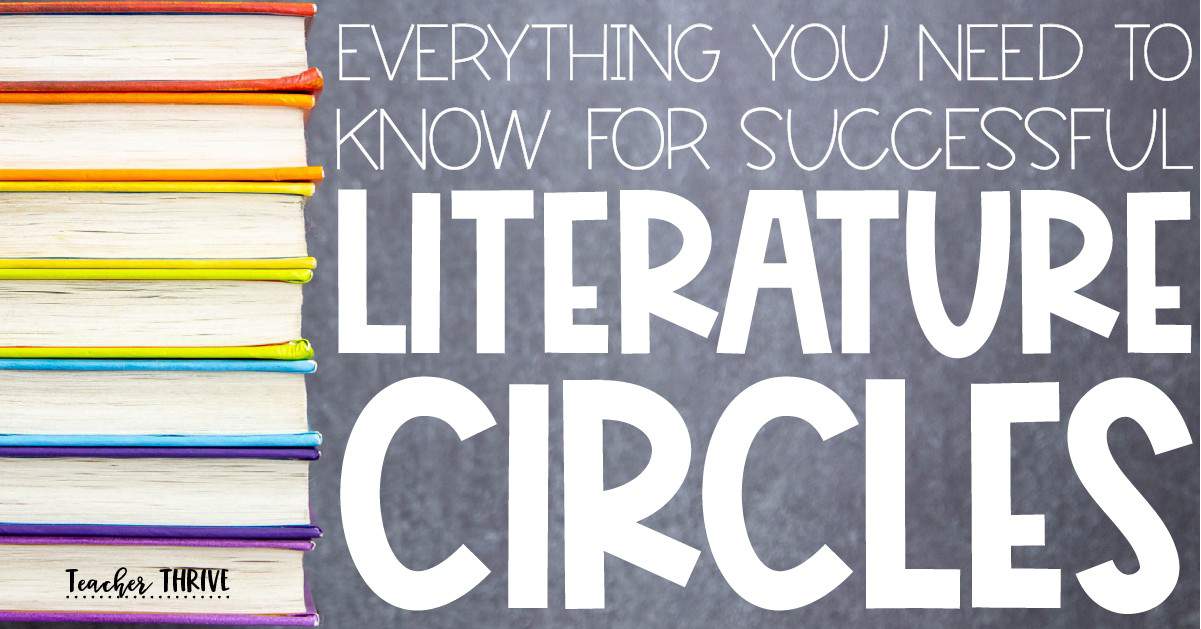
Literature circles are one of the best ways to engage readers and activate critical thinking. In literature circles (sometimes referred to as “book clubs”), small groups of students meet to discuss a piece of literature circle in depth. These meetings are student-led; the teacher is simply a facilitator, establishing roles, behavioral expectations, and schedules.
Establish Literature Circle Roles
Ideally, each group should consist of seven members—one member for each of the seven roles. Here are the roles that I use and a basic description of each, but there are several variations of roles that you can create to fit your needs.
- “Discussion Director” – creates a list of questions to ask the group during the meeting
- “Connector” – makes text-to-text, text-to-self, and text-to-world connections
- “Vocabulary Enricher” – scouts out important or interesting words
- “Literary Luminary” – finds interesting or important excerpts to read aloud to the group
- “Investigator” – does a little research on a related topic from the book to share with the group members
- “Plot Profiler” – track and describe the plot elements of the reading selection
- “Illustrator” – create a visual that represents the reading selection
You must clearly communicate the responsibilities of each role to the students. Consider creating job cards for each role that goes beyond the general descriptions from above. Job cards should include specific duties you are expecting the students to perform.
Students rotate jobs, so (eventually) each student gets an opportunity to assume every role. A rotation schedule will vary depending on how often your students meet and how long the book is (more on scheduling coming up). If students are participating in a literature circle for the very first time, I recommend waiting for two meetings before rotating jobs. This allows students two opportunities to learn a particular role. Even if students are not able to rotate through all the roles during one book, I still recommend they complete a role twice before moving on. When they start a new book, they can then move on to a role they have yet to try. Once students are familiar with literature circles, you can rotate jobs after each meeting.
Creating Groups and Selecting Books
Homogenous groups:.
Typically, literature circles are comprised of students who share similar reading levels. This allows teachers to select books at different levels depending on the group members. Since students are reading independently in literature circles, you will need to choose books that are at students’ independent reading level.
Heterogeneous Groups:
You can create literature circles with students at varying reading levels. However, I don’t recommend starting with heterogeneous groups. Students must first learn how literature circles work and what each of the roles entails. It is much easier for students to begin literature circles in homogenous groups using appropriate leveled books.
Do not create heterogeneous groups that are too varied in ability level. Avoid extremes in regards to reading levels (i.e., Your very highest reader should not be in a group with a reader who is performing at the bottom 10th percentile of your class).
When conducting literature circles with heterogeneous groups, all groups should be reading the same text (e.g., a grade-level book used for a novel study). This will make it easier for teachers to provide support to students reading below grade level.
Regardless of which type of groups you use, each student will need his/her own copy of the book.
Setting Up a Literature Circle Schedule
Scheduling literature circles is very flexible. There is not one set schedule that will work for all teachers, students, and books. How often students meet and how long a literature circle lasts all depends on the length and level of the book. Teachers may also alter the schedule to fit around their instructional minutes and other time commitments. It is ideal for students to meet at least twice a week, but if your schedule only permits once a week, that is fine.
Steps for Creating a Schedule:
- Students should be given at least 20-25 minutes to meet for a literature circle meeting. Take a look at your schedule and determine if you can allow for two meetings or one meeting per week. Once you determine the number of weekly meetings you can hold, move to step 2. Avoid having meetings on consecutive days, as this may not allow students enough time to complete the next assignment.
- Decide on how long you would like students to focus on one book (e.g., three weeks, five weeks…?). Again, this time period can vary depending on your answer to number 1 and the length of a book. You don’t want to choose too short of a duration, especially for more complex or lengthy books. However, you also don’t want to spread out the book too much, or else students may lose interest, and they won’t have much to discuss during their meetings. A typical round (completion of one book) of literature circles usually lasts around four weeks, but this is not an absolute for all situations.
- Now that you know how many weekly sessions you will hold and about how many weeks you would like to spend on a book, divide the books accordingly. For example, 2 weekly sessions x 5 weeks = 10 sections of the book. You can divide the book into 10 equal sessions, but if you are very familiar with a book, you may decide to create the sections based on the plot.
- Now you can schedule out meetings and reading assignments (sections from step 3).
Remember, you can change your schedule and text sections at any time! If students cannot complete their reading assignments, then break the book down into smaller parts and extend the duration of the literature circles a week or two.
Conducting Literature Circle Meetings:
Pre-meeting set up.
- Clearly communicate what you expect from students during a meeting. Consider providing a rubric that covers the areas of “job completion,” “reading” (Did the student read the selection?), and “discussion.” Make sure your rubric contains specific examples of expected behavior (i.e., “Responses are meaningful, relevant and supported with evidence from the text.” or “Makes enthusiastic contributions to the group discussion.”) THINK: What behaviors do I want to see when I am observing my students in their literature circles?
- Give each student very specific tasks that relate to their job. This can be in the form of a graphic organizer or question stems. Also, make sure that each student has a “role card” that includes a general description of his/her job and duties he/she is expected to complete.
- Share the literature circle schedule you created with each group. Make sure they know what sections are assigned for each meeting and what days the meetings will take place.
During the Meeting
- Visit with each of the groups at least once during the meeting. Make sure to bring your rubric to take notes if needed.
- Direct and redirect students as needed. During the first meeting, students will need a lot of your input and guidance. As the weeks progress, you’ll be more of an observer.
After the Meeting
Spend a few minutes with your entire class reflecting on how the literature circles went. This will allow you to determine common issues that may need your attention. Ask your students:
- What went well?
- What was a challenge?
- How can we solve this challenge?
- What areas of the rubric did they perform well on? What areas need some work?
Assessing Literature Circles
Use the rubric you created to assess students’ performance in their literature circle meetings. You may need to complete the rubric for students often when first starting out. However, once they learn what you expect, you won’t need to assess them as frequently.
Consider giving students rubrics so they can assess their group members as well.
Depth and Complexity Literature Circles
If you’d like to get started right away, check out my Depth and Complexity Literature Circles. This resource includes everything you need–just choose the books and set up a schedule!
- 7 role graphic organizers with explicit prompts and tasks to guide students through the process
- Detailed job descriptions for each role
- A detailed rubric to assess Literature Circle performance.

- Depth and Complexity
- End of the School Year
- Reading Comprehension
- Reading Fluency
- Uncategorized

LATEST ON INSTAGRAM
- Stary Oskol Tourism
- Stary Oskol Hotels
- Stary Oskol Bed and Breakfast
- Flights to Stary Oskol
- Stary Oskol Restaurants
- Things to Do in Stary Oskol
- Stary Oskol Travel Forum
- Stary Oskol Photos
- Stary Oskol Map
- All Stary Oskol Hotels
- Stary Oskol Hotel Deals
- Stary Oskol Hostels
- Stary Oskol Business Hotels
- Stary Oskol Family Hotels
- 5-stars Hotels in Stary Oskol
- 4-stars Hotels in Stary Oskol
- Stary Oskol Hotels with Pools
- Stary Oskol
- Things to Do
- Restaurants
- Vacation Rentals
- Travel Stories
- Rental Cars
- Add a Place
- Travel Forum
- Travelers' Choice
- Help Center
Photos of Stary Oskol - Featured Images
- Europe
- Russia
- Central Russia
- Belgorod Oblast
- Stary Oskol
- Stary Oskol Pictures
Information
Find all the information of Stary Oskol or click on the section of your choice in the left menu.
- Update data
Stary Oskol Demography
Information on the people and the population of Stary Oskol.
Stary Oskol Geography
Geographic Information regarding City of Stary Oskol .
Stary Oskol Distance
Distance (in kilometers) between Stary Oskol and the biggest cities of Russia.
Stary Oskol Map
Locate simply the city of Stary Oskol through the card, map and satellite image of the city.
Stary Oskol Nearby cities and villages
Stary oskol twin towns, sister cities.
The City of Stary Oskol has international agreements with its different pairings.
Stary Oskol Zone
Time zone of Stary Oskol.
Stary Oskol Weather
Weather forecast for the next coming days and current time of Stary Oskol.
Stary Oskol Sunrise and sunset
Find below the times of sunrise and sunset calculated 7 days to Stary Oskol.
Stary Oskol Hotel
Our team has selected for you a list of hotel in Stary Oskol classified by value for money. Book your hotel room at the best price.
Stary Oskol Nearby
Below is a list of activities and point of interest in Stary Oskol and its surroundings.
Nuclear power plant
Stary oskol page.

- Information /Russian-Federation--Belgorod--Stary-Oskol#info
- Demography /Russian-Federation--Belgorod--Stary-Oskol#demo
- Geography /Russian-Federation--Belgorod--Stary-Oskol#geo
- Distance /Russian-Federation--Belgorod--Stary-Oskol#dist1
- Map /Russian-Federation--Belgorod--Stary-Oskol#map
- Nearby cities and villages /Russian-Federation--Belgorod--Stary-Oskol#dist2
- Twin towns, Sister cities /Russian-Federation--Belgorod--Stary-Oskol#twintown
- Zone /Russian-Federation--Belgorod--Stary-Oskol#hour
- Weather /Russian-Federation--Belgorod--Stary-Oskol#weather
- Sunrise and sunset /Russian-Federation--Belgorod--Stary-Oskol#sun
- Hotel /Russian-Federation--Belgorod--Stary-Oskol#hotel
- Nearby /Russian-Federation--Belgorod--Stary-Oskol#around
- Page /Russian-Federation--Belgorod--Stary-Oskol#page
- Terms of Use
- Copyright © 2024 DB-City - All rights reserved
- Change Ad Consent Do not sell my data

IMAGES
VIDEO
COMMENTS
The group grade can be based on group assignments and activities from literature circle meetings. You can use the group grade as the basis for adjusting individual grades for each student. These adjustments can be based on their performance during their literature circle roles. It can also include peer feedback from peer evaluation forms.
CCSS.ELA-LITERACY.CCRA.R.6: Assess how point of view or purpose shapes the content and style of a text. 7. Literary Postcards. Literary postcards are a great writing activity to reinforce the ideas of character and point of view in any novel or short story and can be used with any grade level.
Overview. This lesson provides a basic introduction to literature circles, a collaborative and student-centered reading strategy. Students begin by selecting a book together then are introduced to the four jobs in the Literature Circles: Discussion Director, Literary Luminary, Vocabulary Enricher, and Checker. The teacher and student volunteers ...
Free Literature Circle Printables. Literature Circles are a fun and effective way to get kids excited about reading, and they are aligned with Common Core State Standards for Speaking and Listening. Browse this collection of printables to use with your Literature Circle activities. If you're interested in learning about an easy method of ...
Literature circles tend to be more structured with a focus on an academic outcome than book clubs. In a literature circle unit, students may only have three or four novels to choose from. ... One less structured method could be to have all students working on the same assignments but responding with content from the novel they chose.
A literature circle is part of a balanced literacy program where a small group of students meet to have an in-depth discussion about a text they are currently reading. These weekly meetings are primarily student-led, with students responding to the text and other readers critically. ... All assignments for their role are completed. They have ...
Literature circles are not just about reading and discussing in student led groups, teacher led groups, or online.They are also an opportunity to review old skills and introduce new ones. Opting to use mostly skill based activities (i.e activities that focus on conflict or character) rather than text based activities (i.e. activities that are specific to a certain book) allows all students to ...
What is the purpose of a Literature Circle? Engagement! Students are assigned (or may choose) rotating roles to supplement the reading assignment. The roles are designed to give each student a way to engage with the text and have talking points for discussion. Literature Circles build community, foster critical thinking skills, and lay ...
Here are my typical literature circle assignments: Word investigator (first assignment - info above) Characters - Name and description of characters. Visualize - Draw setting, characters and events. Predictions - write what you think will happen. This typically comes after students read a chapter involving the problem.
Literature circles are small groups of students who meet to discuss the same book. The discussion guides students to a deeper understanding of the text. With the right modifications, we can implement literature circles in all grade levels. Woah - groups of kids talking together during classtime. Sounds like it could get out of hand very quickly.
The Bookmarks lend themselves well to literature circle reading assignments or Classroom book clubs. Within the bookmarks, I've included strategy focused boxed activities. These boxes and the text within them can all be moved, manipulated, and edited to your own classroom needs. I've created these to be either printed double or single-sided.
Give students a copy of the Literature Circle Role Descriptions. Make one Role Finder Dial per team. Assign each person on the team one role and have them prepare their assignment as described. On the day of the meeting, all students complete their worksheet during the meeting itself. For the next meeting, turn the dial one place to see the new ...
For 4th and 5th grade, students get to go "book shopping" and select their books and we begin literature circles. We begin with a pre-reading activity to get students excited about their books ("Book Cover of Predictions" activity is my favorite). Once groups have their books selected, I pre-plan out the pace of reading for each lit ...
Literature circles are small groups of students, usually 4-6, that meet weekly to discuss a book. Similar to book clubs, the small groups read a book at the same pace and use skills that they learned in guided reading to analyze the book. Students are given literature circle roles to practice their reading comprehension skills.
Encourage reflection. After the students finish their circle, have them write about what they thought of the discussion. For younger students, it can be a few sentences. For older students, it can be a stream-of-consciousness-style journal entry. Assign a project.
The role of the Word Wizard in Literature Circles is to draw our attention to the vocabulary within the text. I explain that students can choose words for a variety of reasons: They cannot read the word. They don't know what the word means. They think it was a great word choice/juicy word. Other.
Four: Ground Literature Circles in the Essential Skills. Since high school English is a skills based course, decide which skills that you want students to be able to show you and then establish your activities based around those skills. If you want students to practice close reading, have them pick their own close reading passages.
Literature circles are one of the best ways to engage readers and activate critical thinking. In literature circles (sometimes referred to as "book clubs"), small groups of students meet to discuss a piece of literature circle in depth. ... If students cannot complete their reading assignments, then break the book down into smaller parts ...
Before you begin, here are some general guidelines for setting up literature circles in your classroom. These guidelines apply across grade levels. When you're ready to see specific examples of structure from grade levels similar to yours, click on either "Primary" or "Intermediate/Middle School" classroom examples below. Seeing the Big Picture:
3 reviews. #1 of 3 lodges in Stary Oskol. Location. 3.0. Service. 3.0. The hotel can accommodate up to 100 people and offer rooms in different price categories and the placement. A hotel room is a comfortable apartment consisting of separate rooms (one to four) with kitchenette, private bathroom fully equipped with appliances. Breakfast is ...
Cleanliness. 4.7. Service. 4.0. Value. 4.3. Welcome to Grand Hotel, your Stary Oskol "home away from home.". Grand Hotel aims to make your visit as relaxing and enjoyable as possible, which is why so many guests continue to come back year after year. For those interested in checking out popular landmarks while visiting Stary Oskol, Grand ...
1-6 of 1,118. Stary Oskol pictures: Check out Tripadvisor members' 1,118 candid photos and videos of landmarks, hotels, and attractions in Stary Oskol.
Geographic Information regarding City of Stary Oskol. Stary Oskol Geographical coordinates. Latitude: 51.3, Longitude: 37.8333. 51° 18′ 0″ North, 37° 49′ 60″ East. Stary Oskol Area. 19,900 hectares. 199.00 km² (76.83 sq mi) Stary Oskol Altitude.